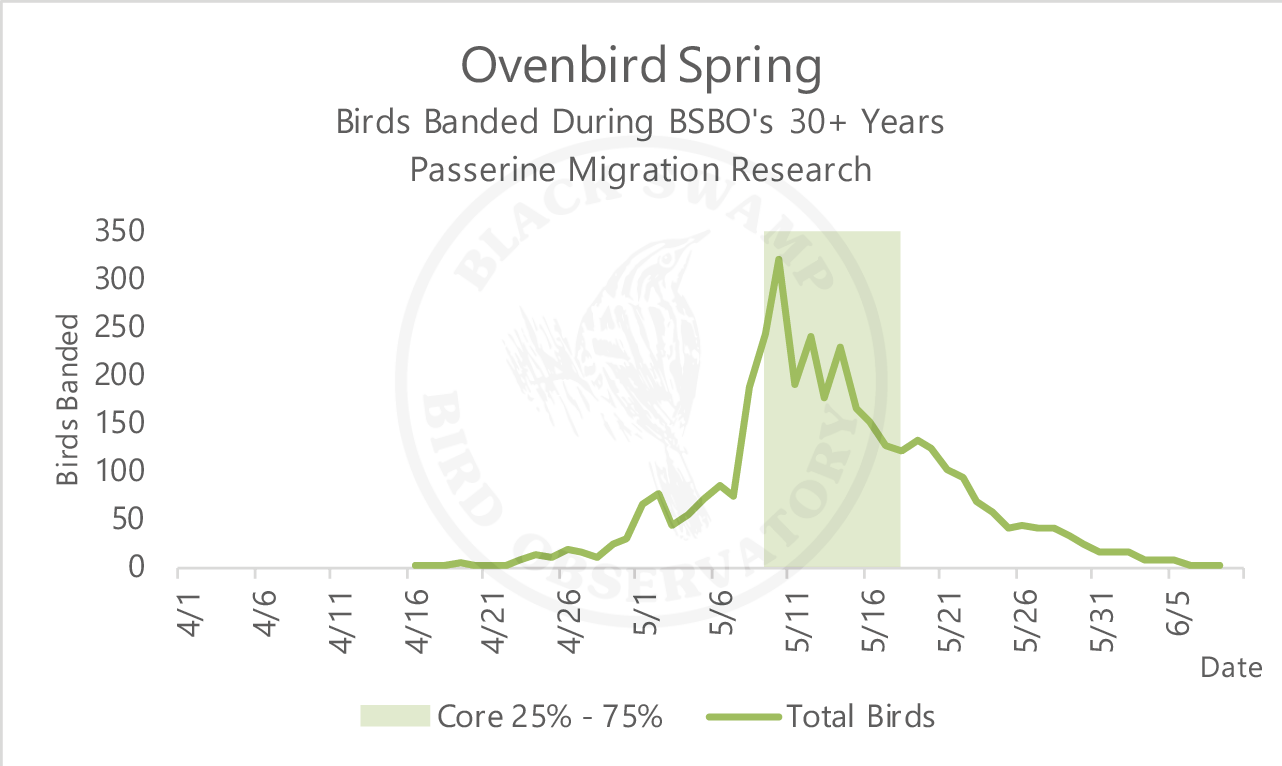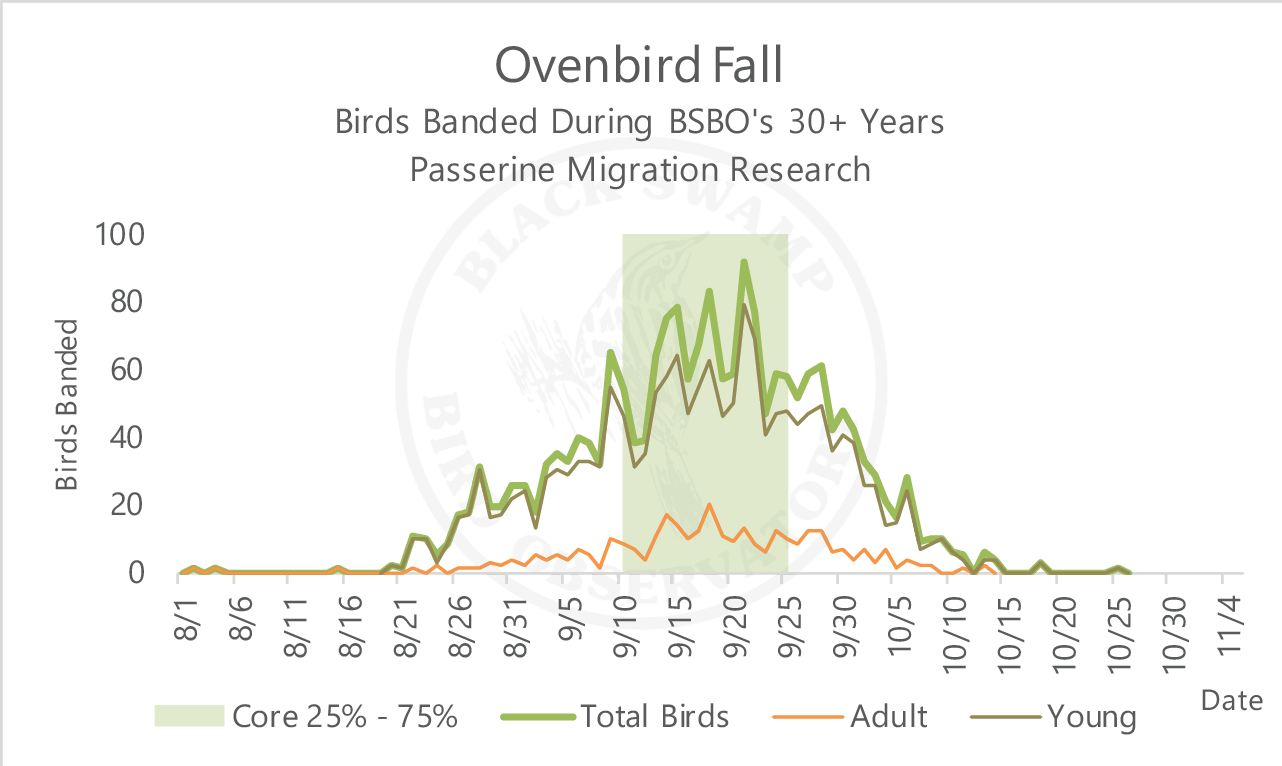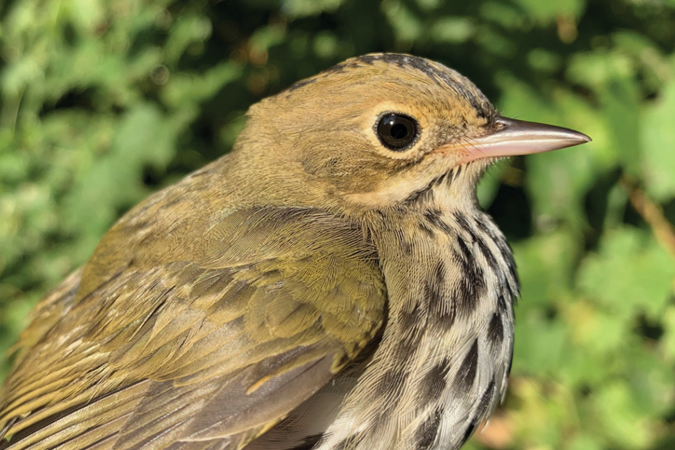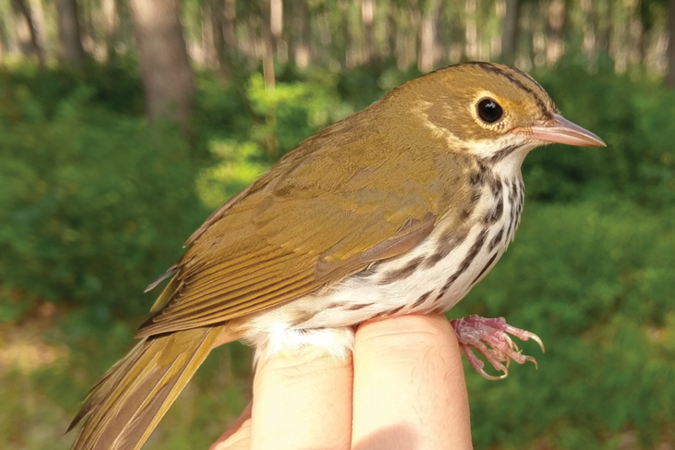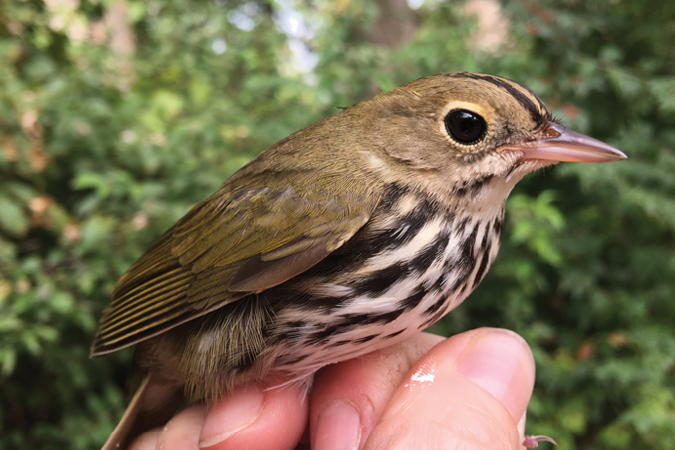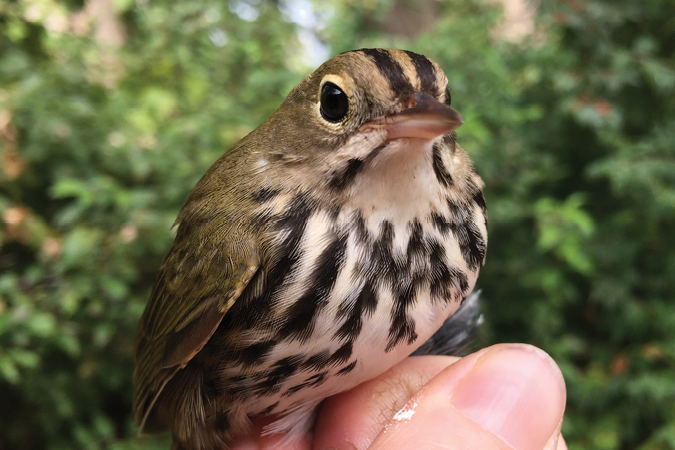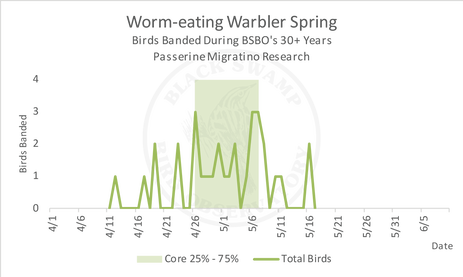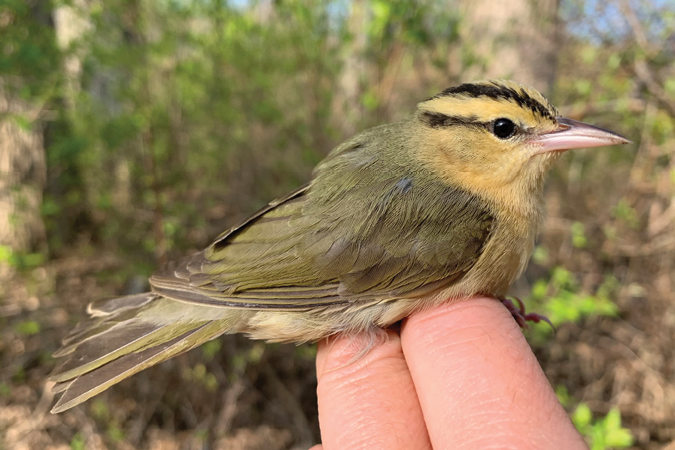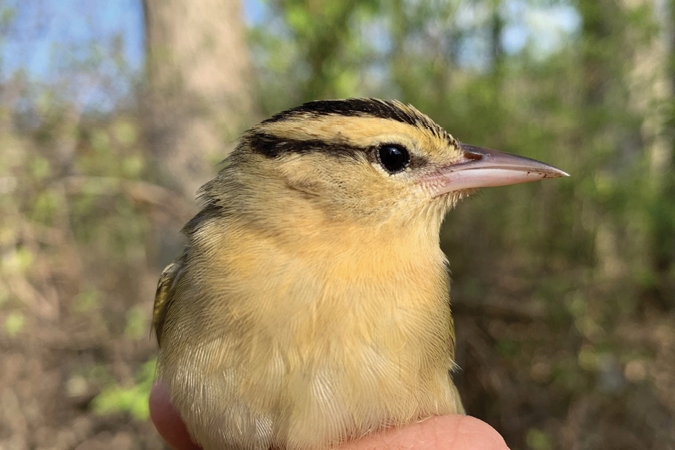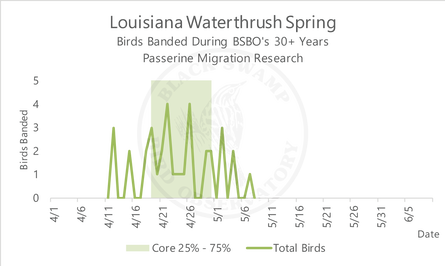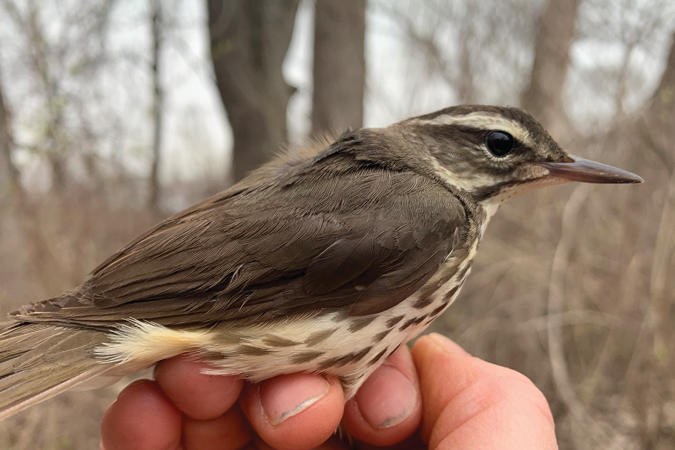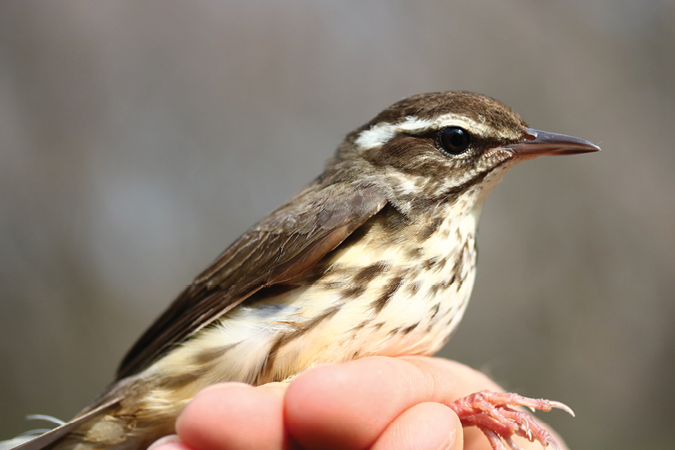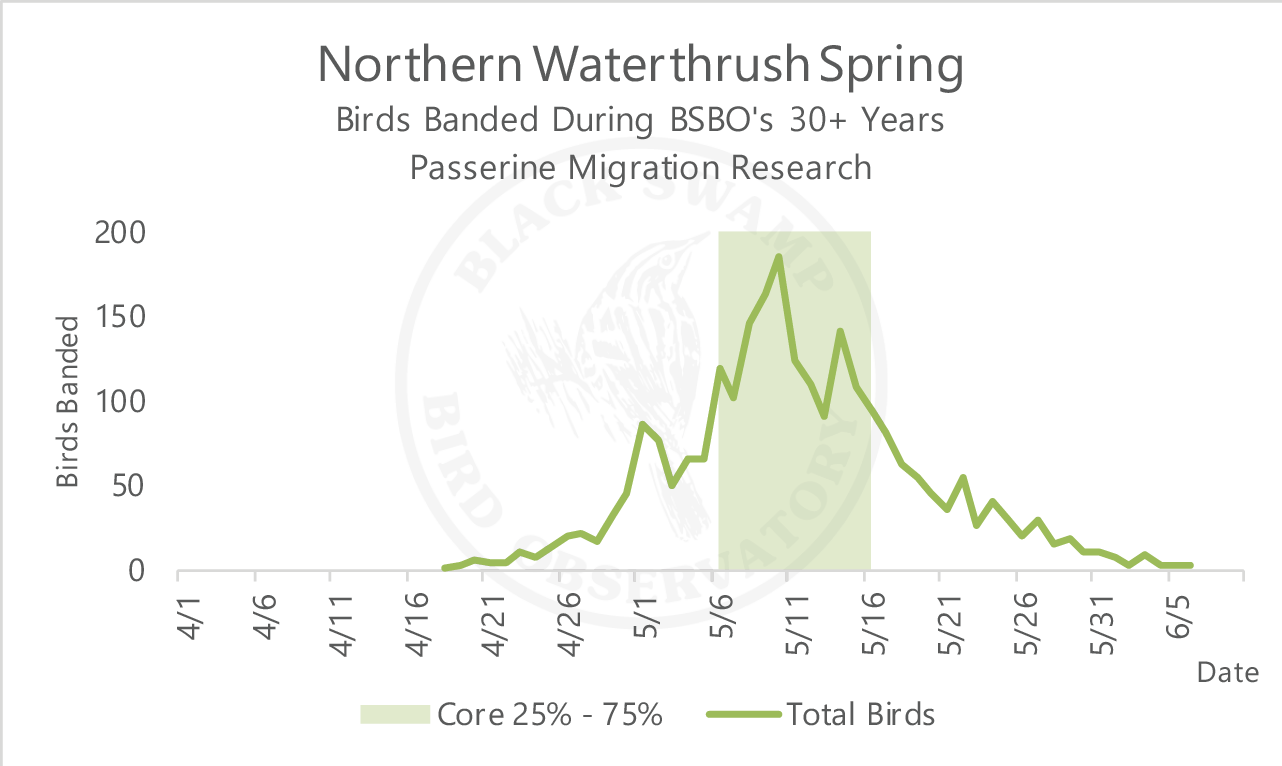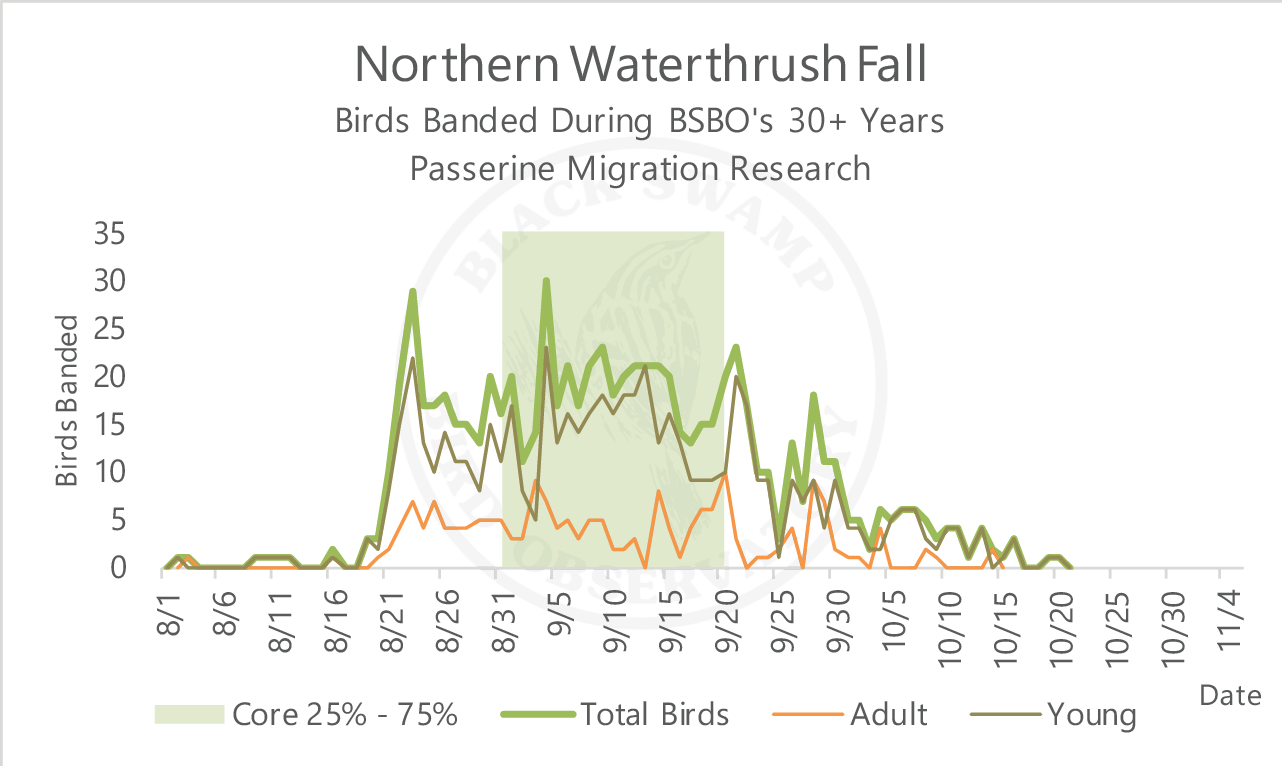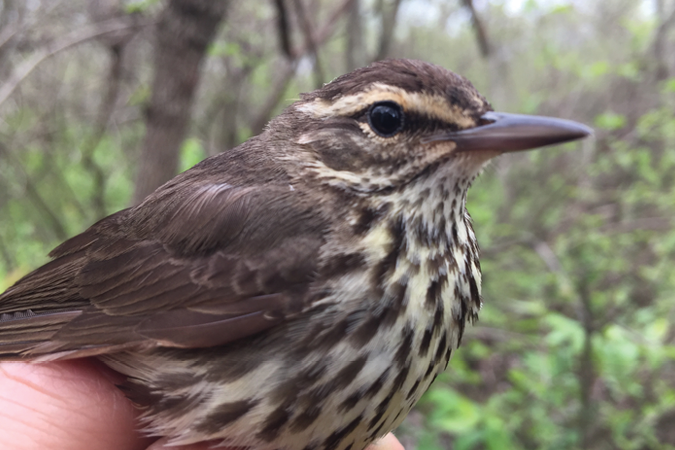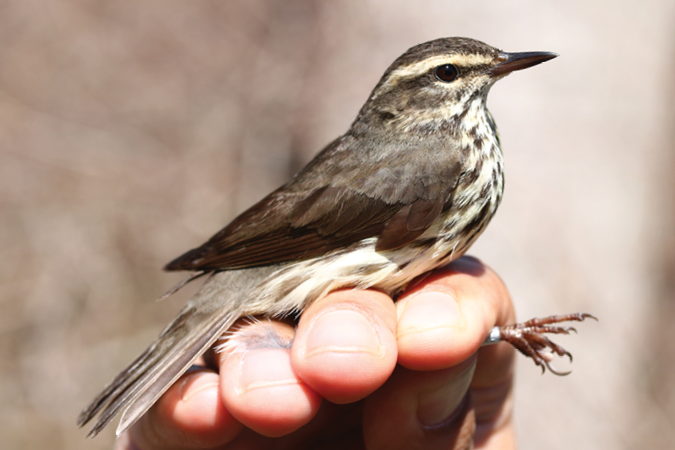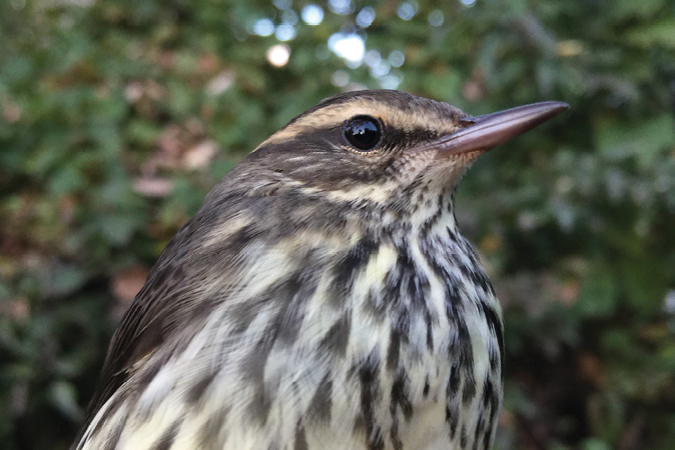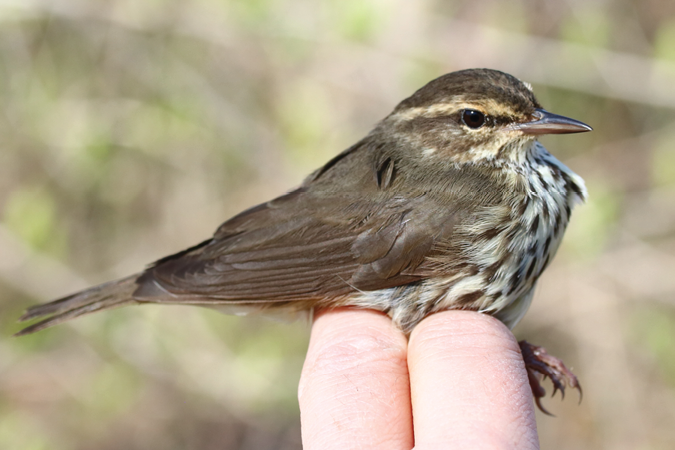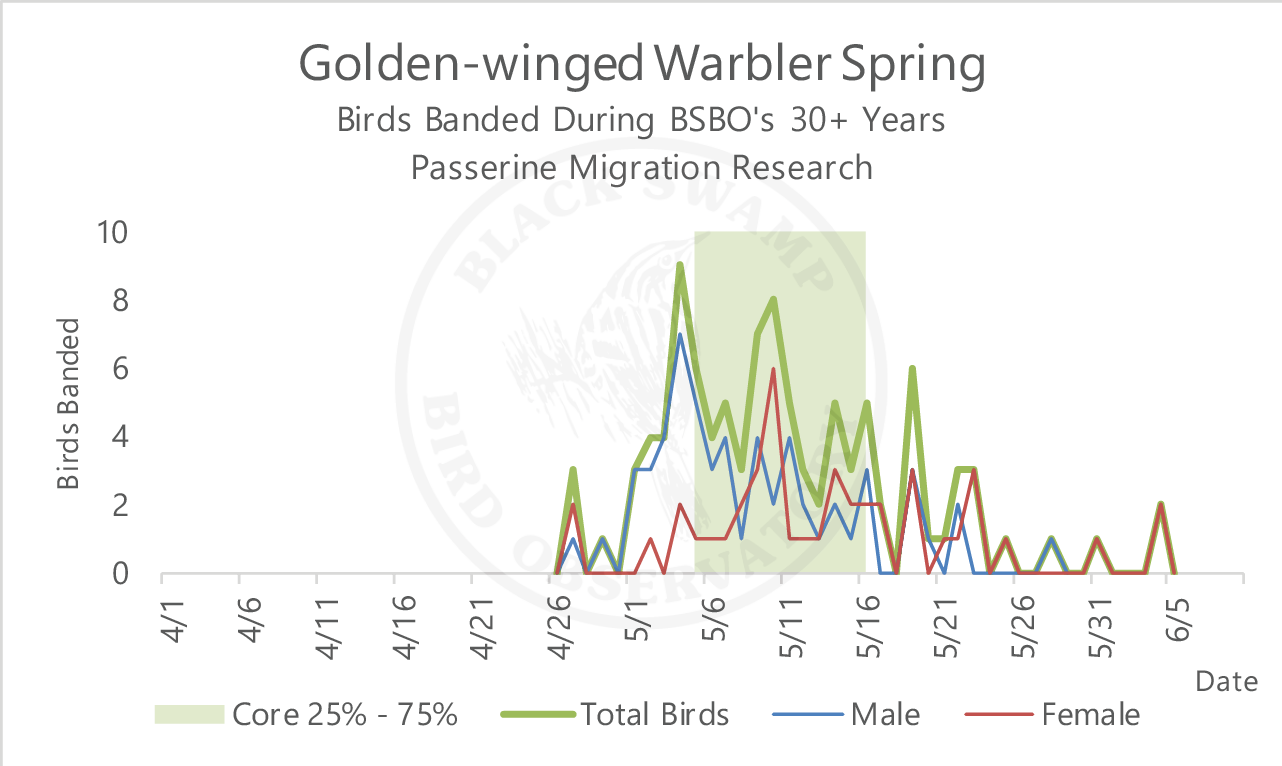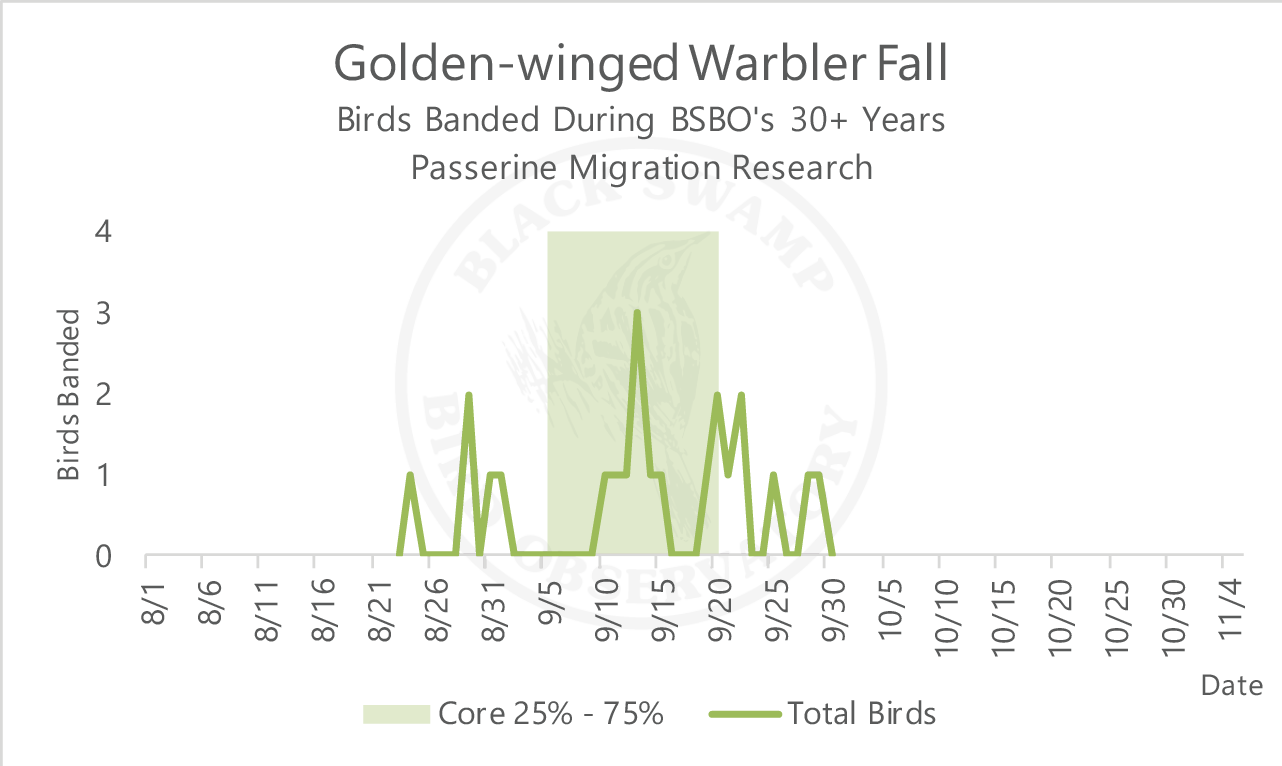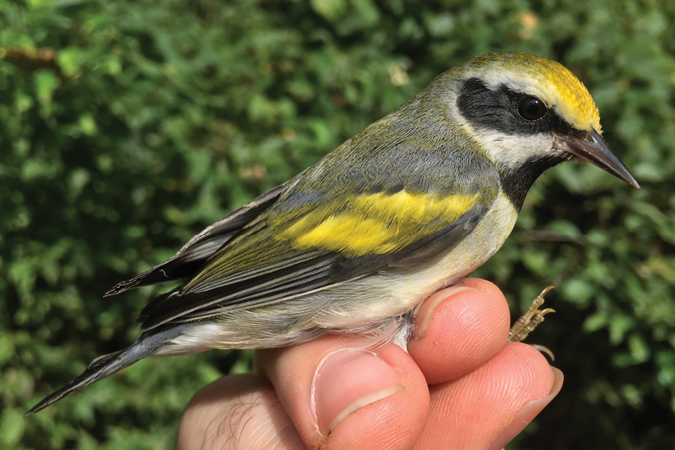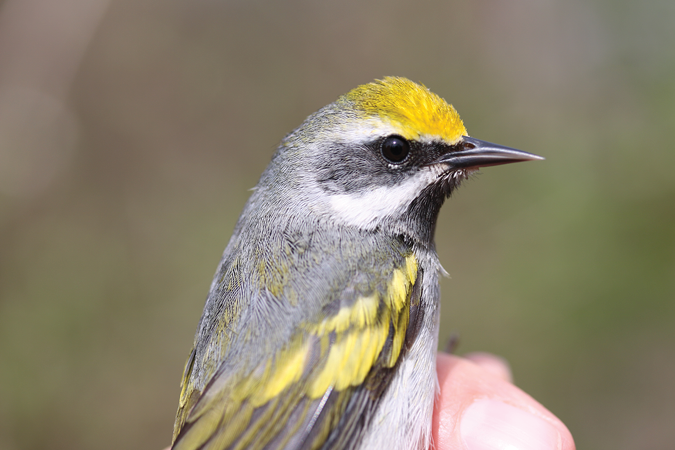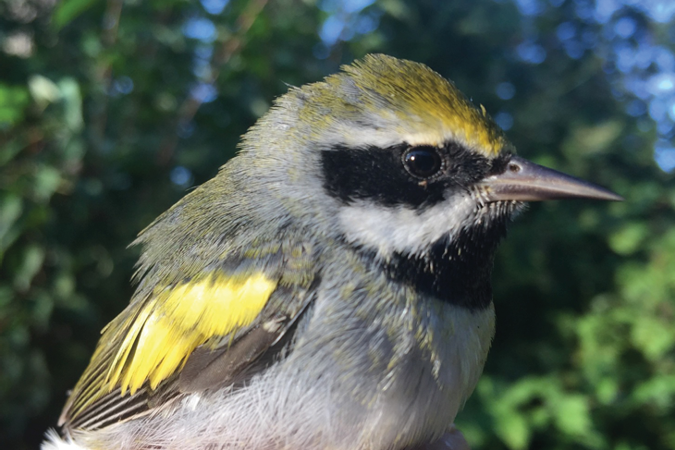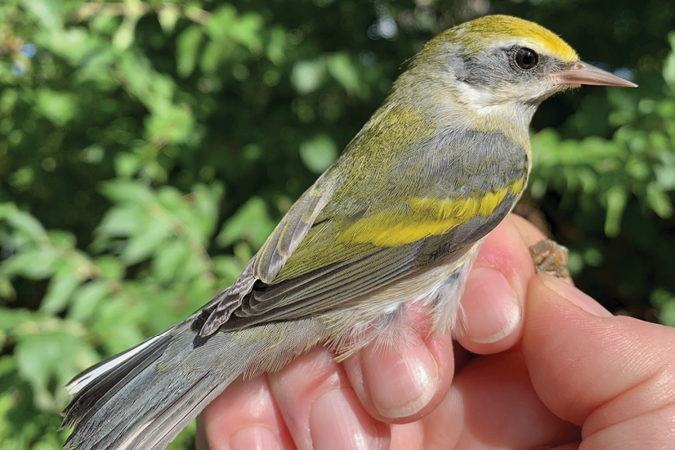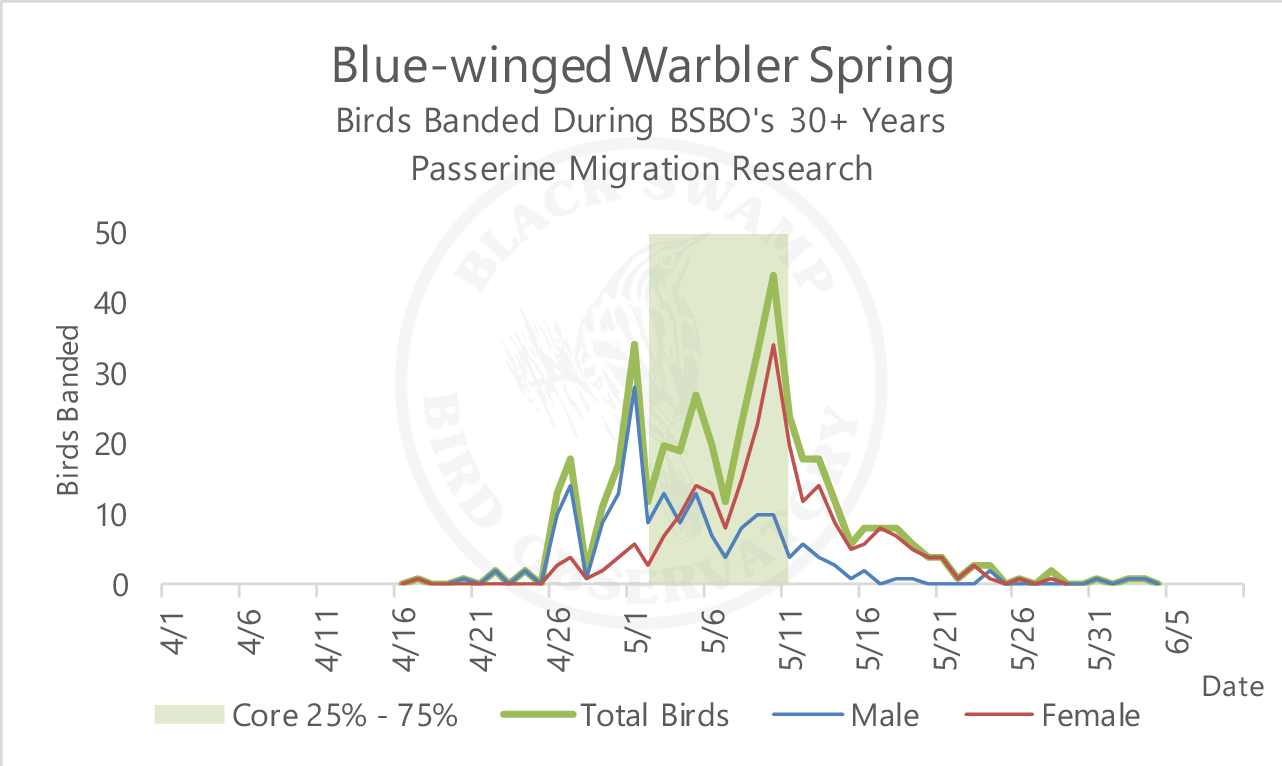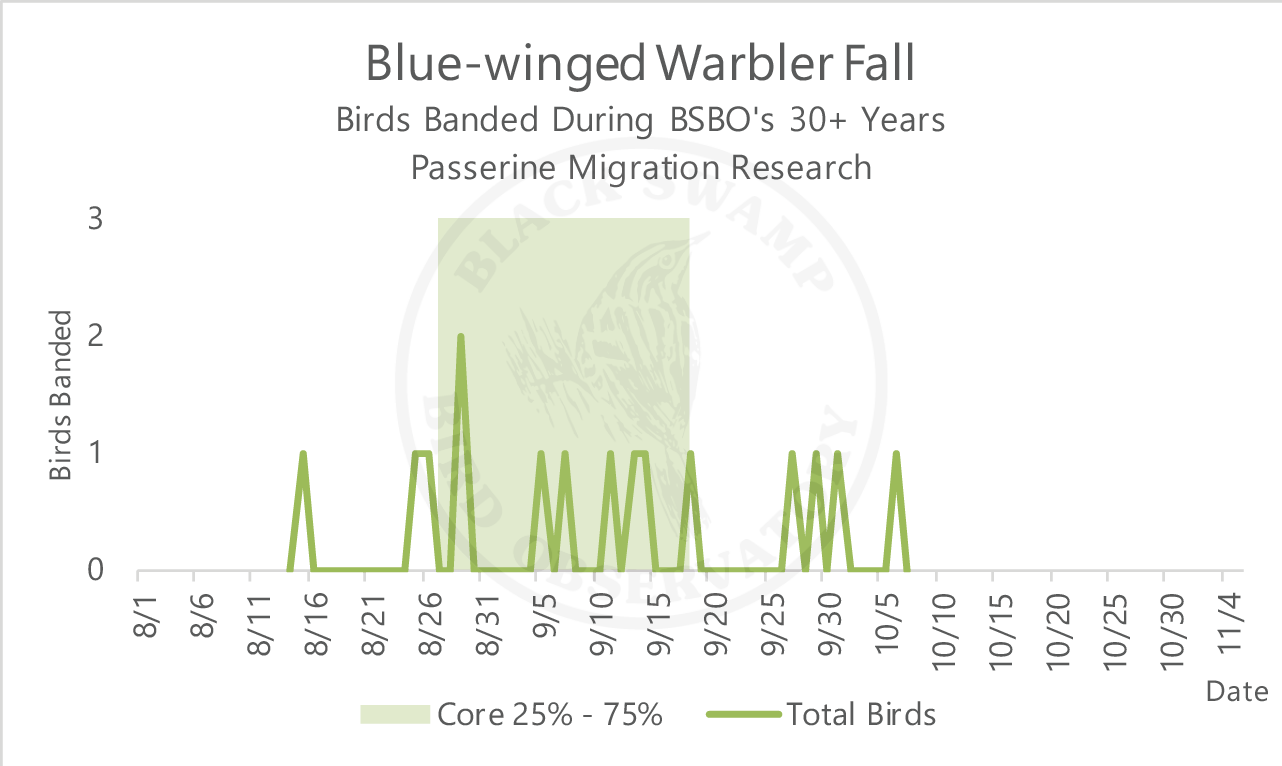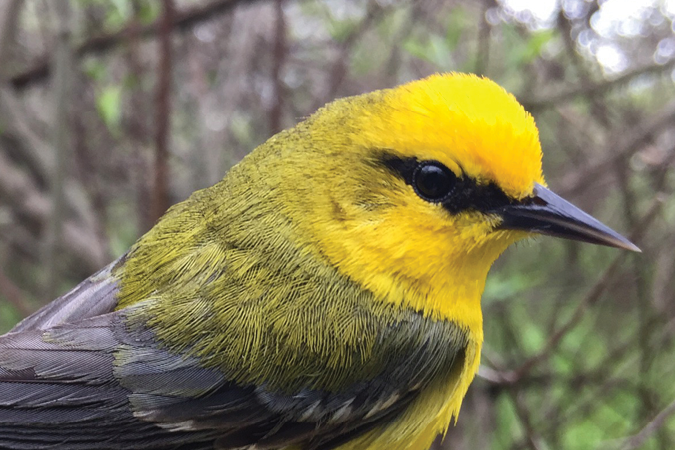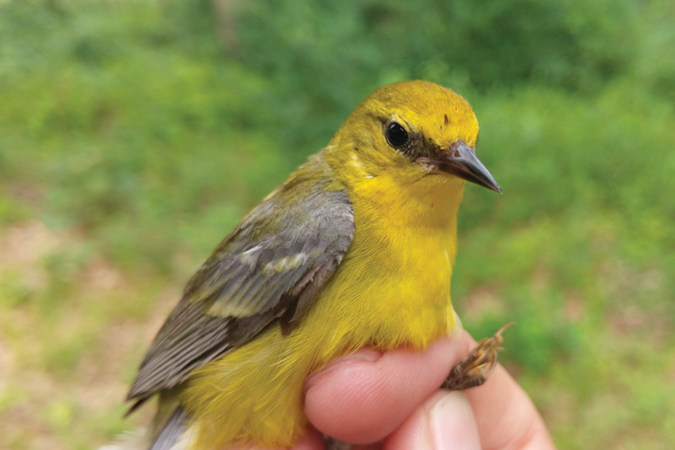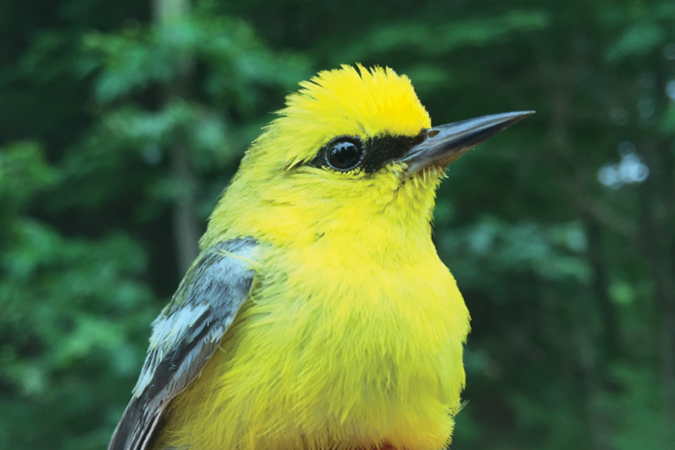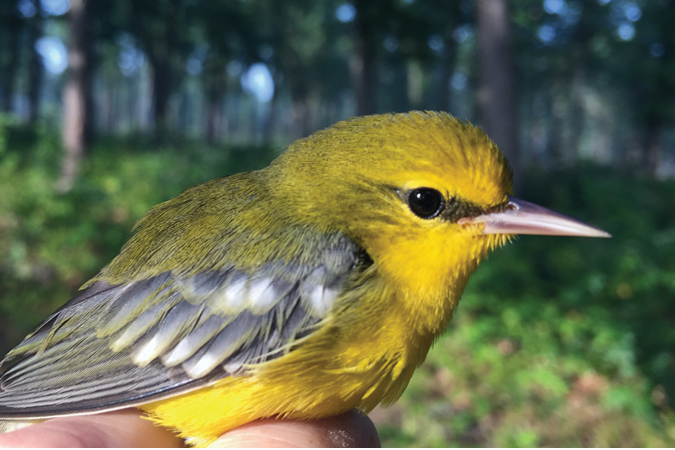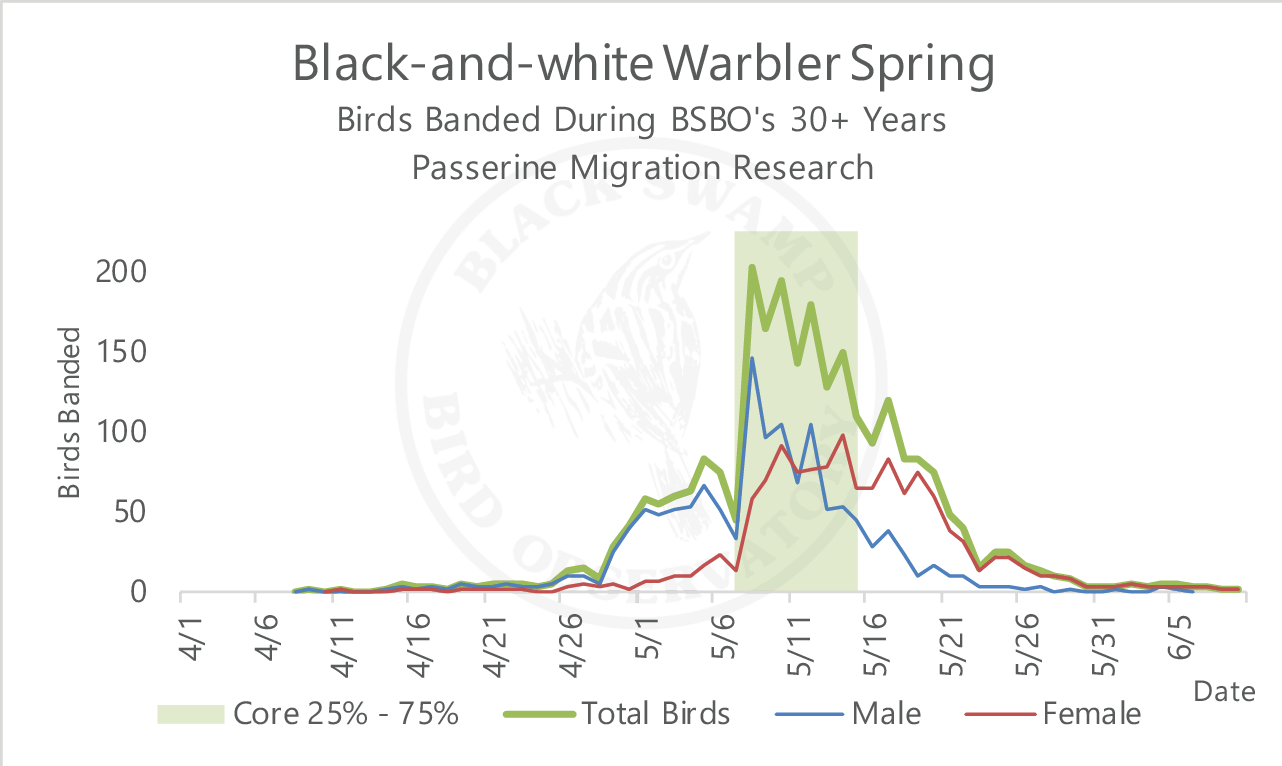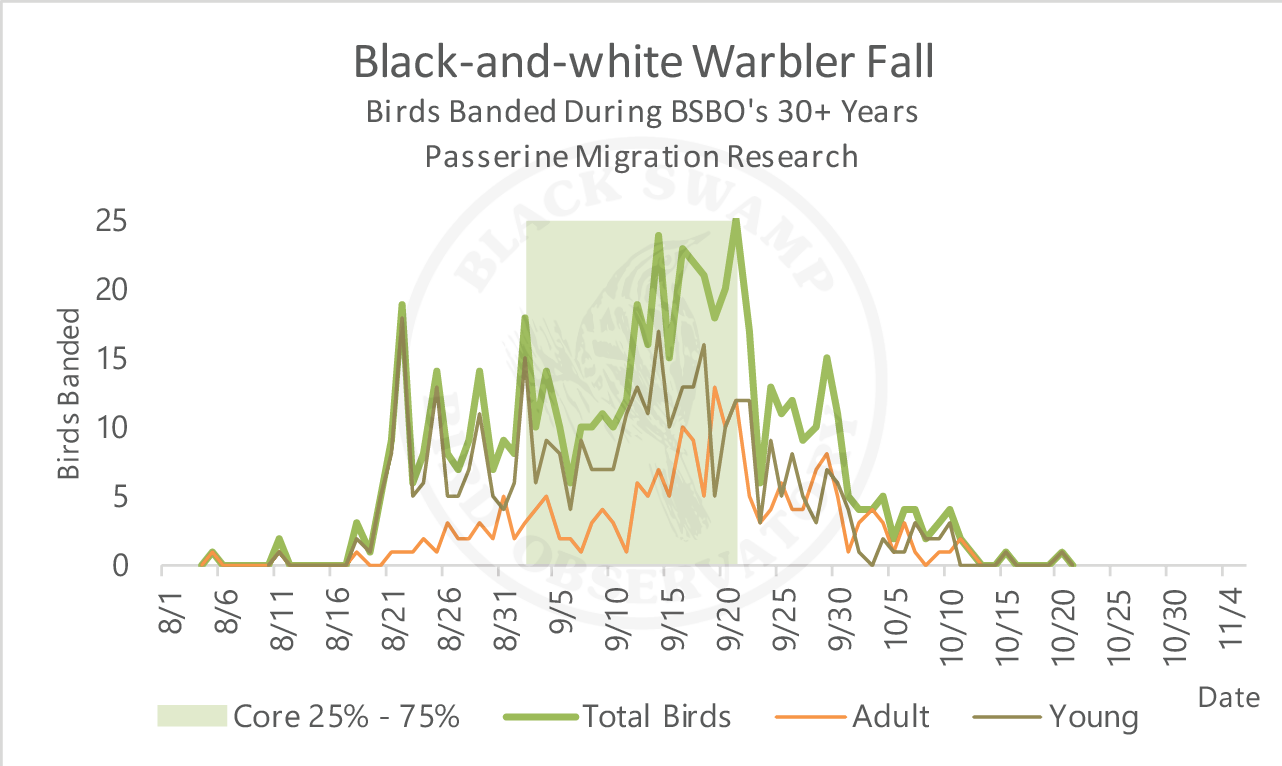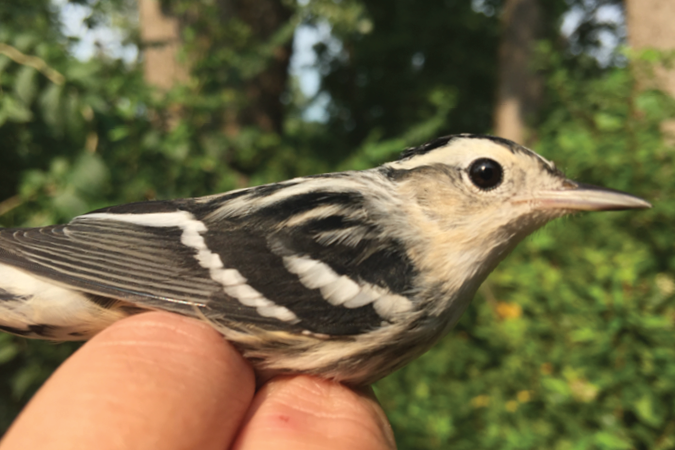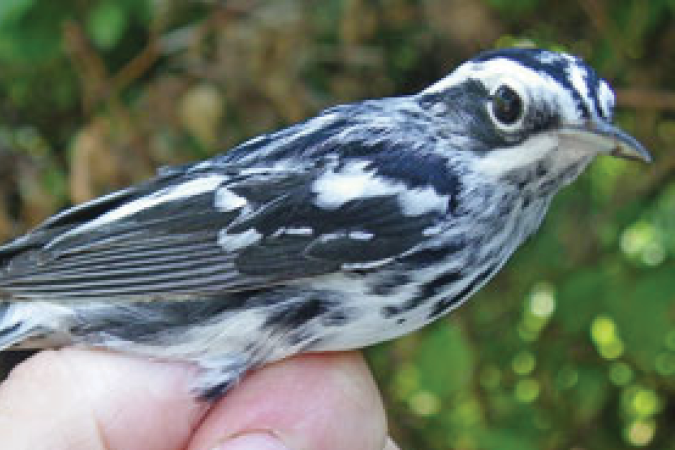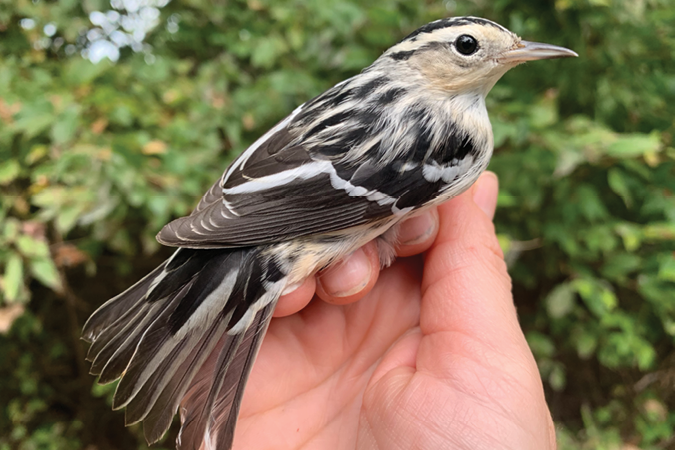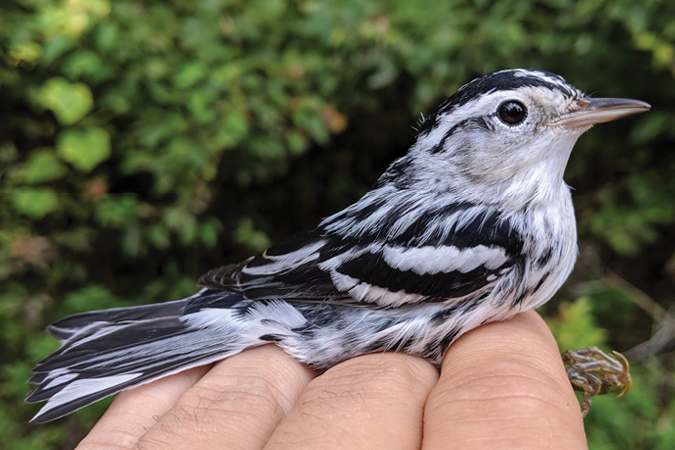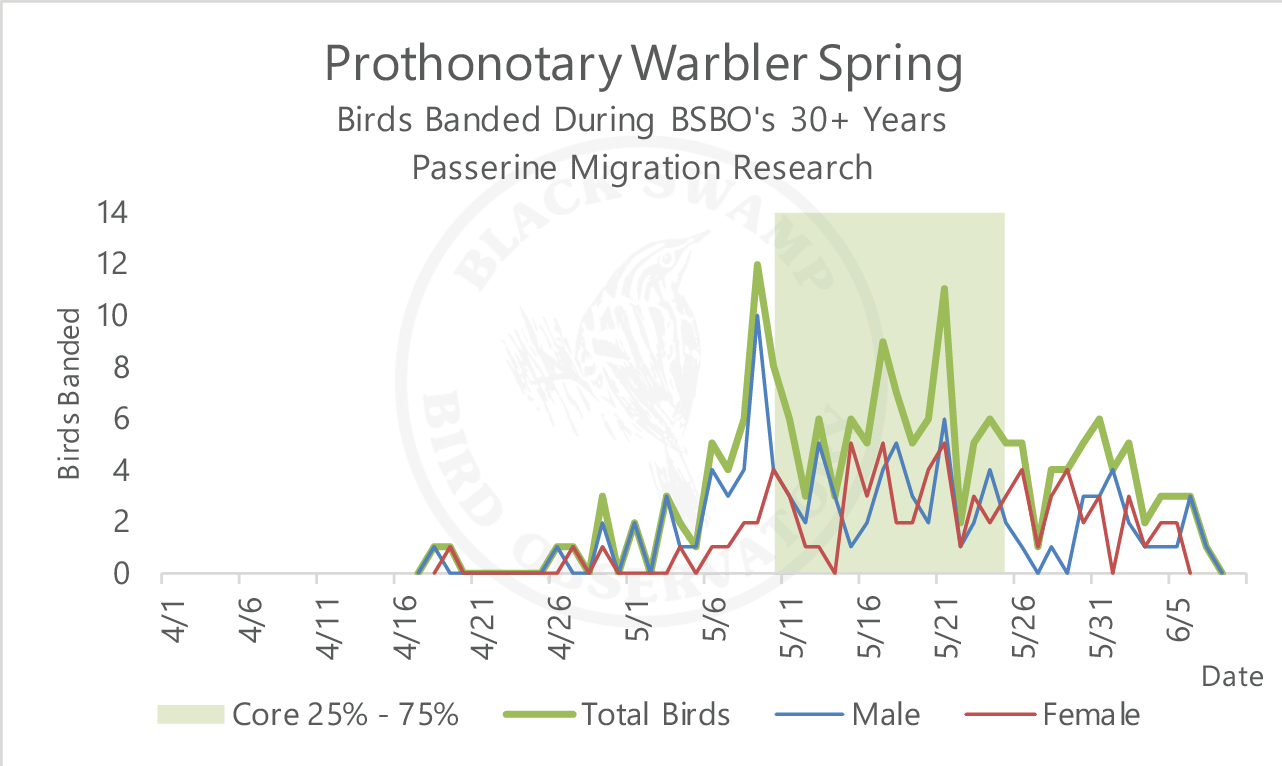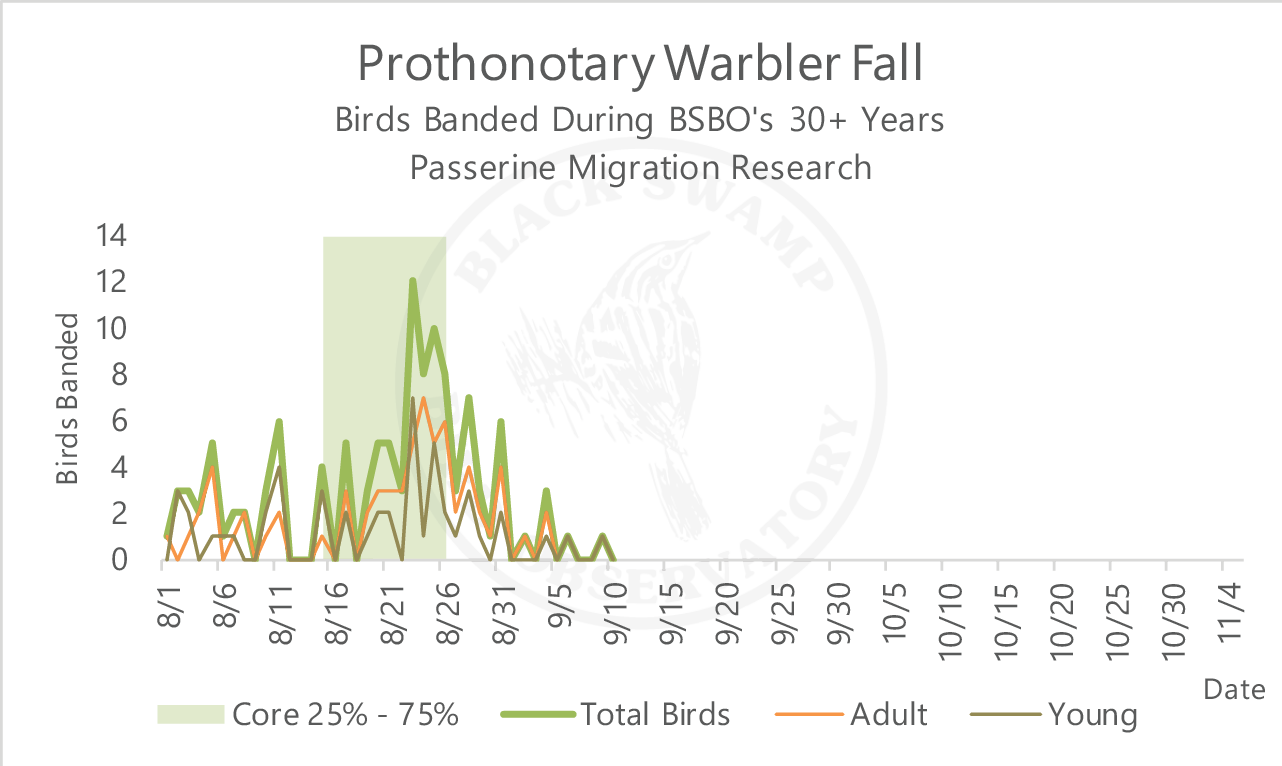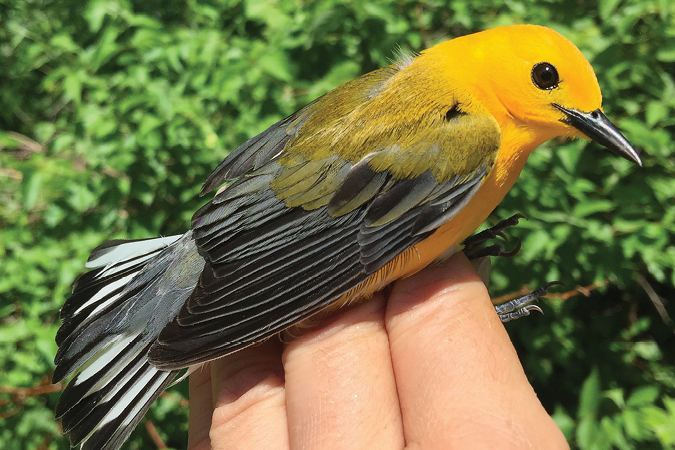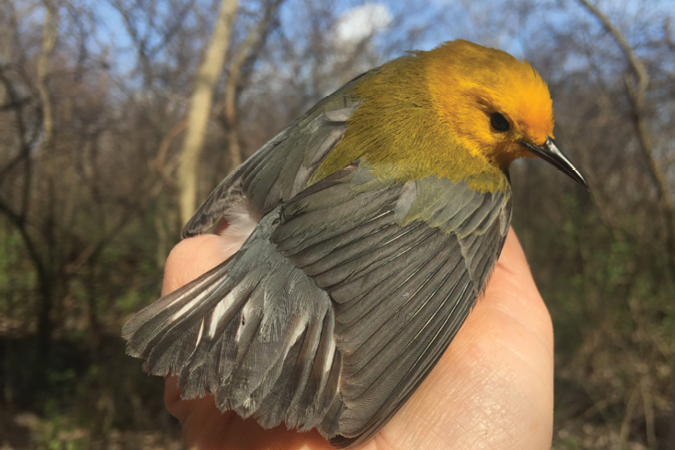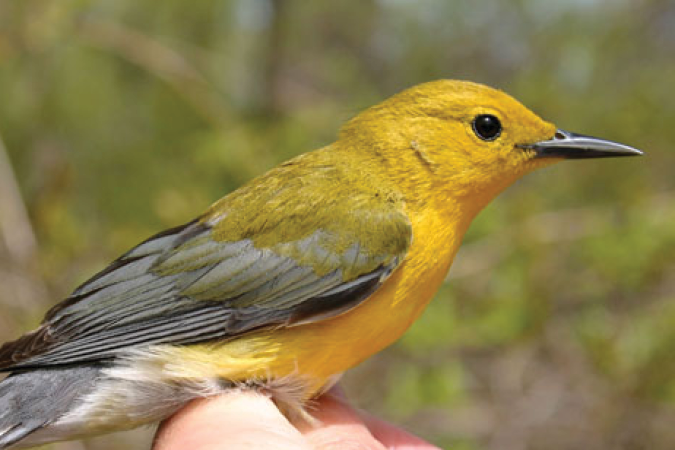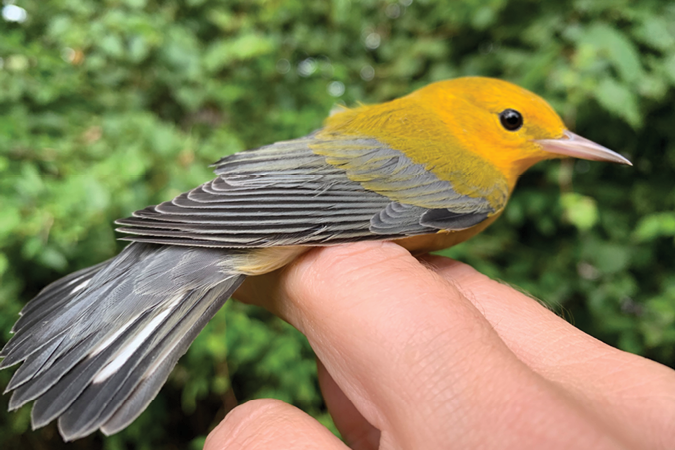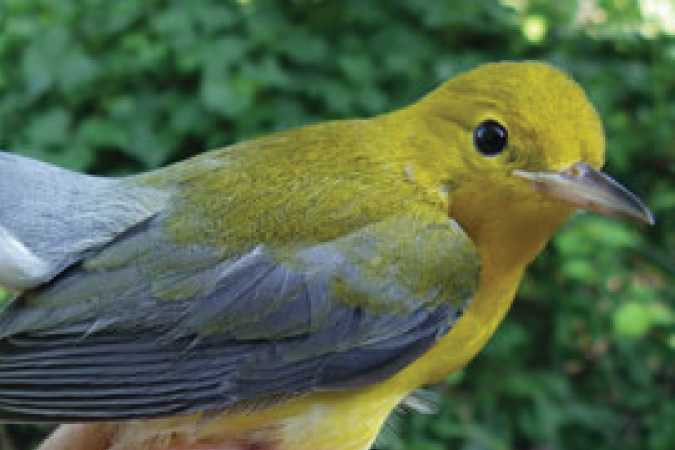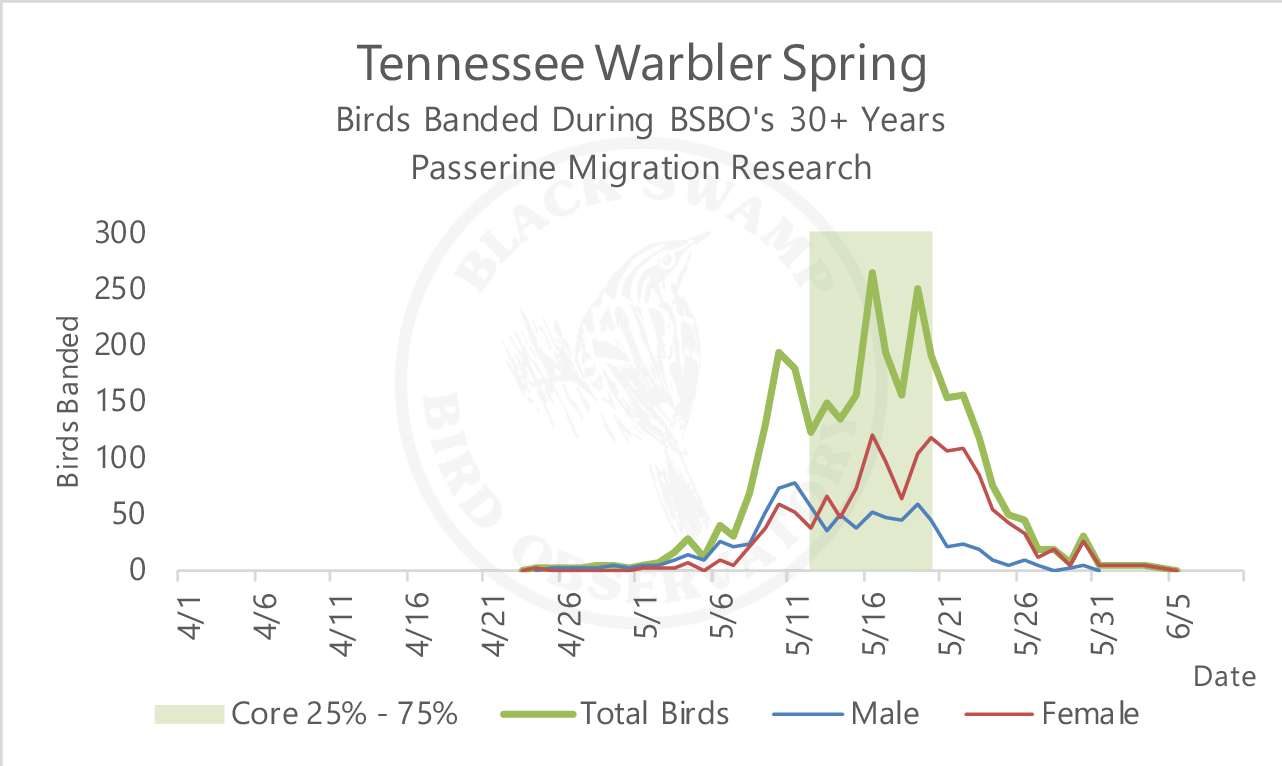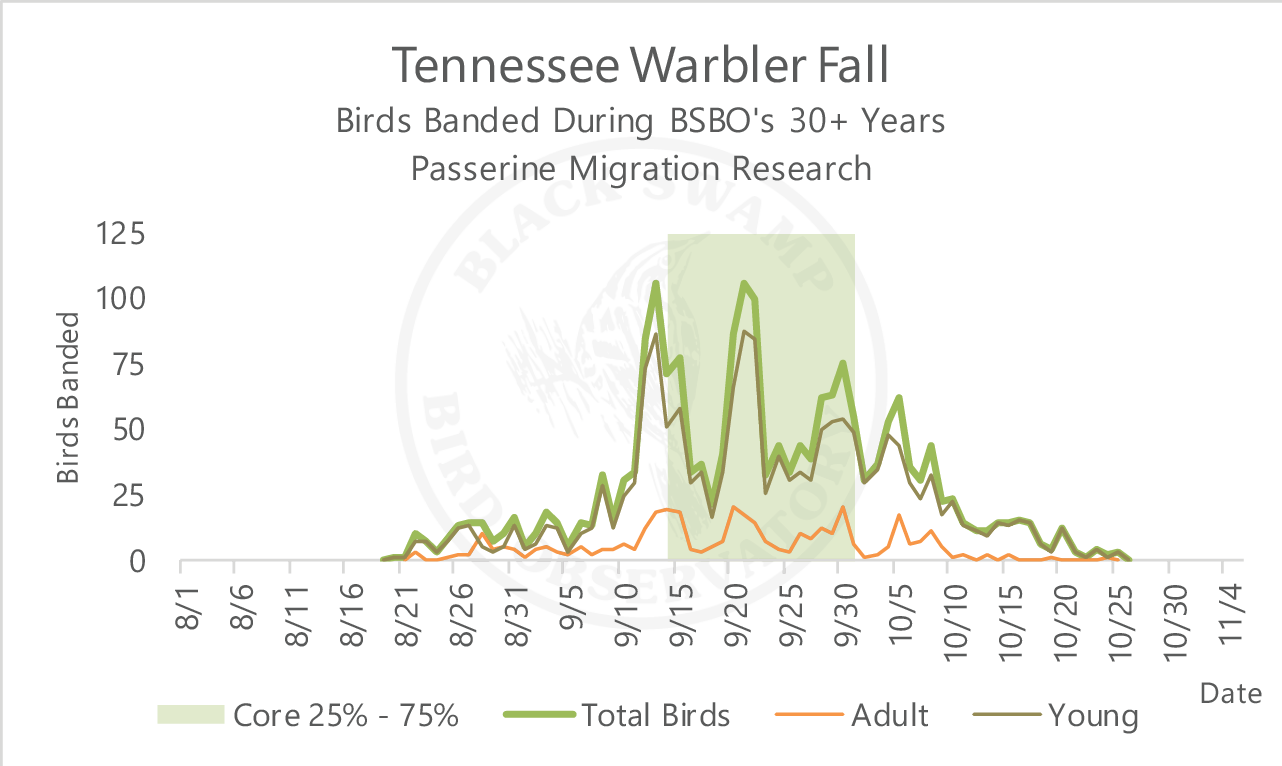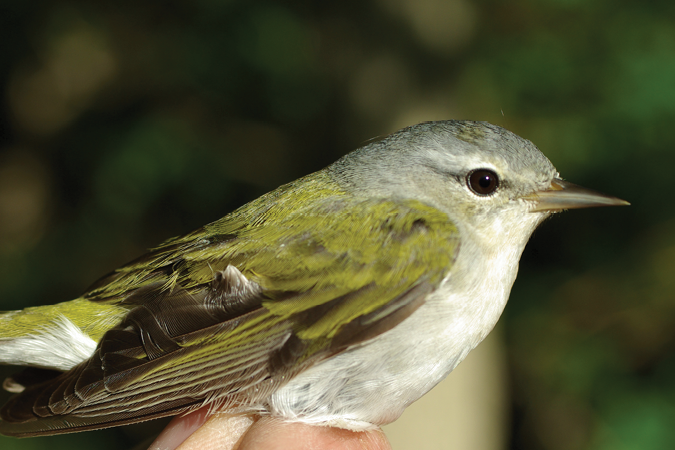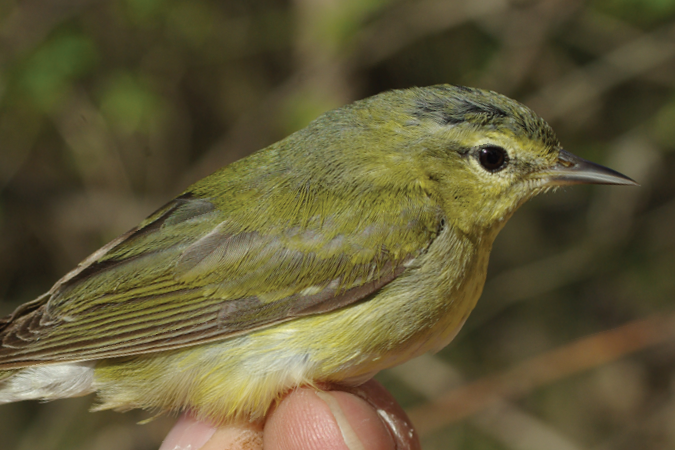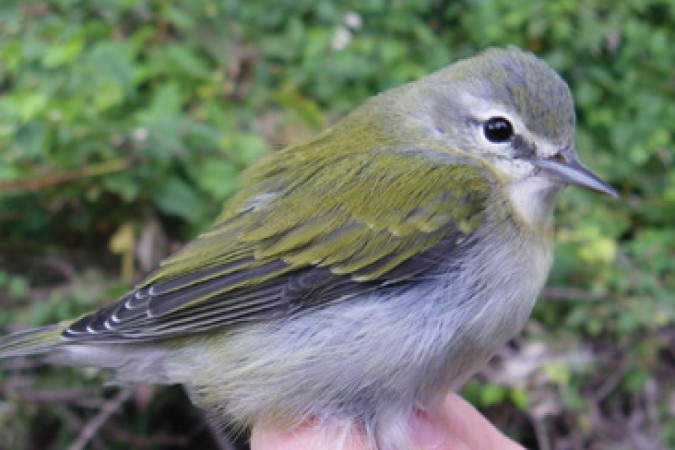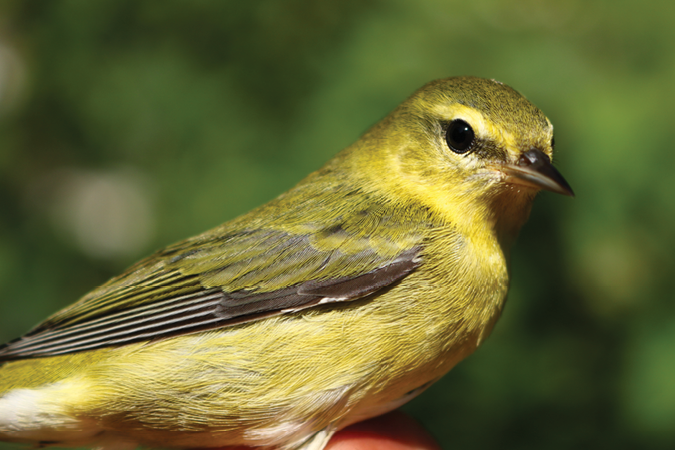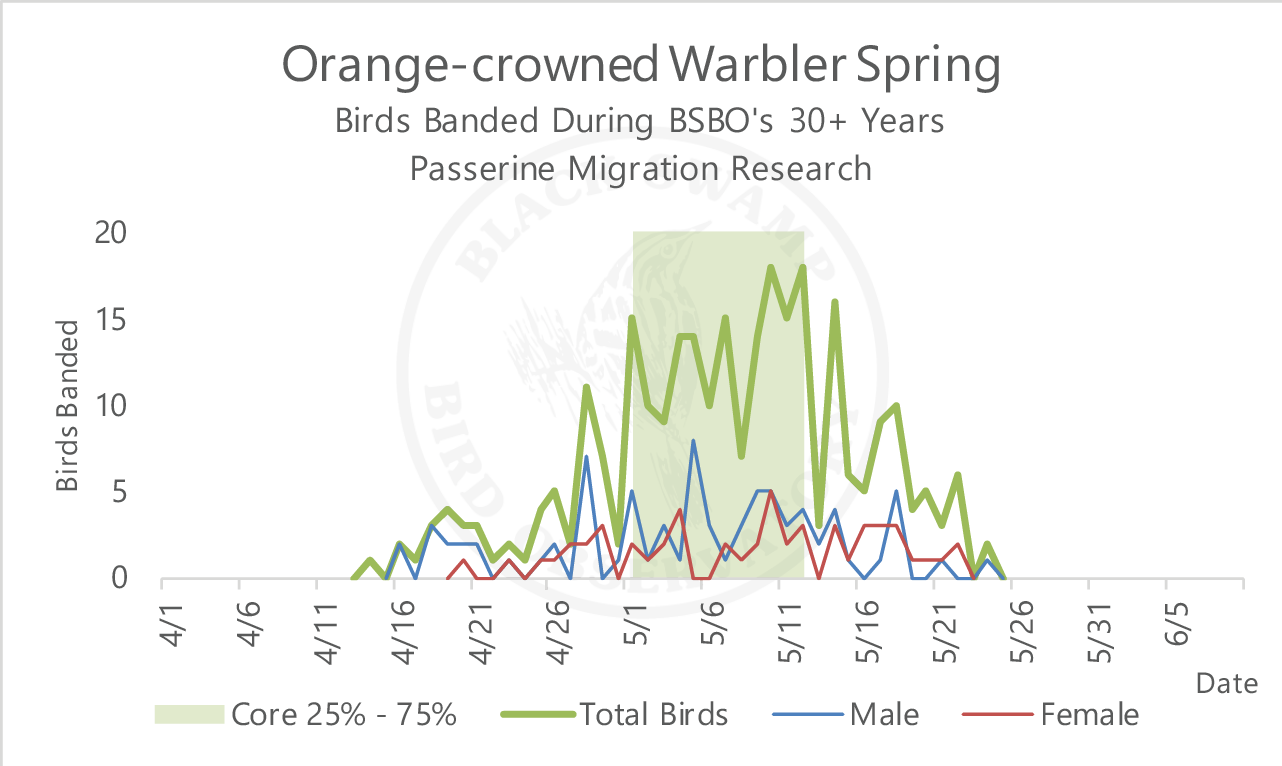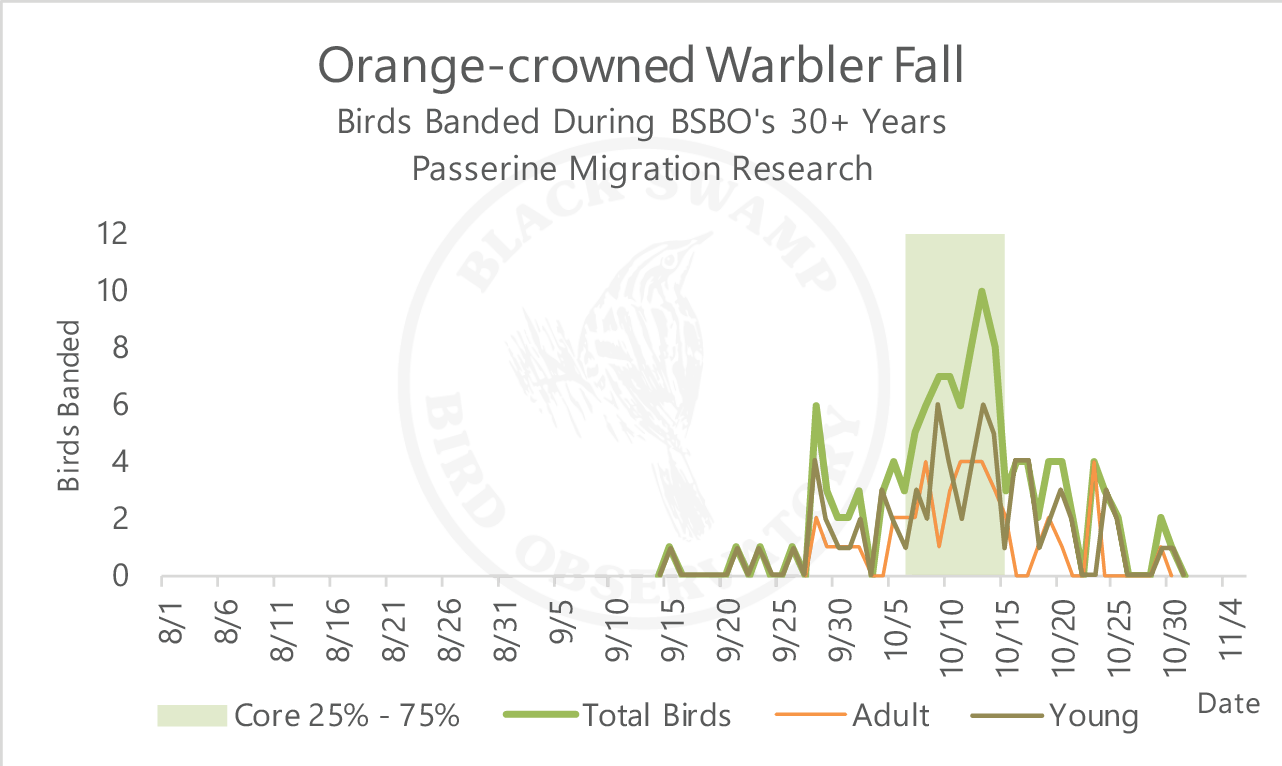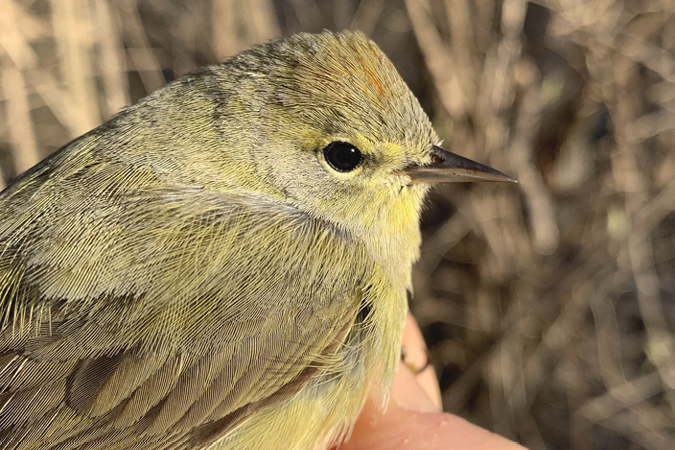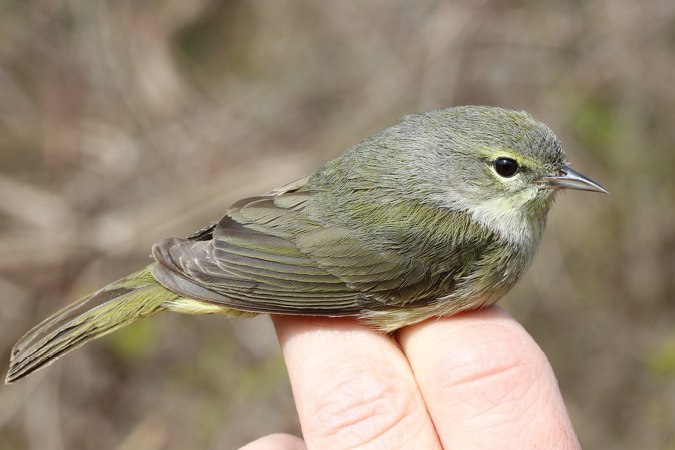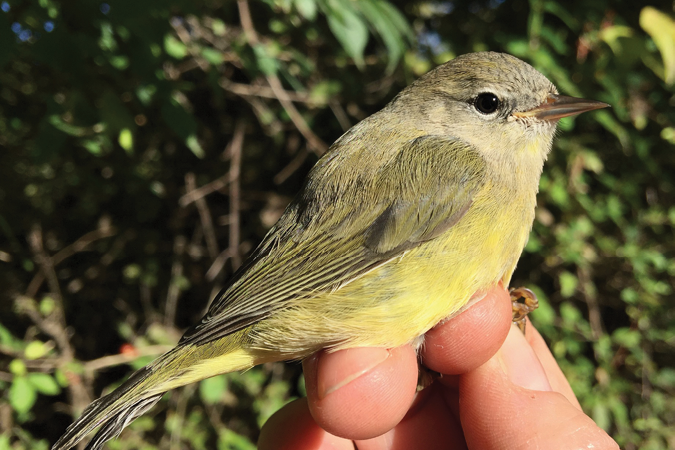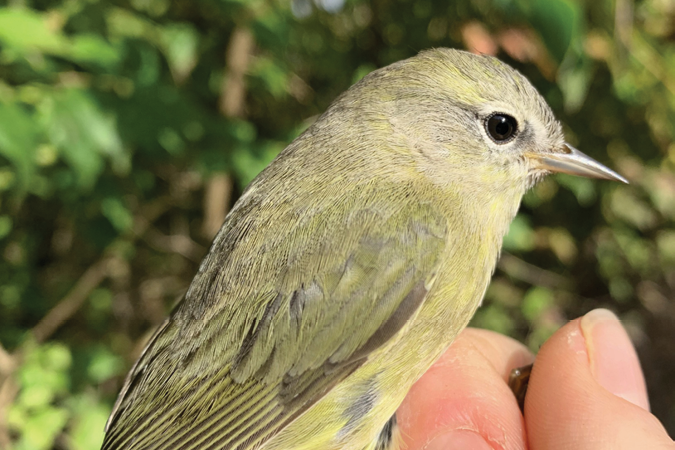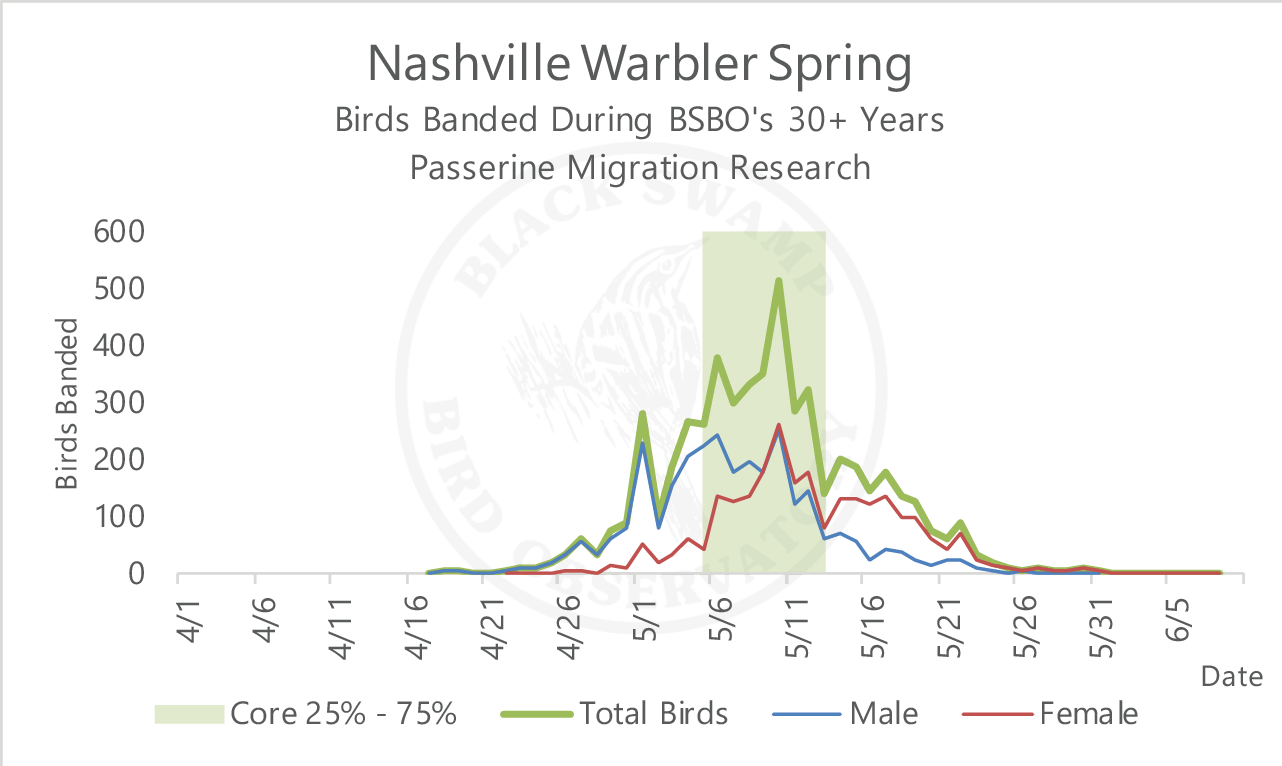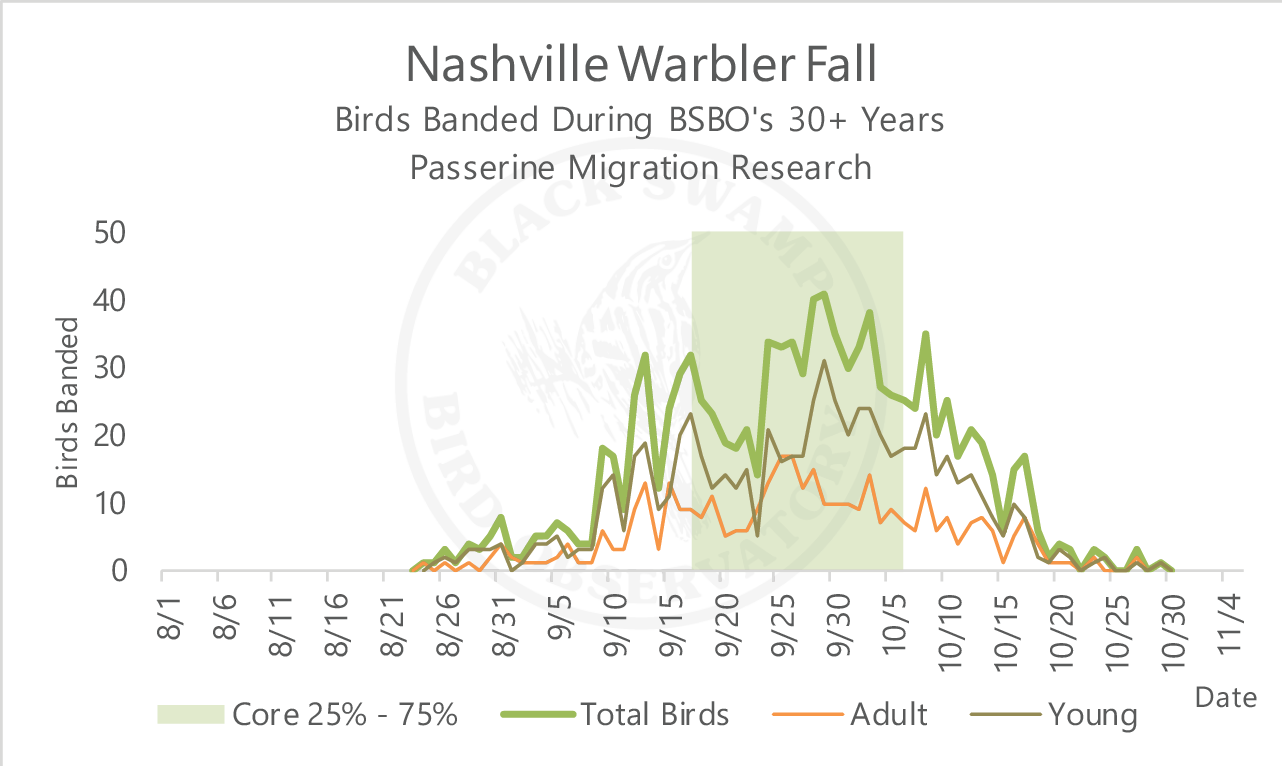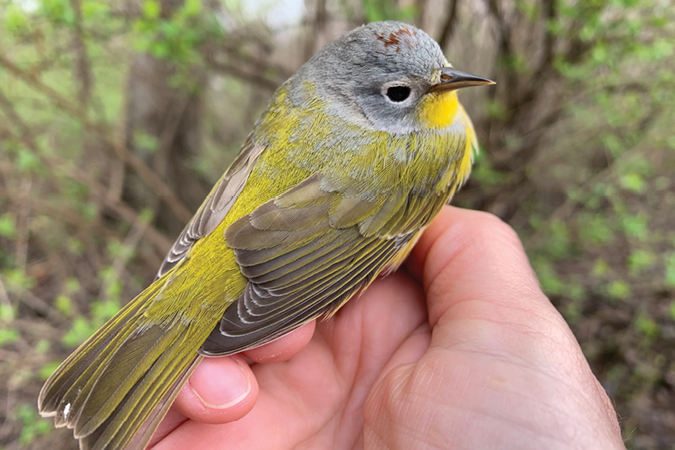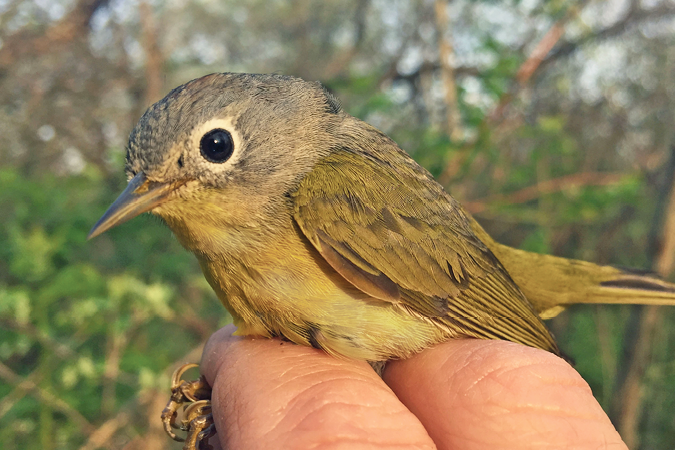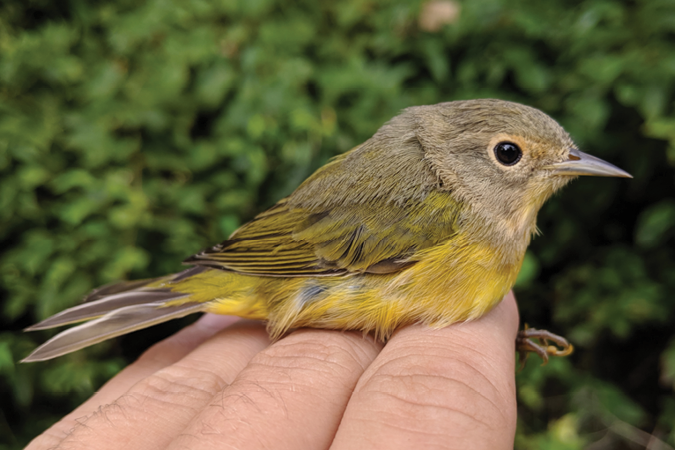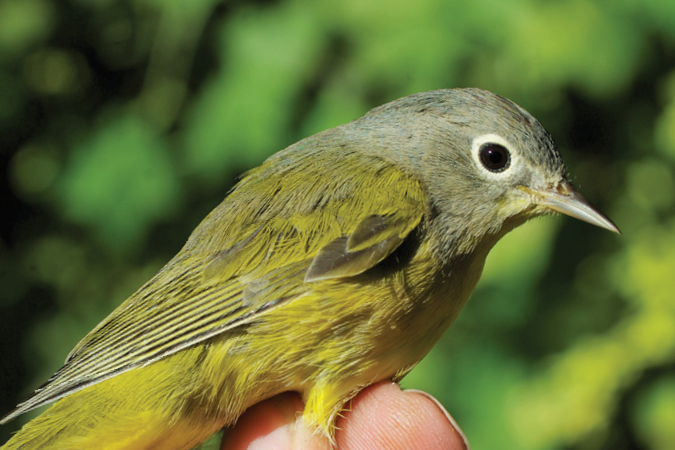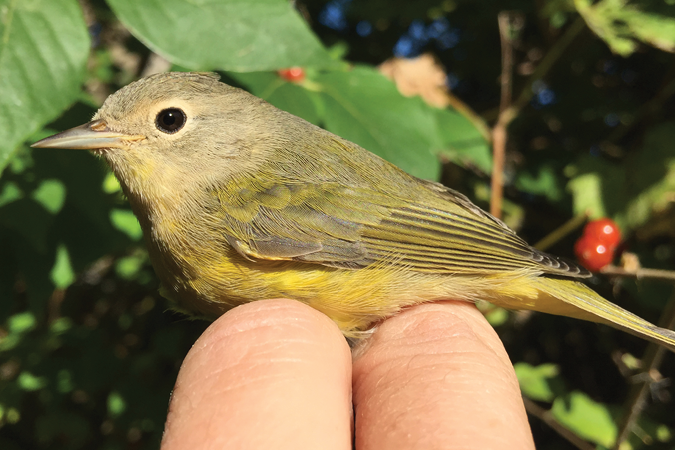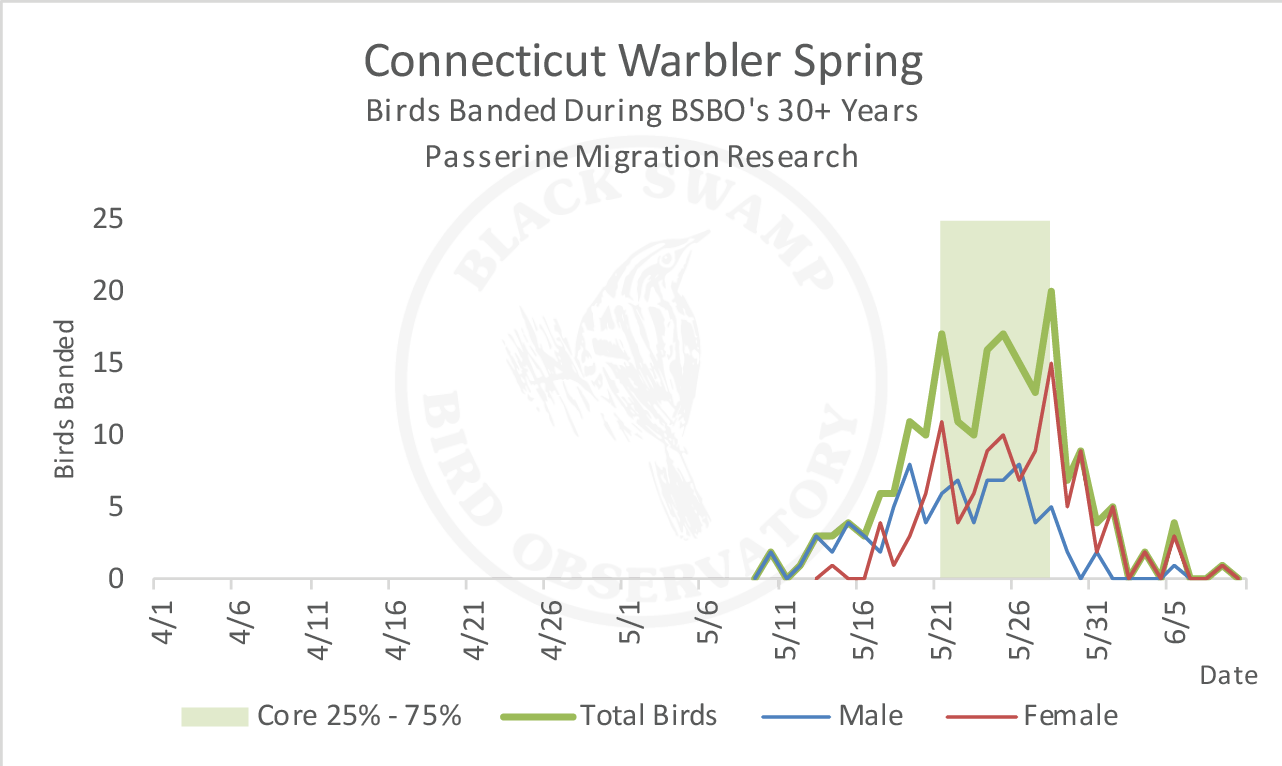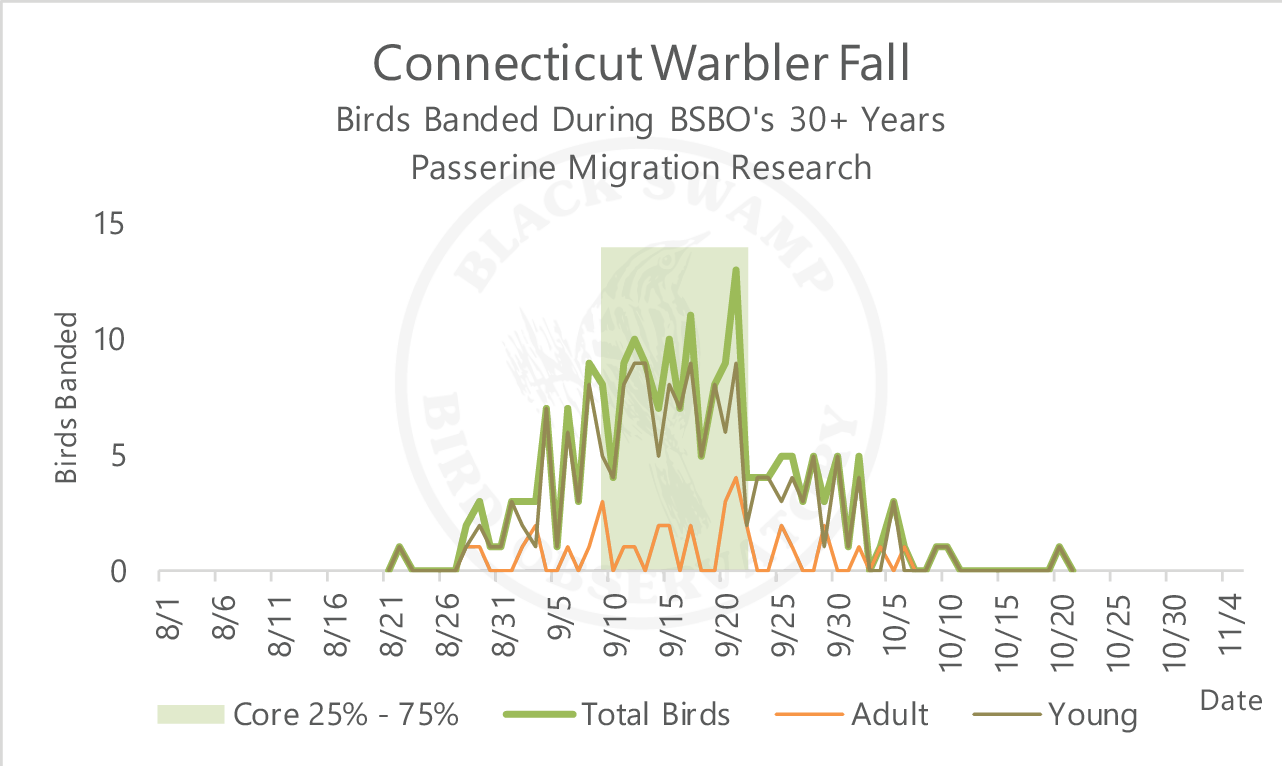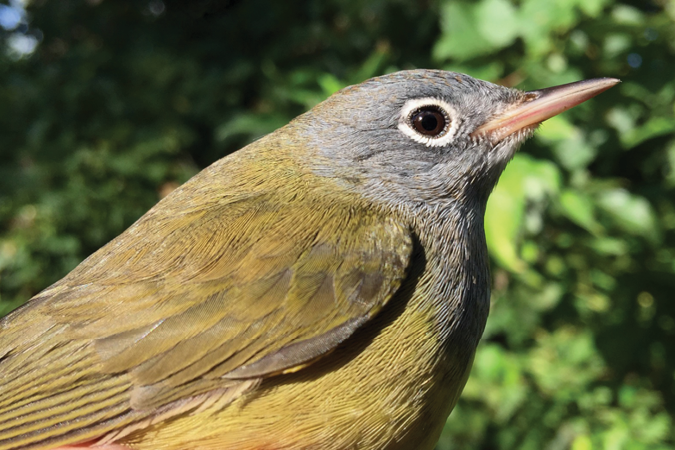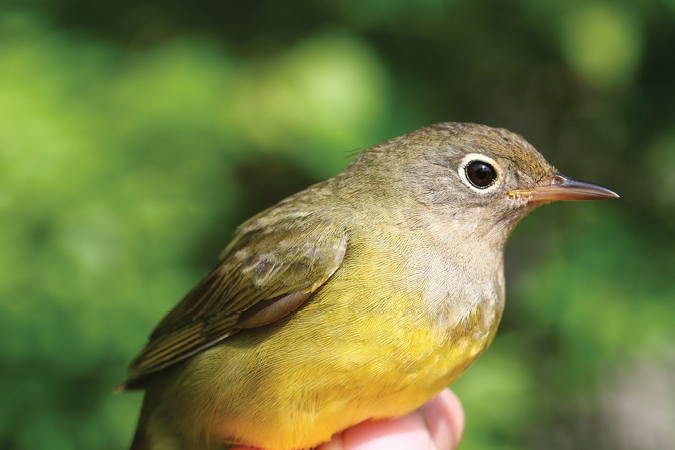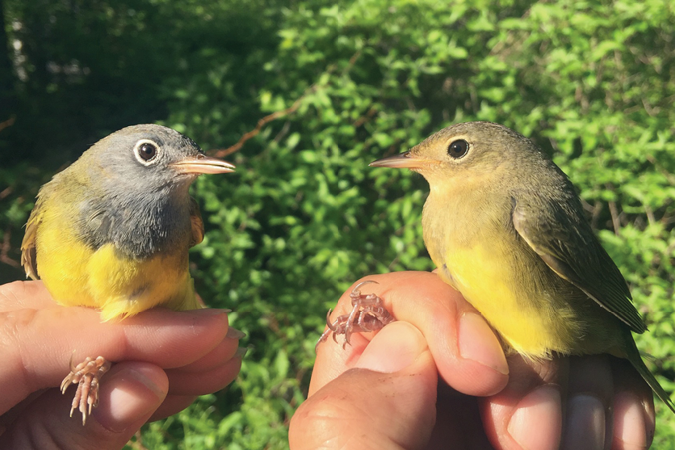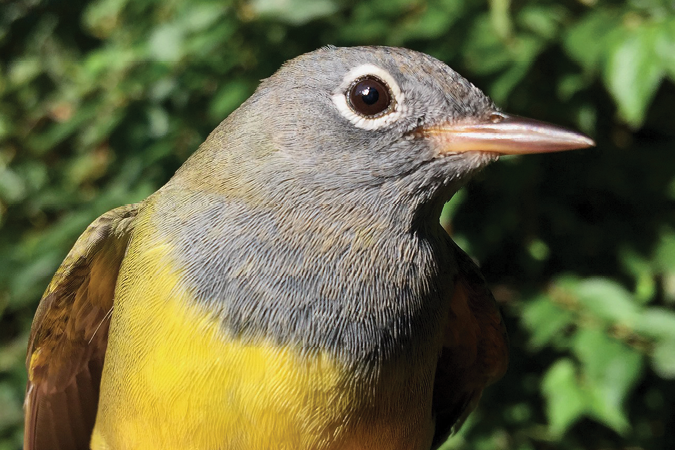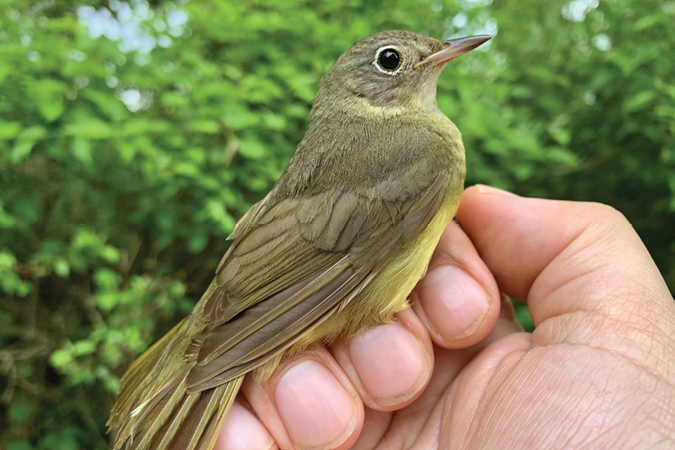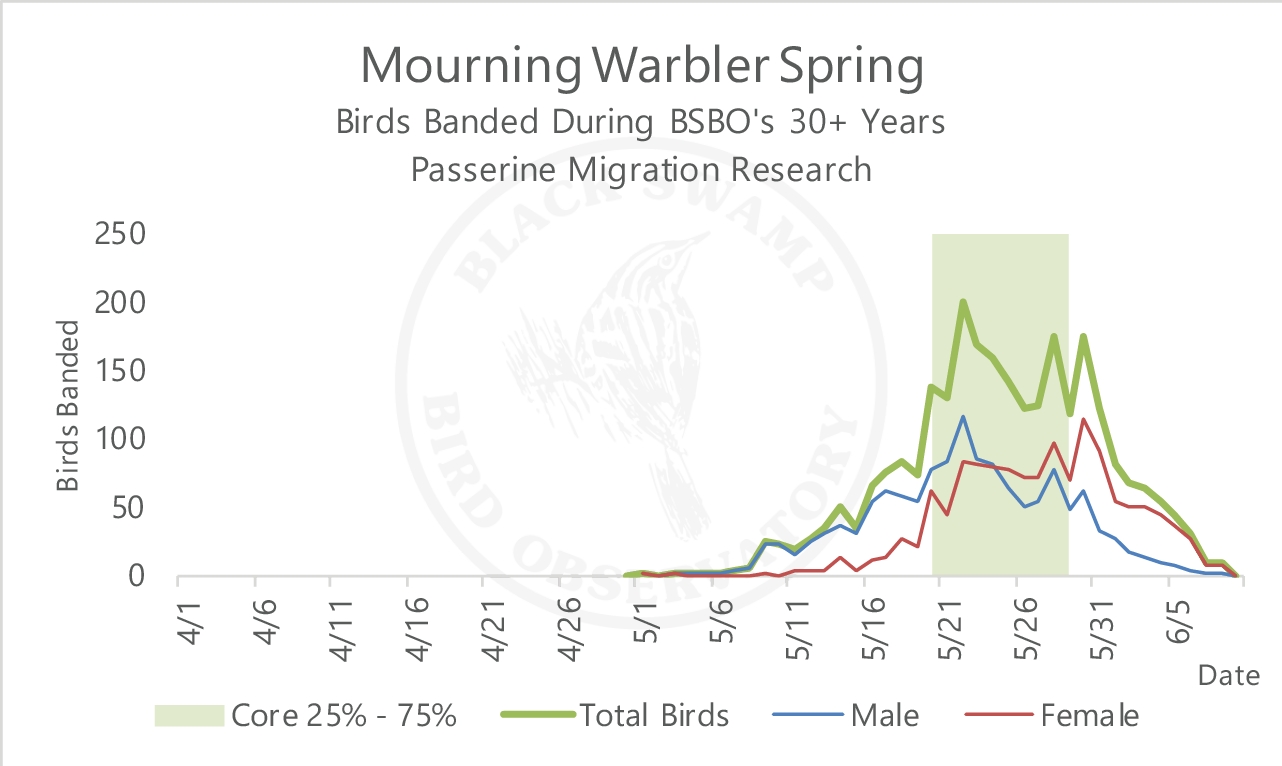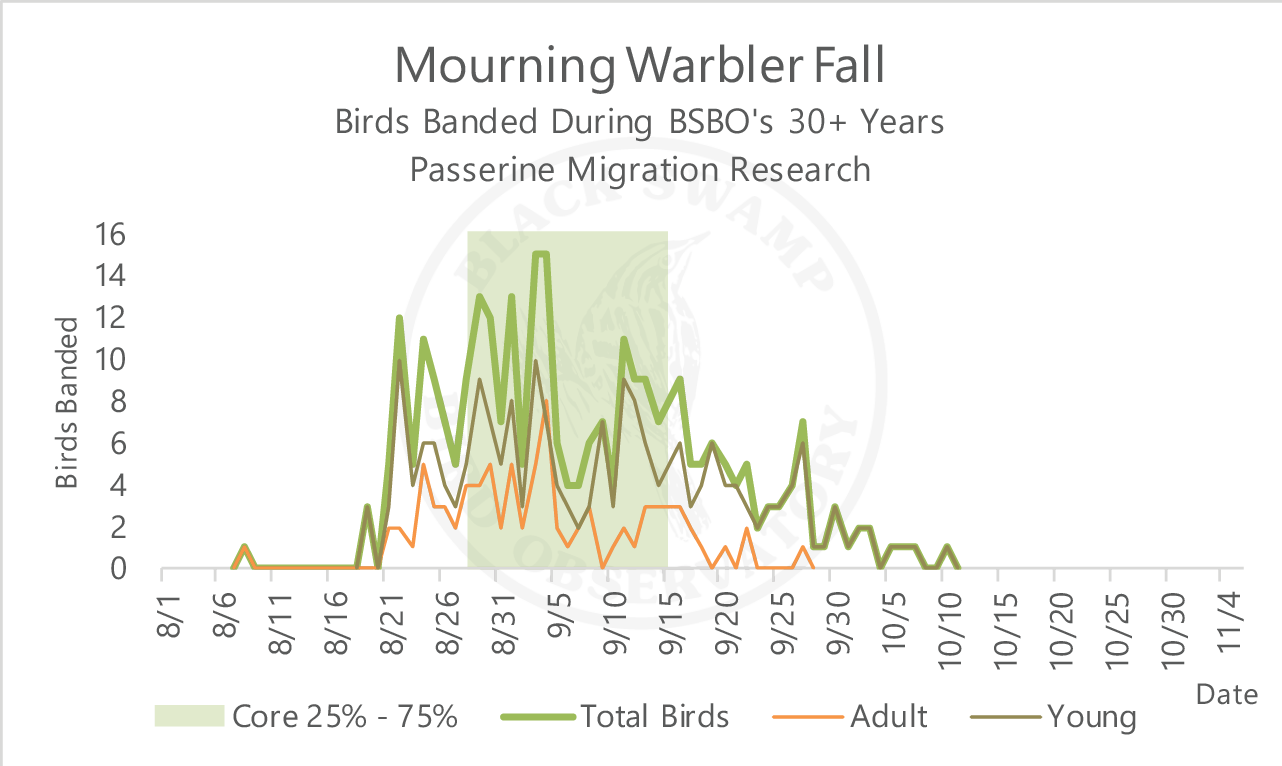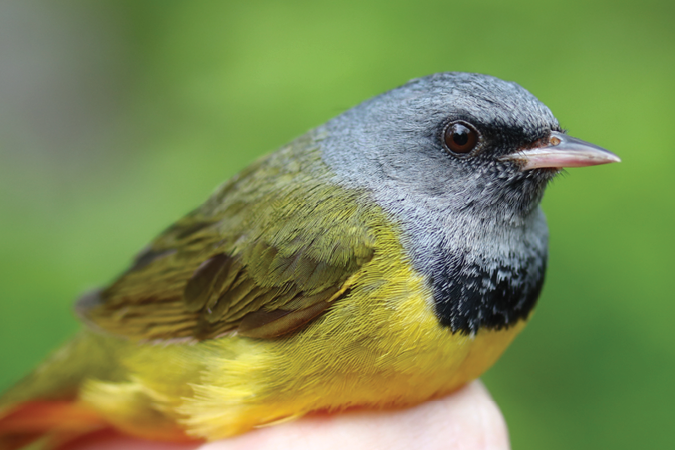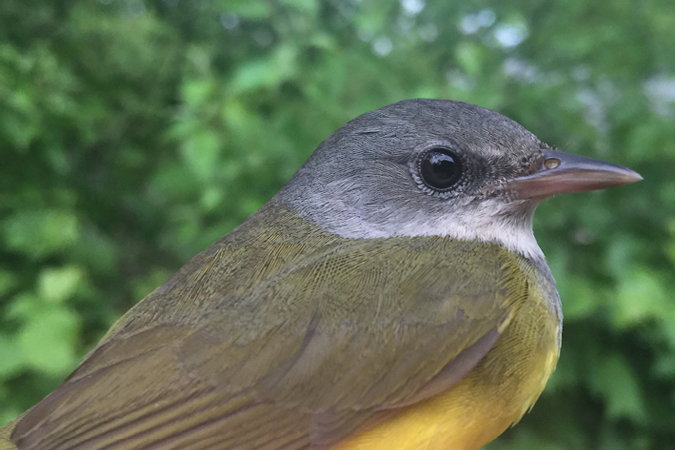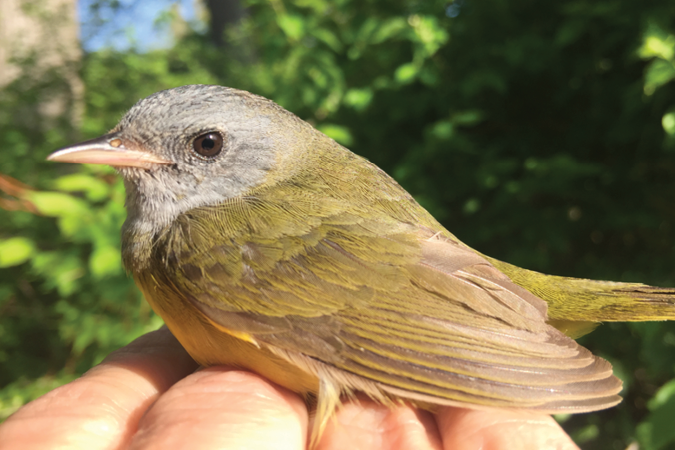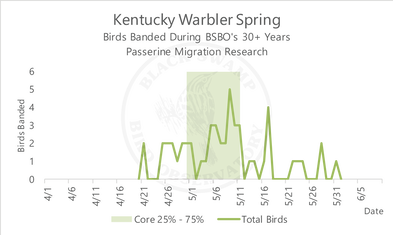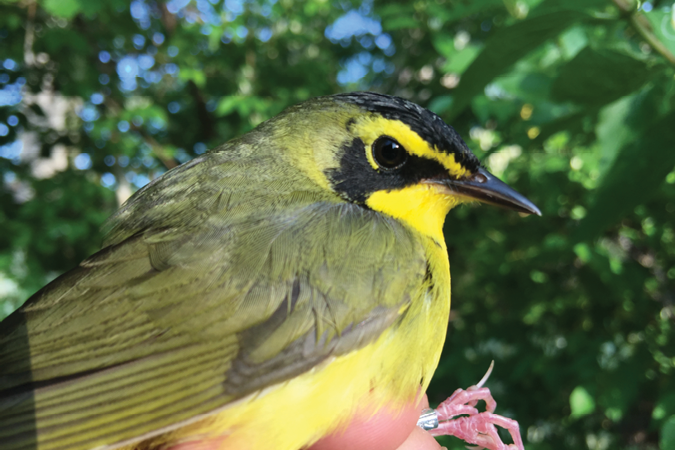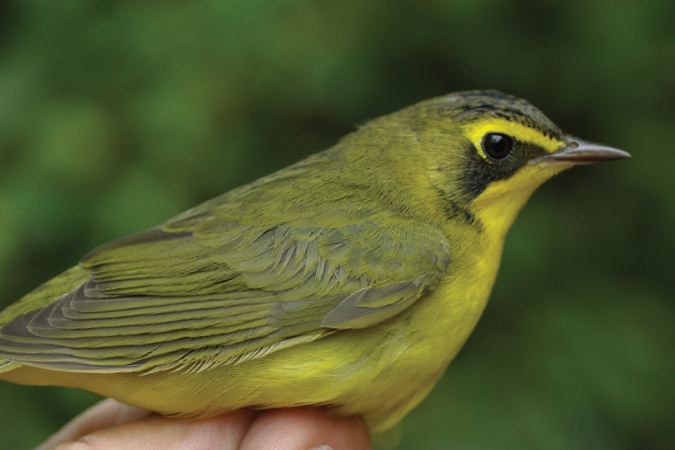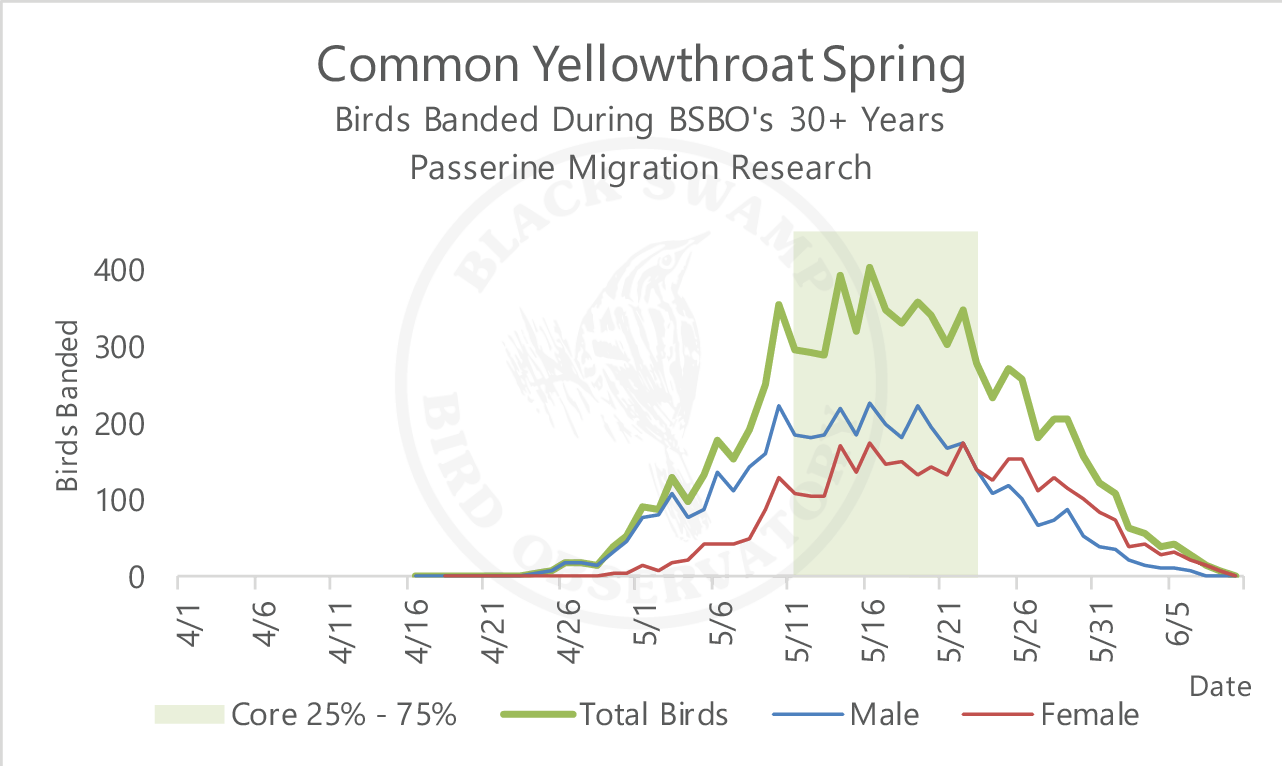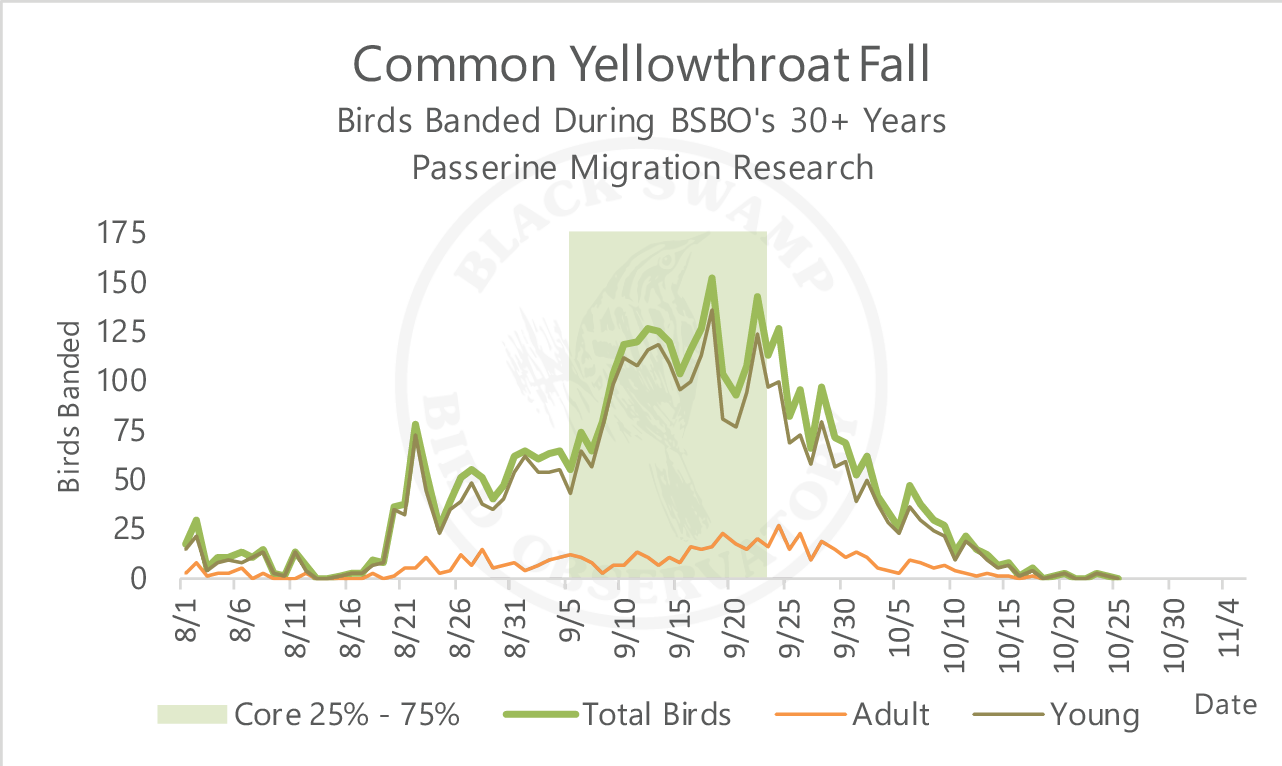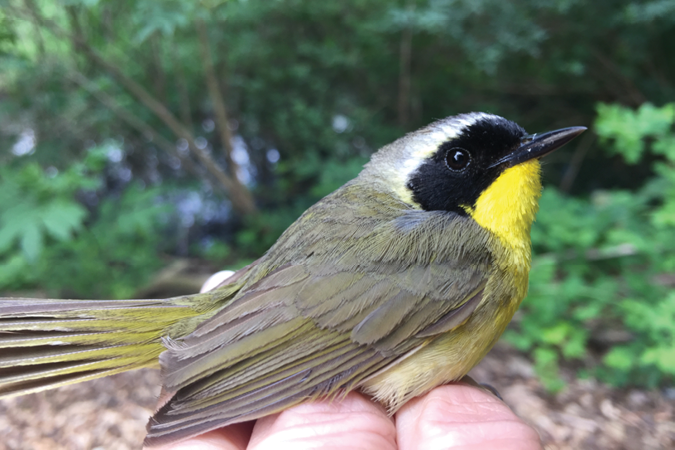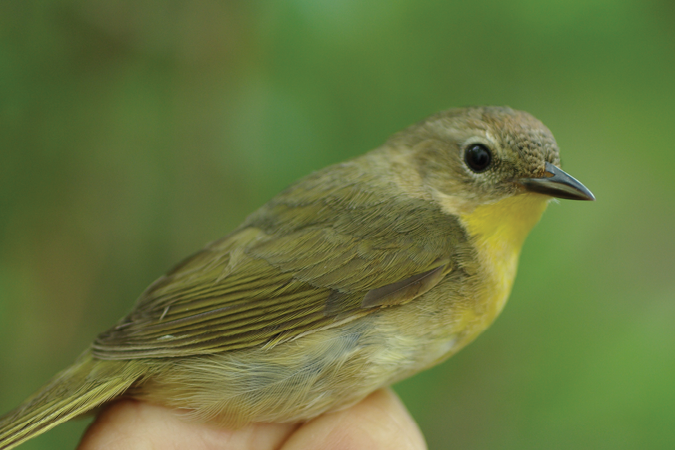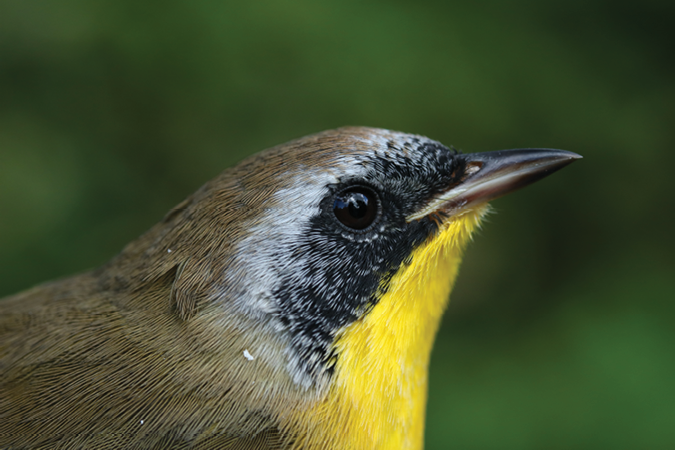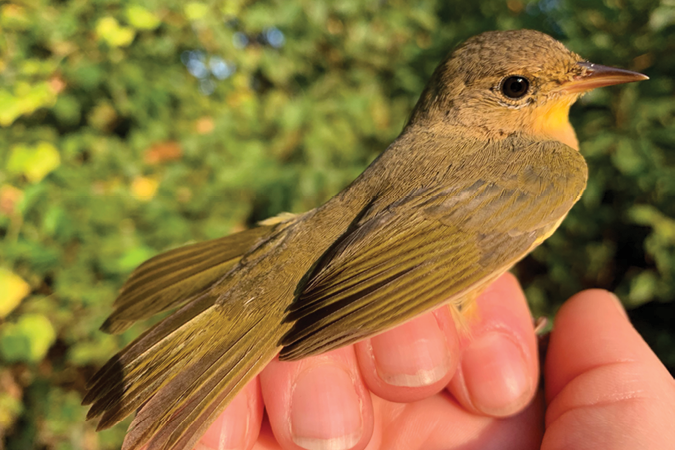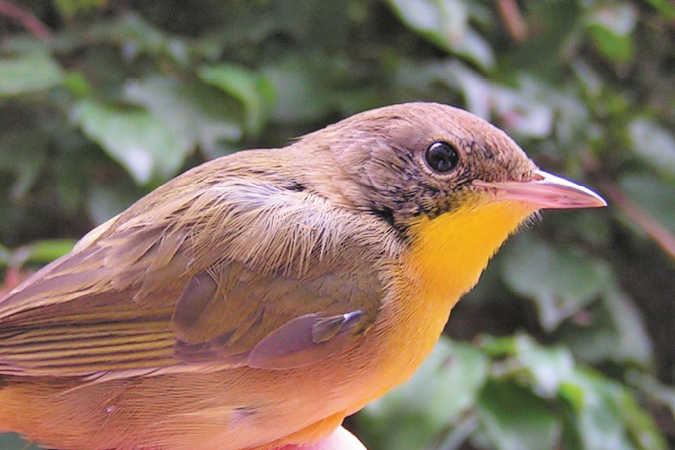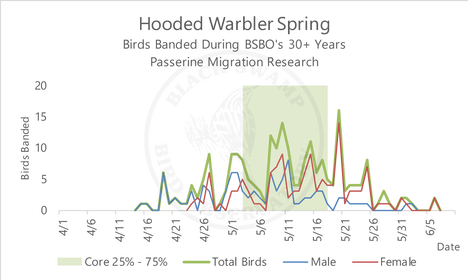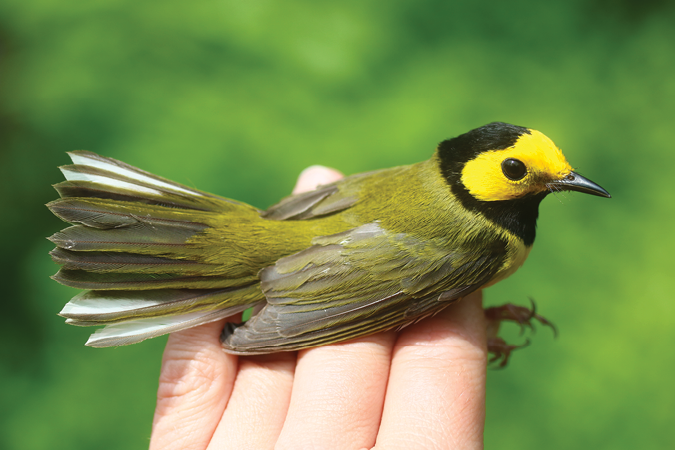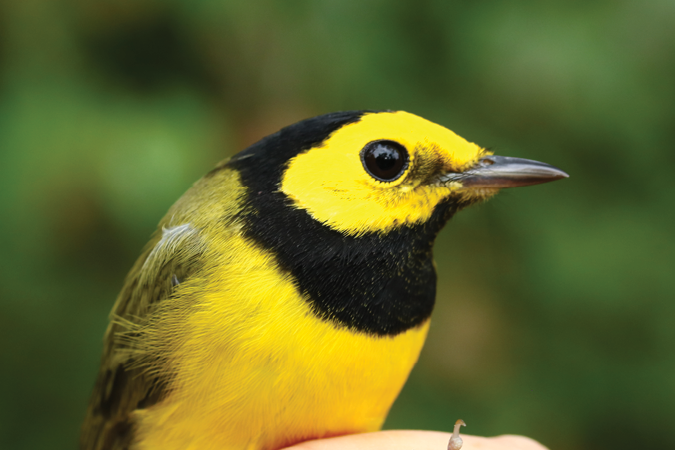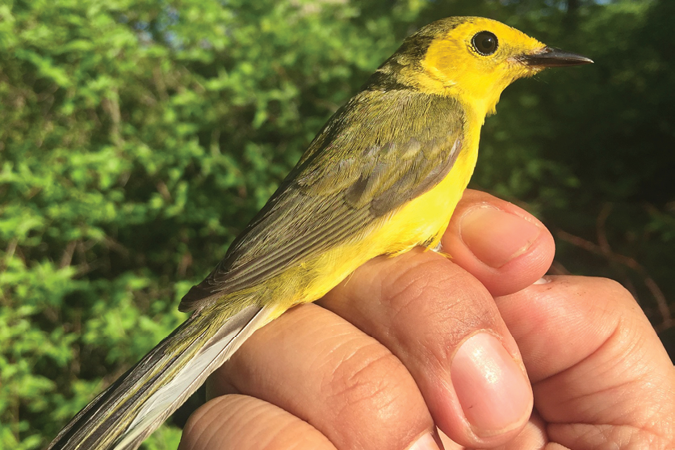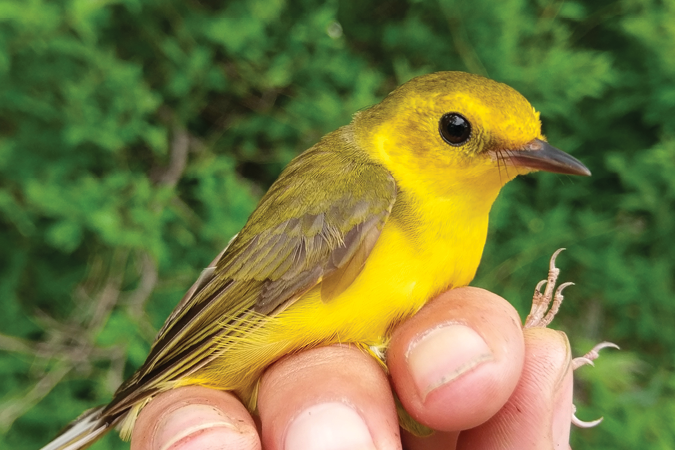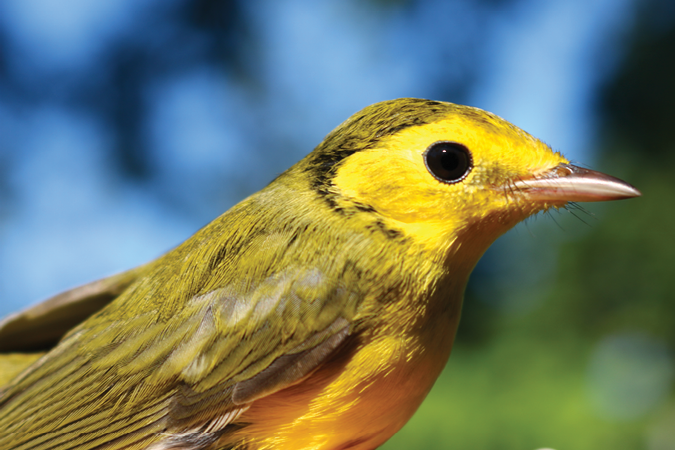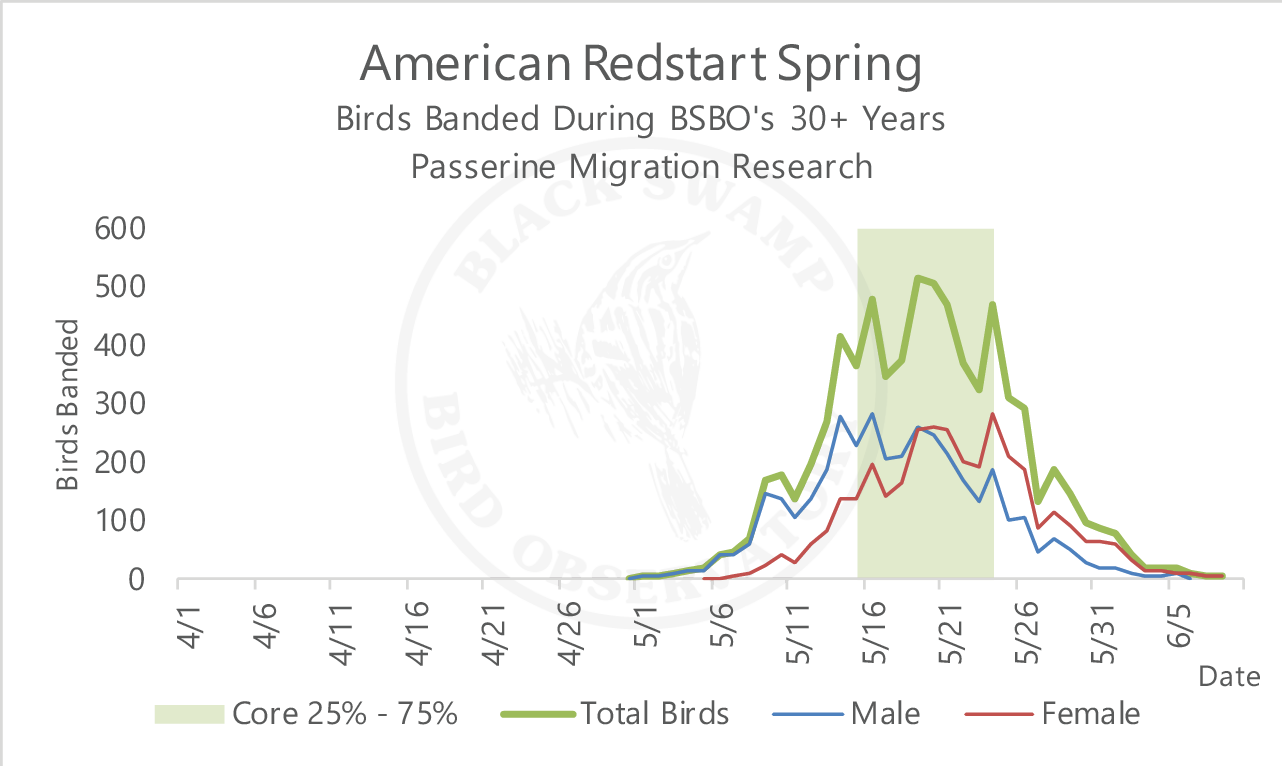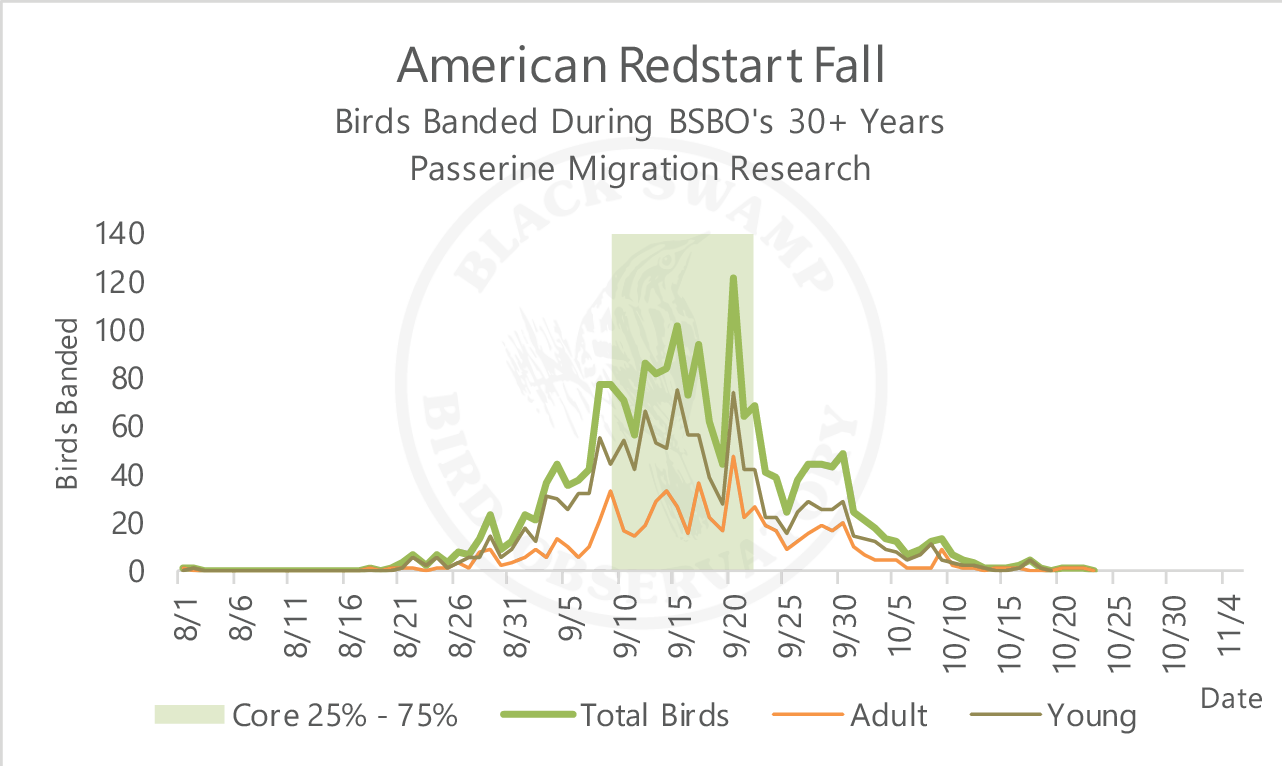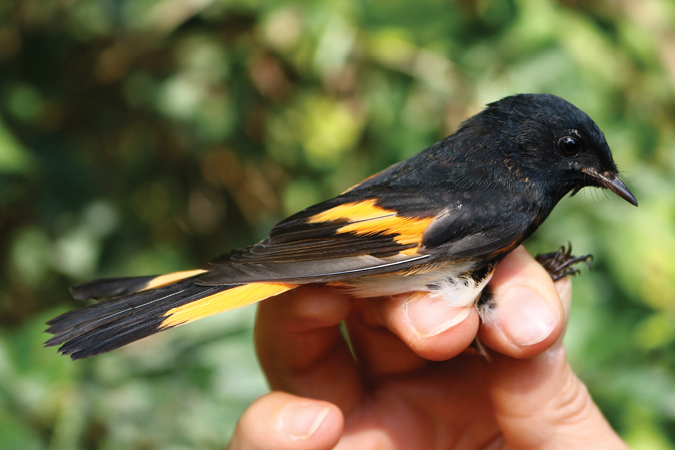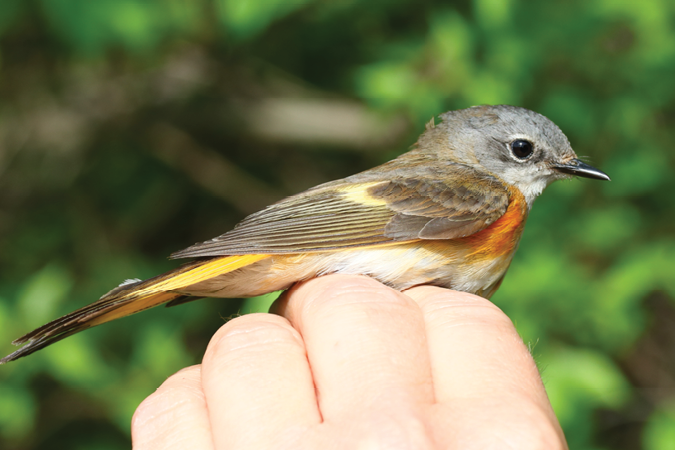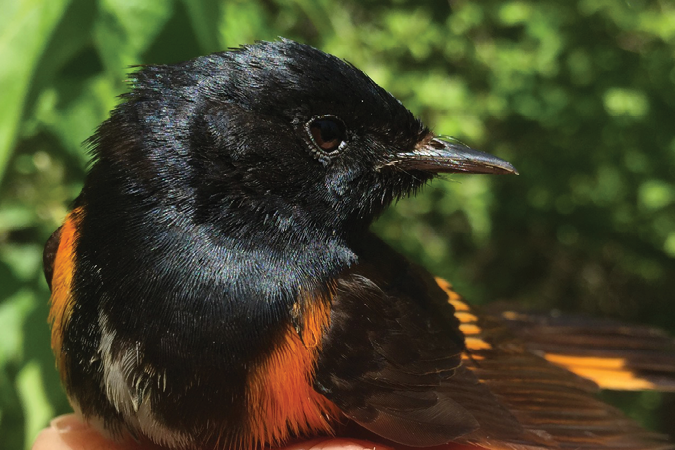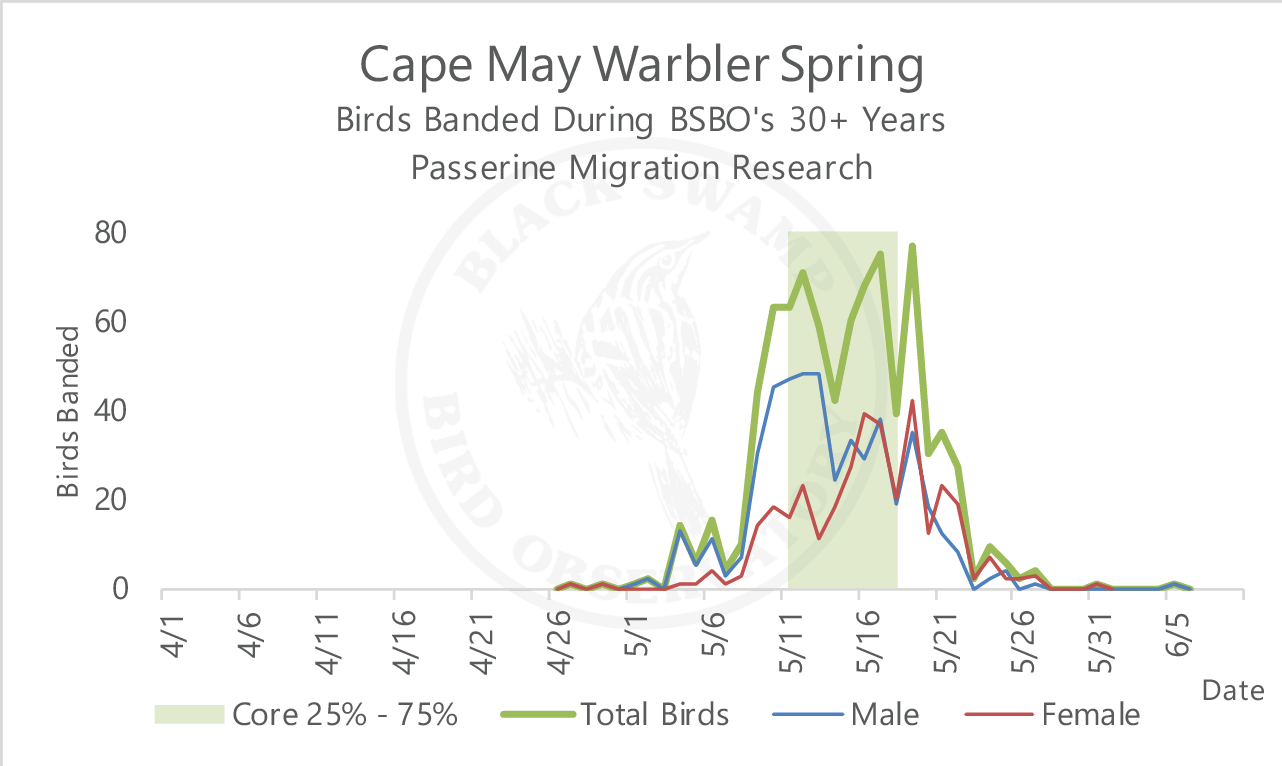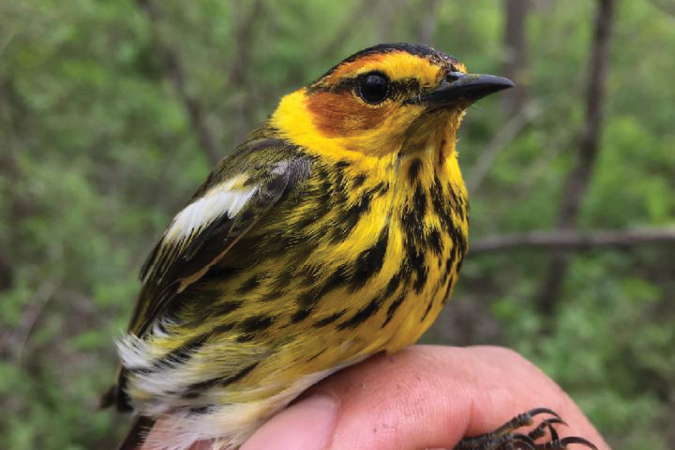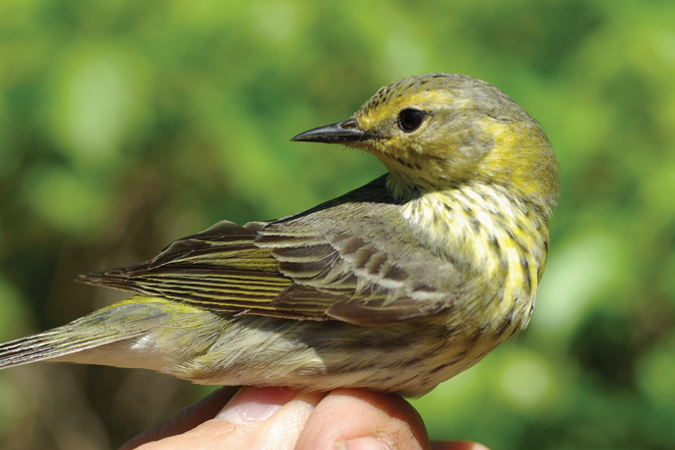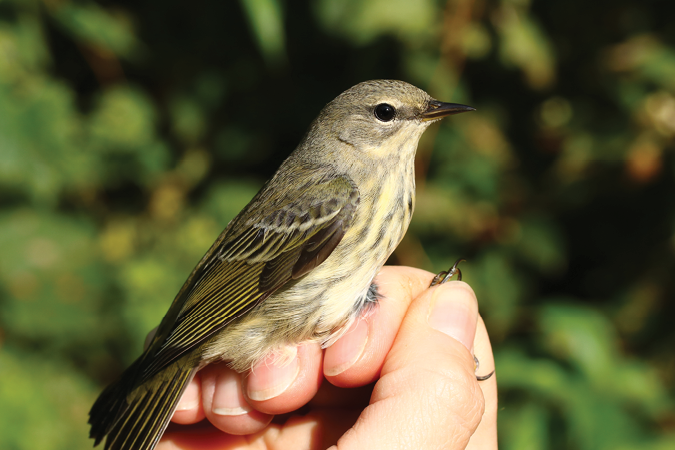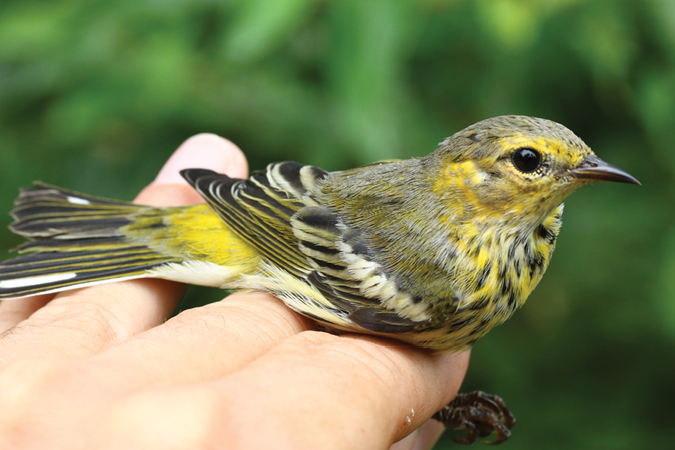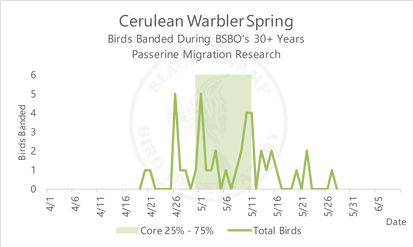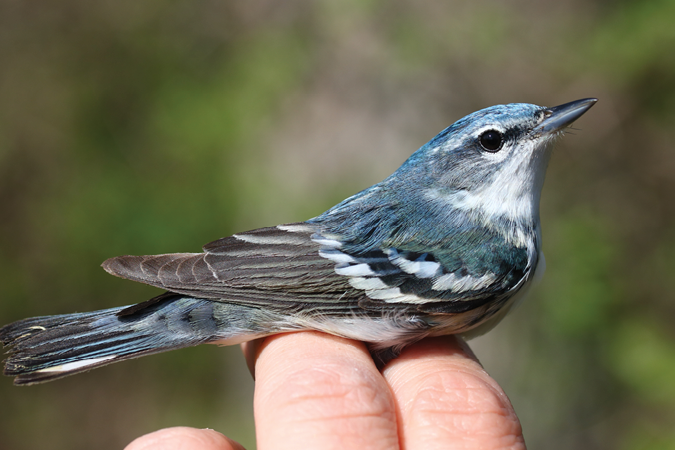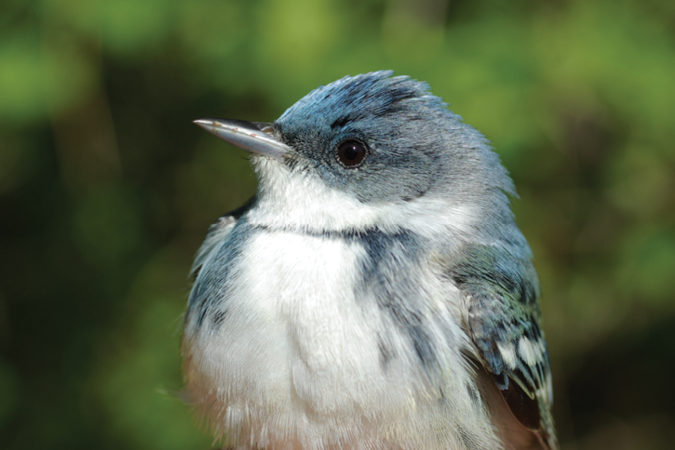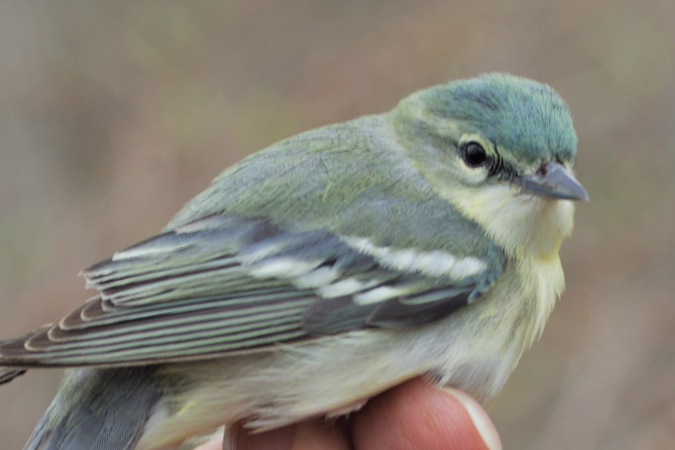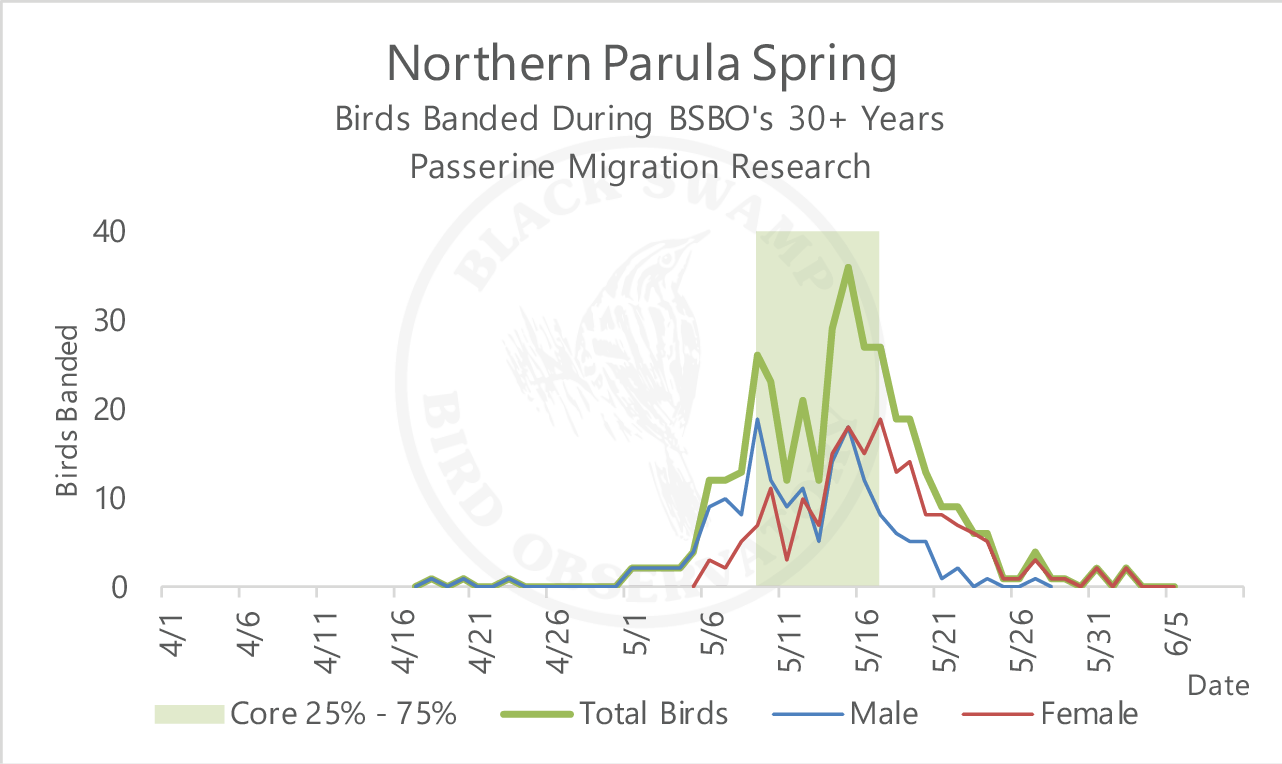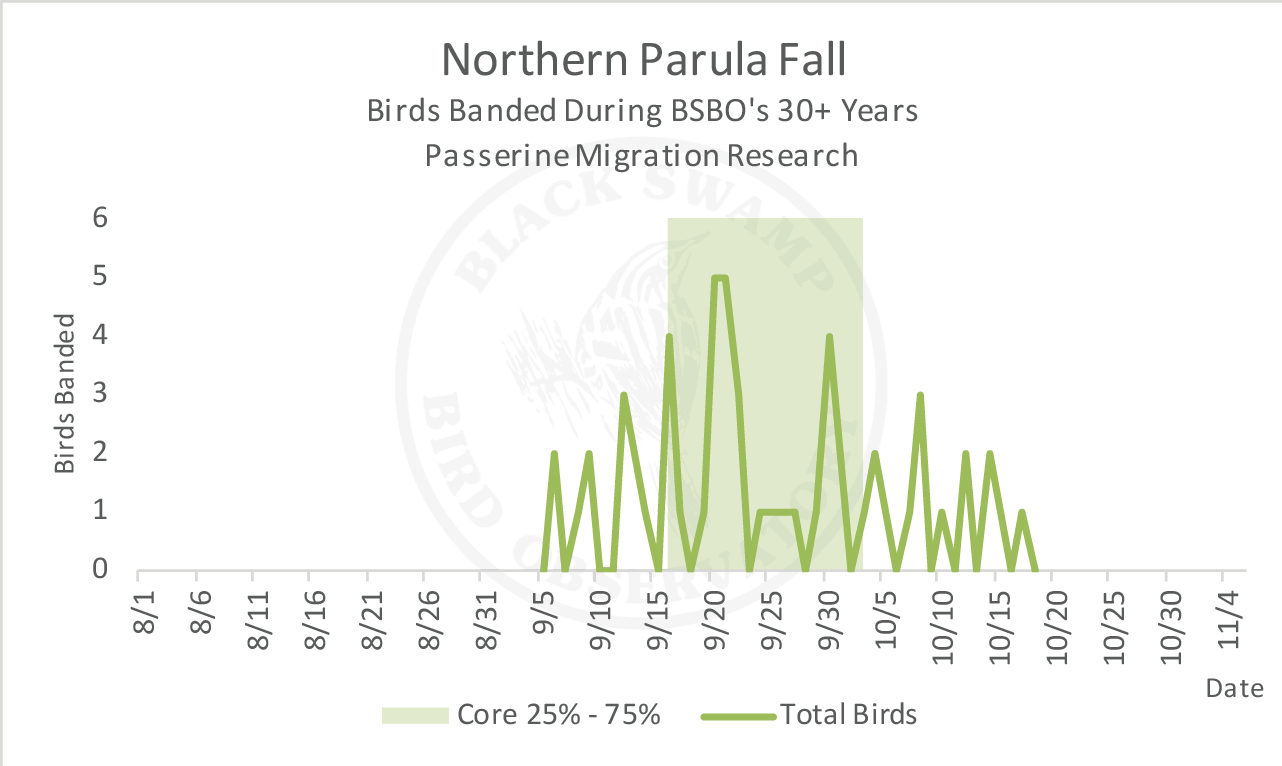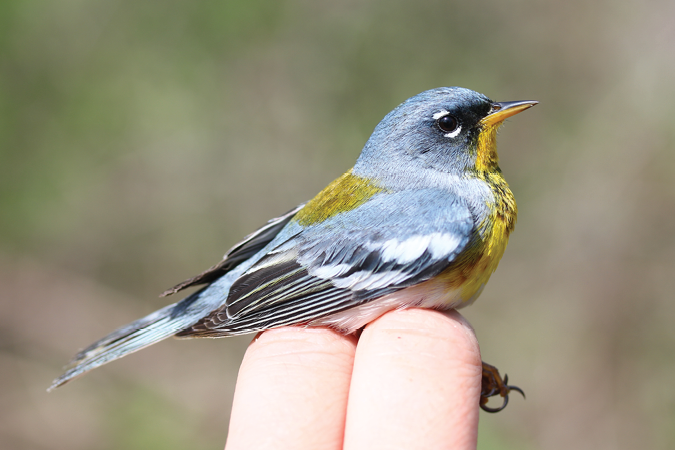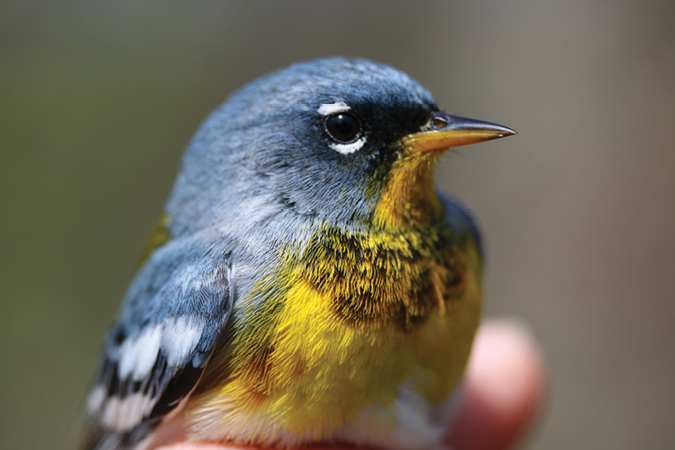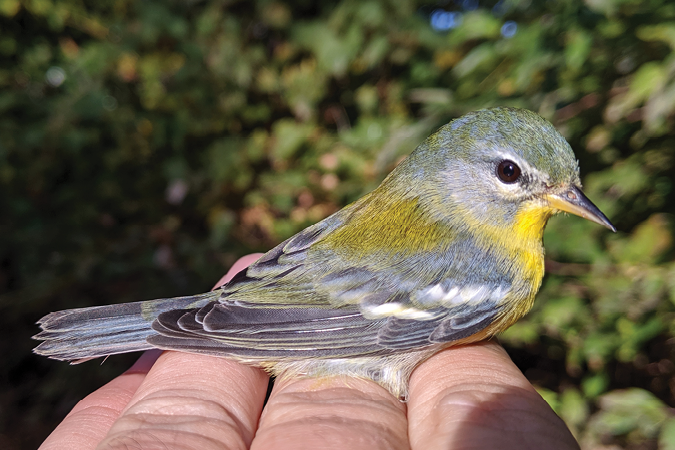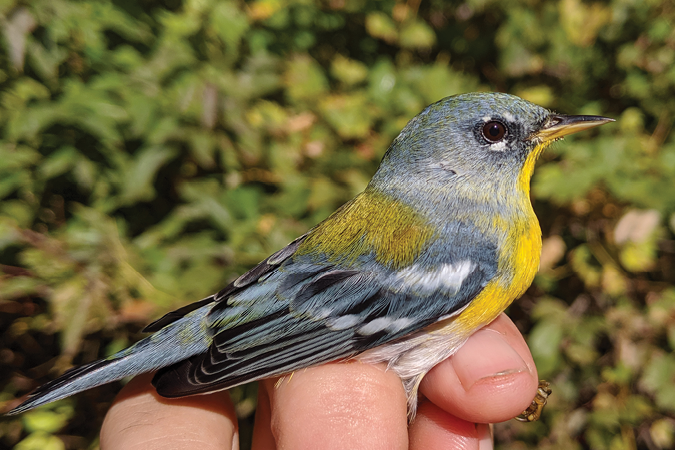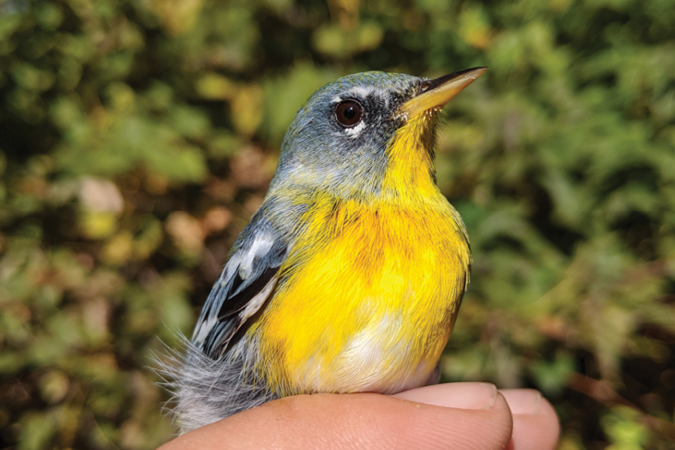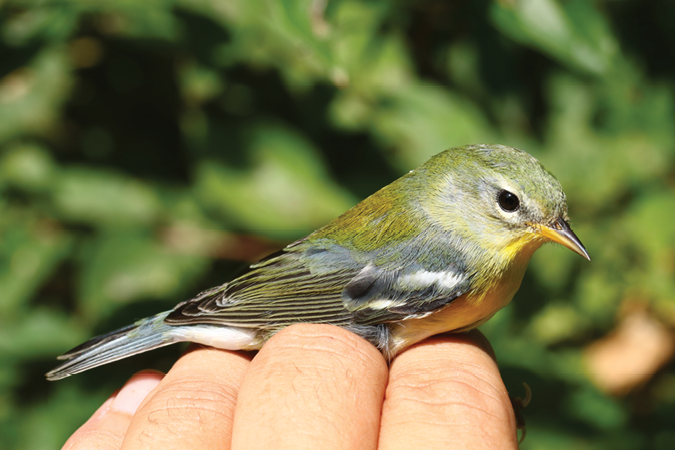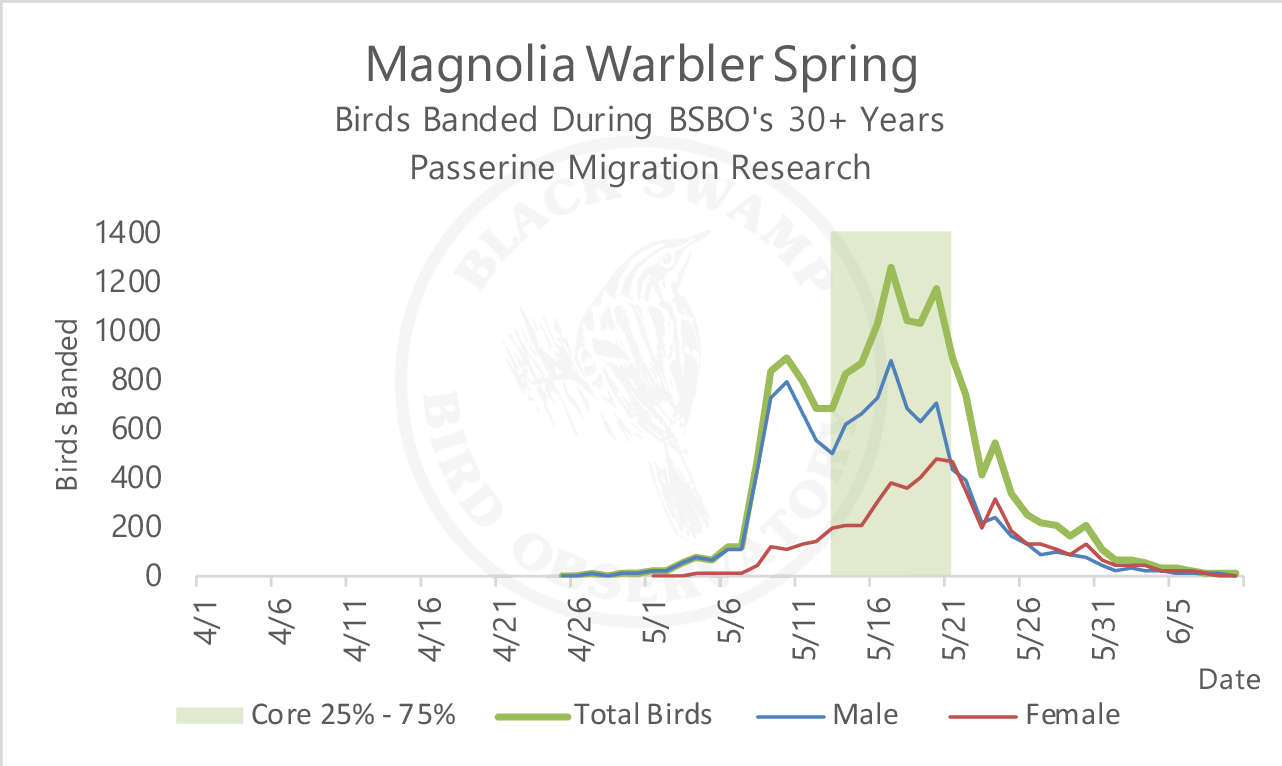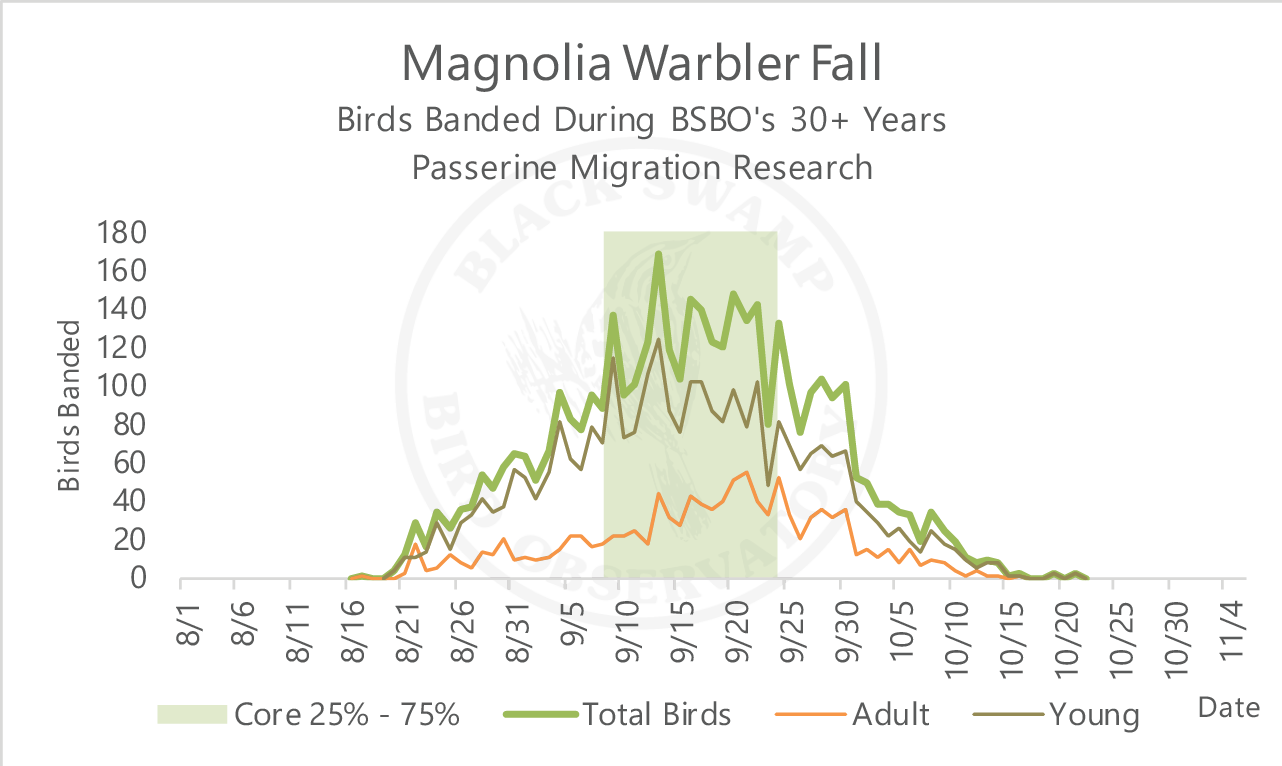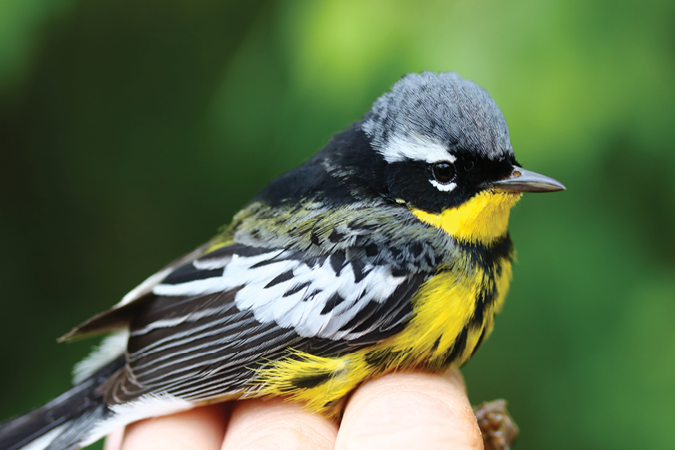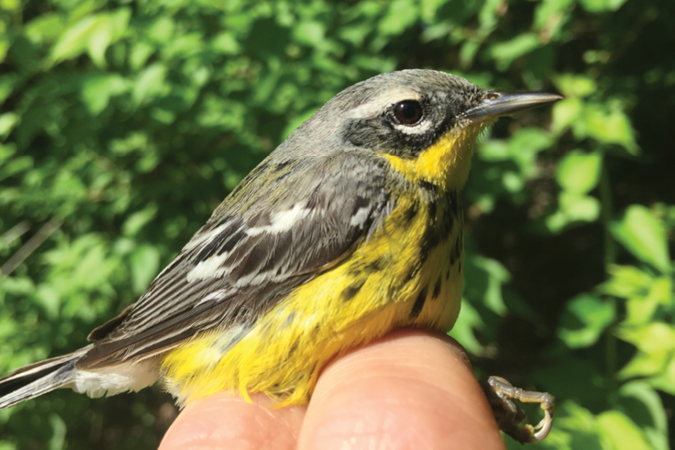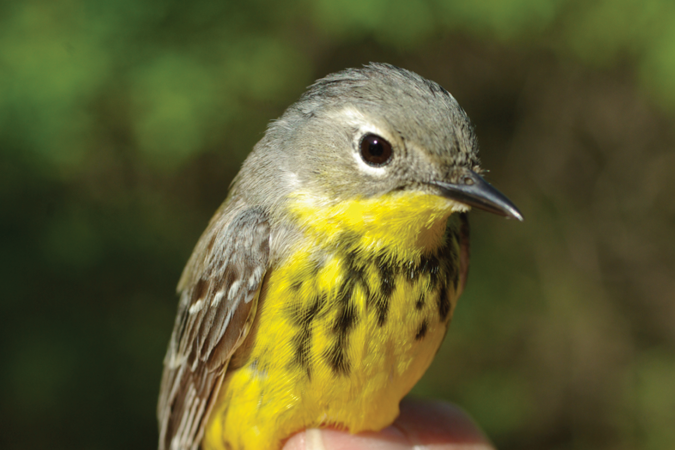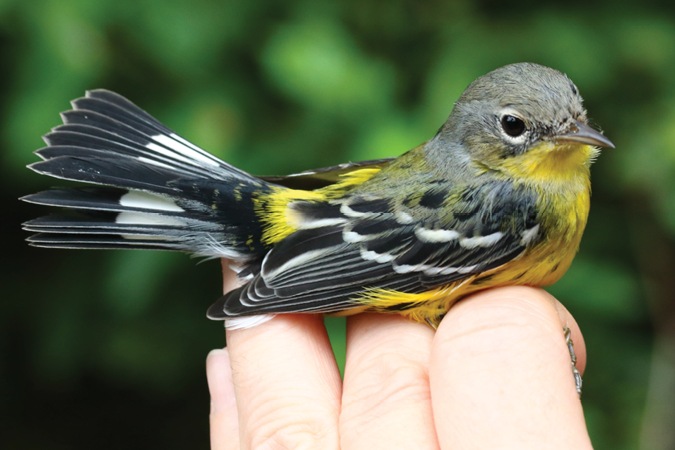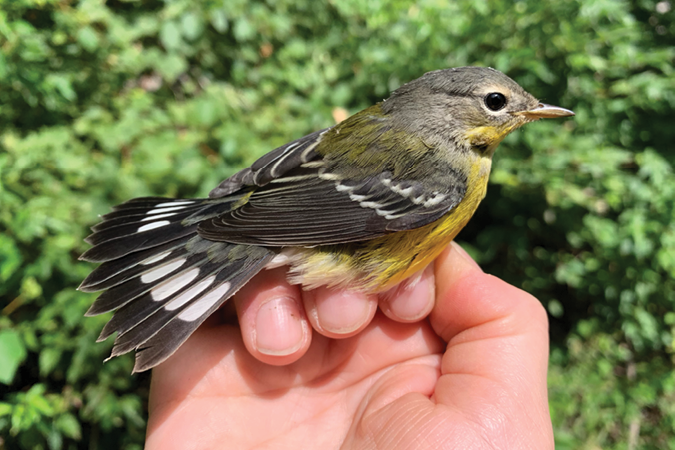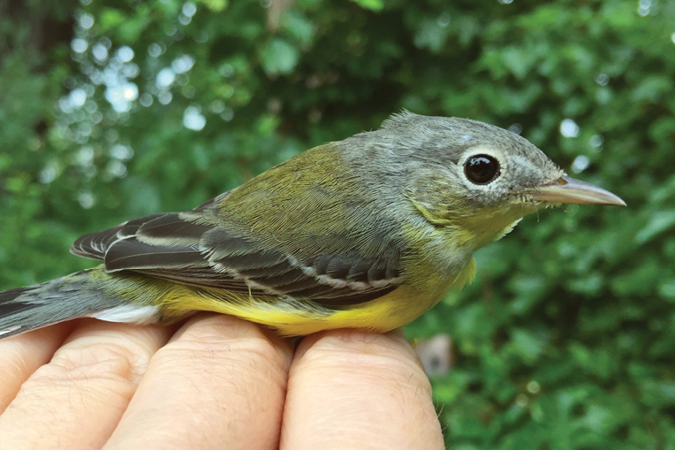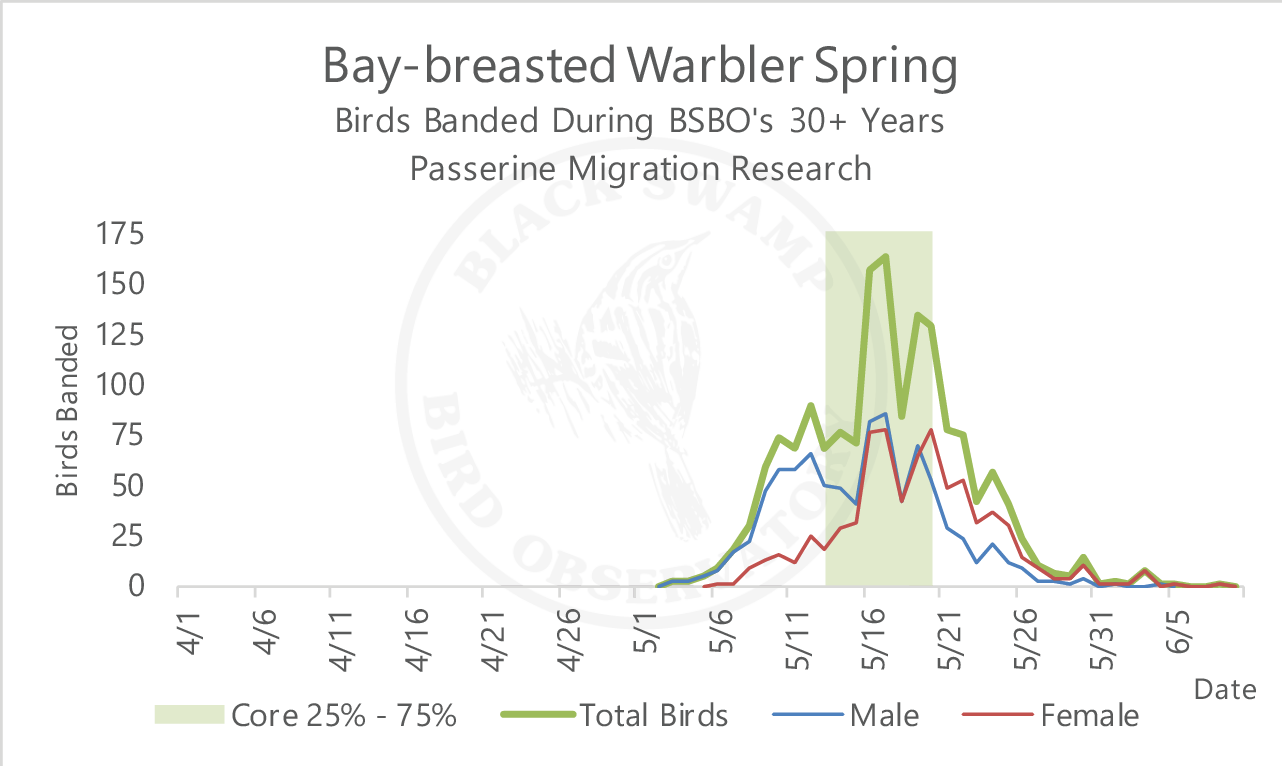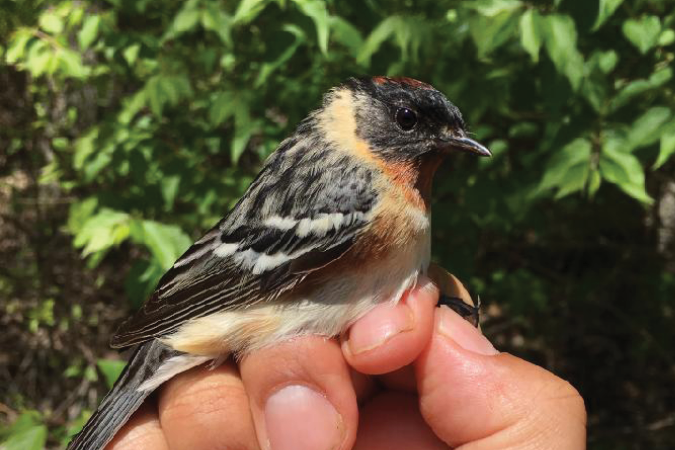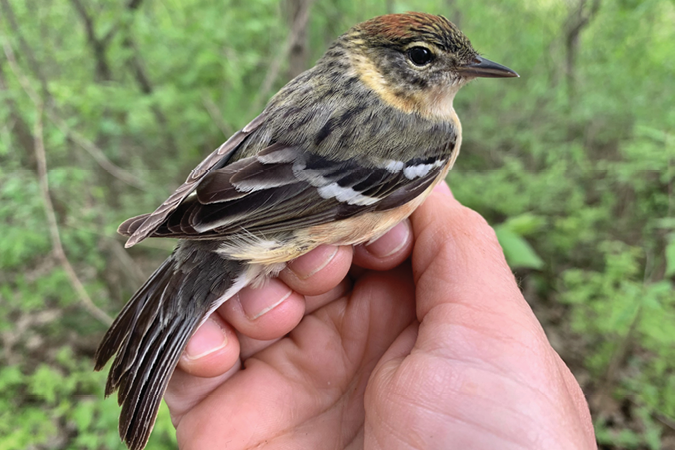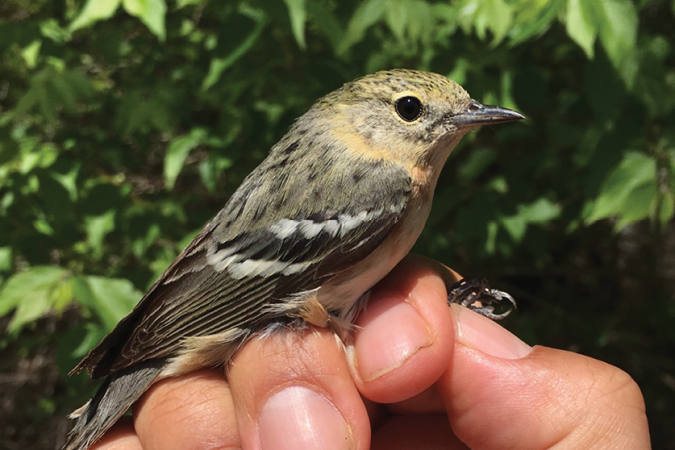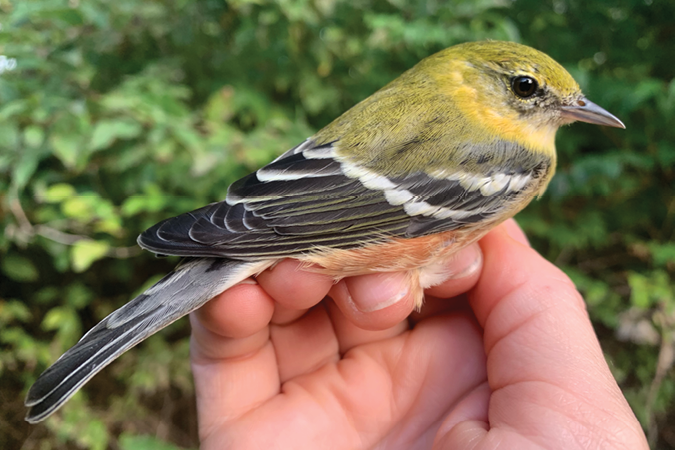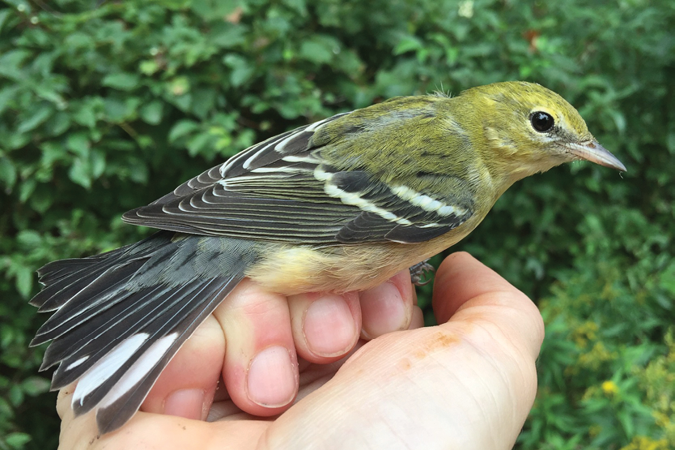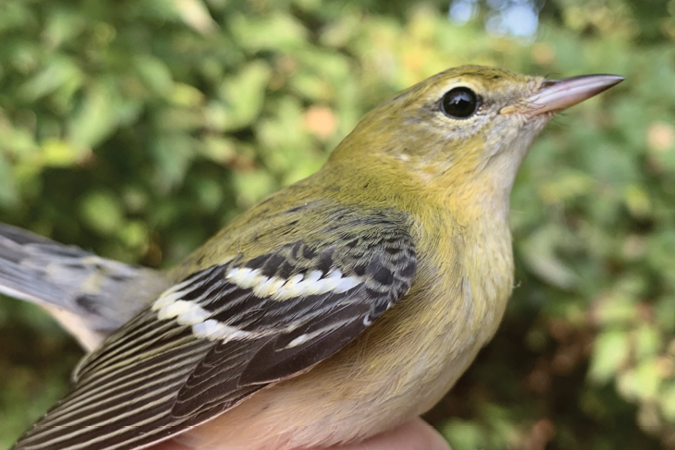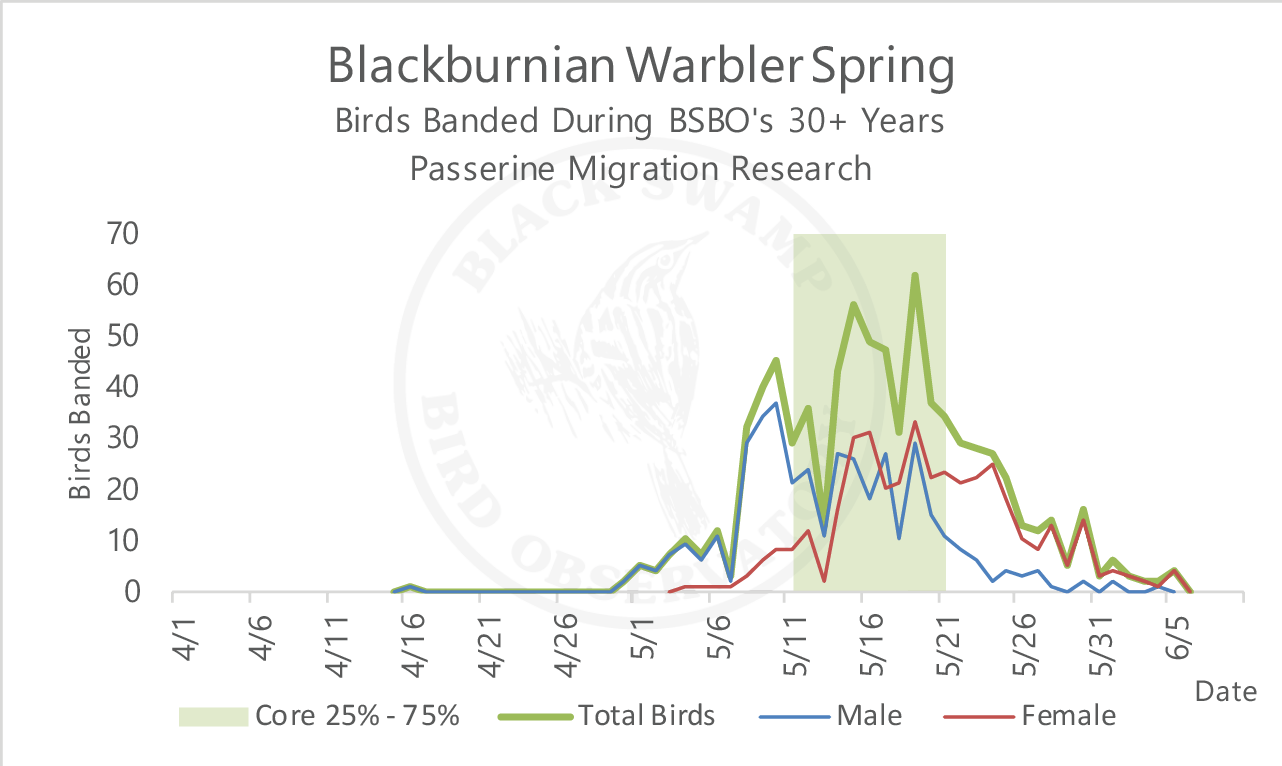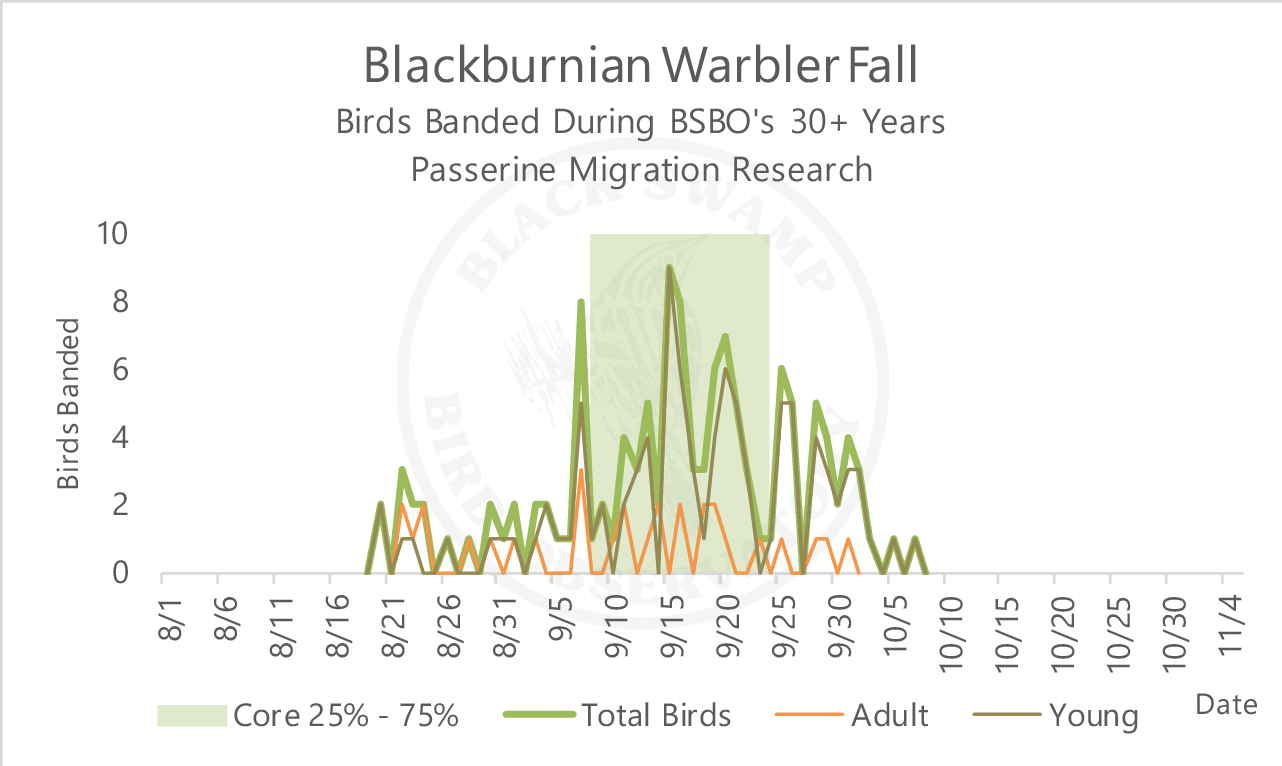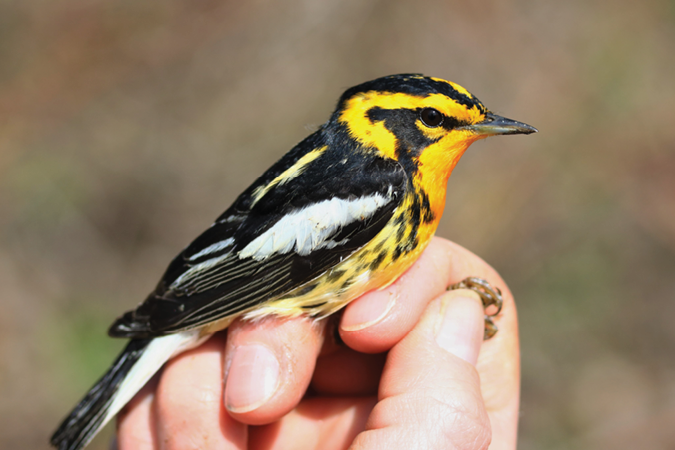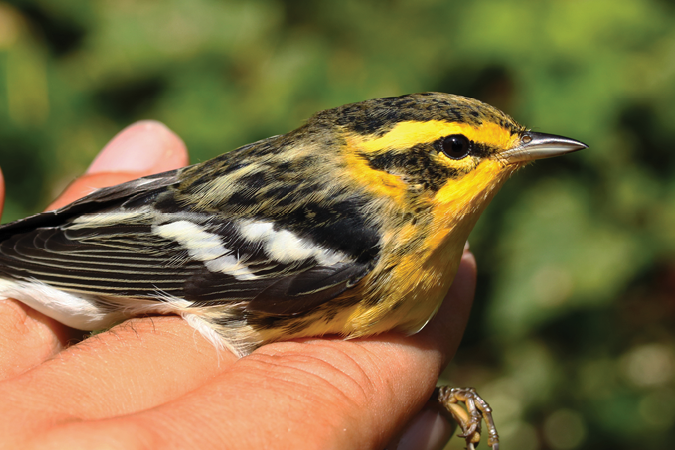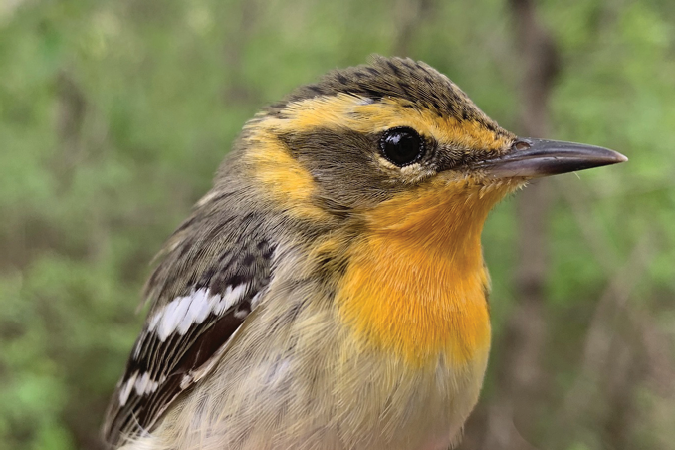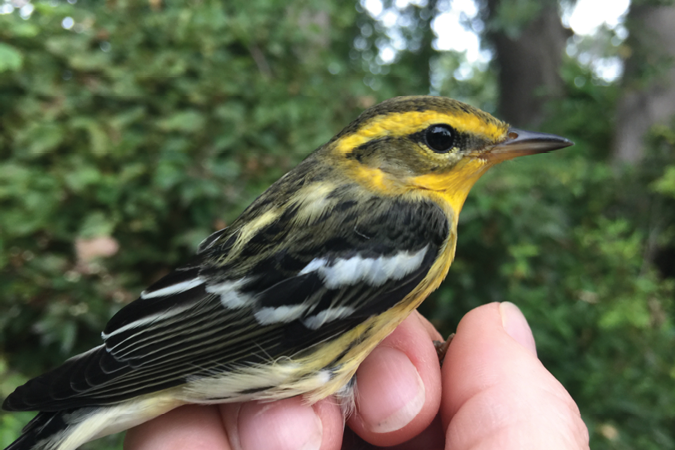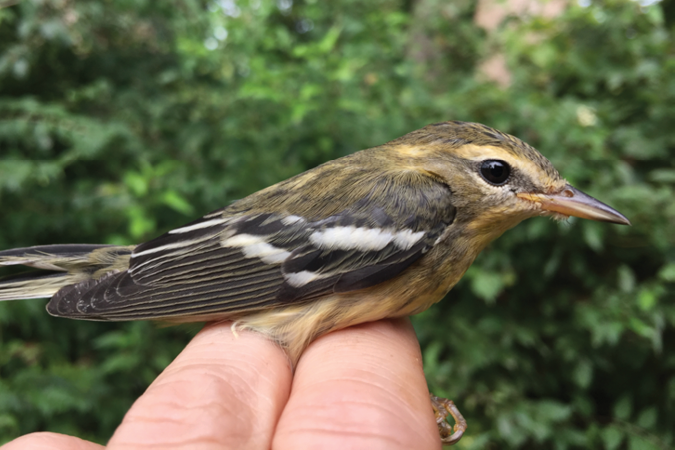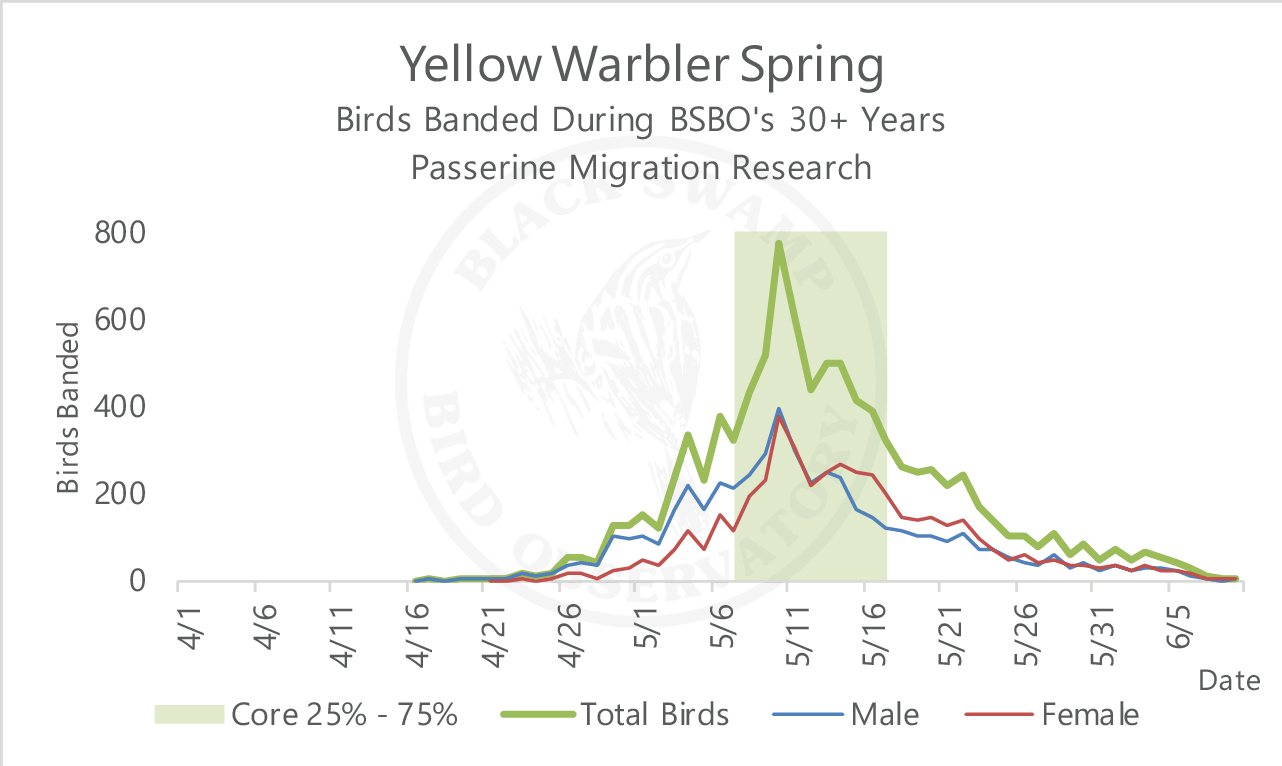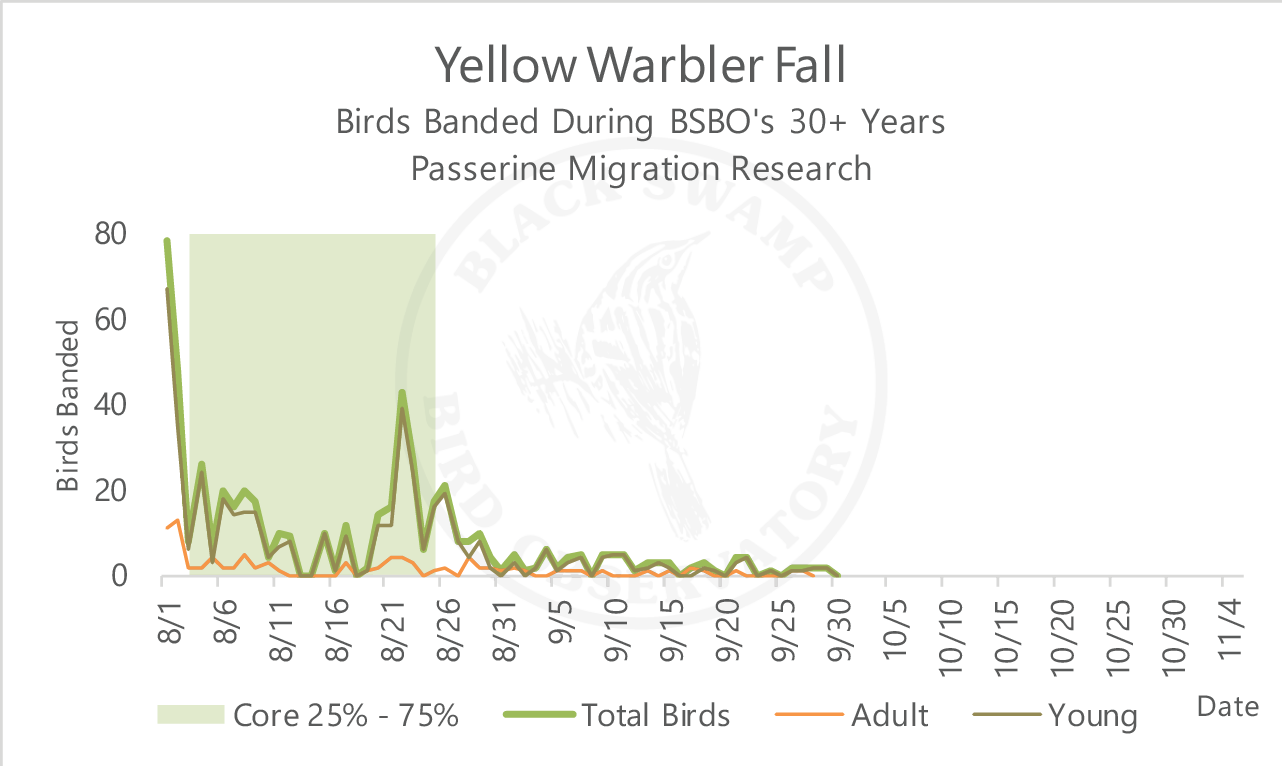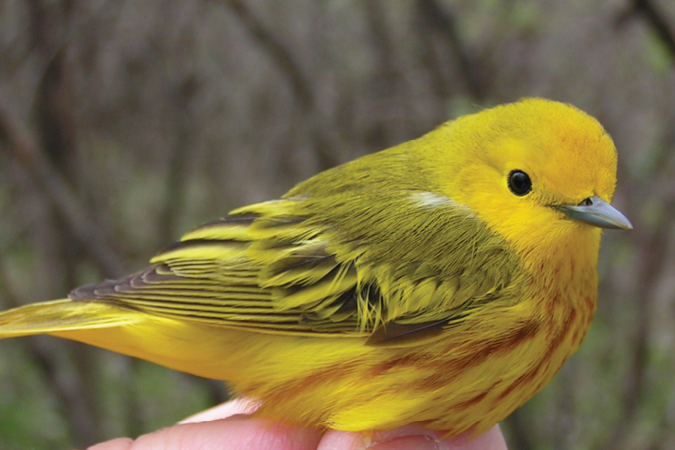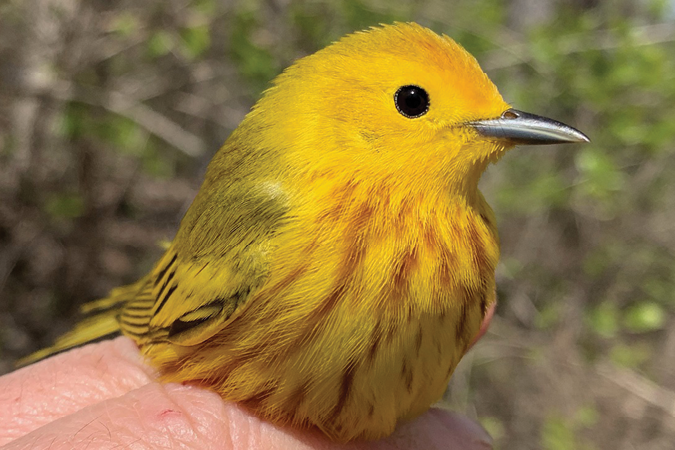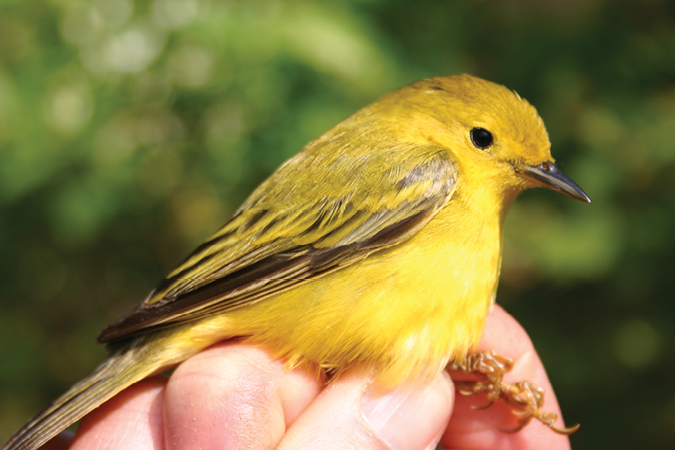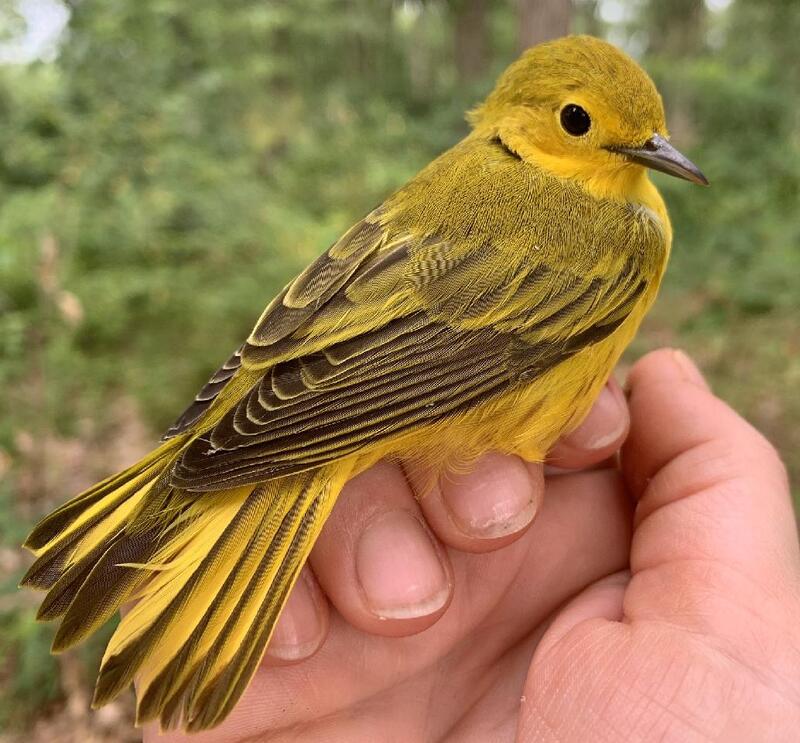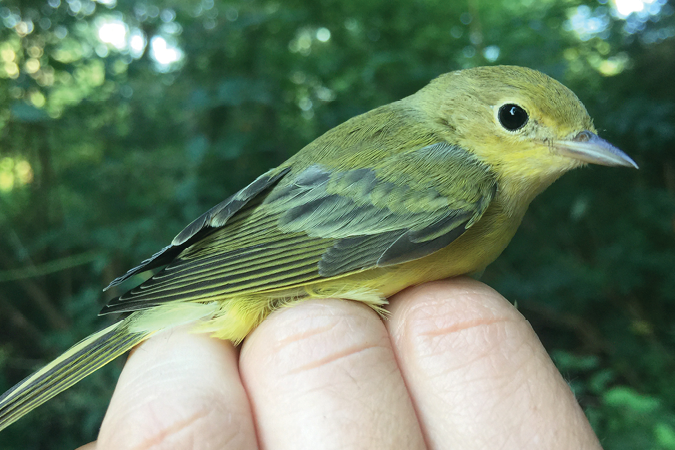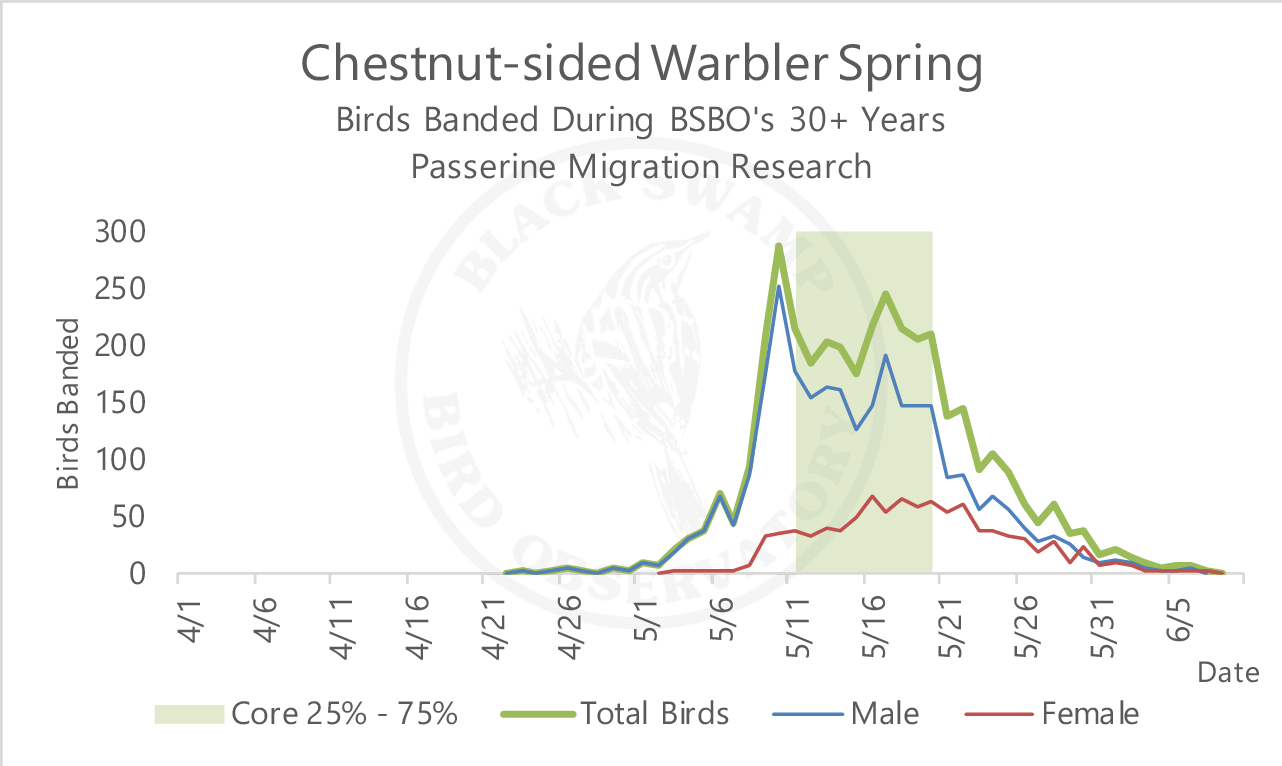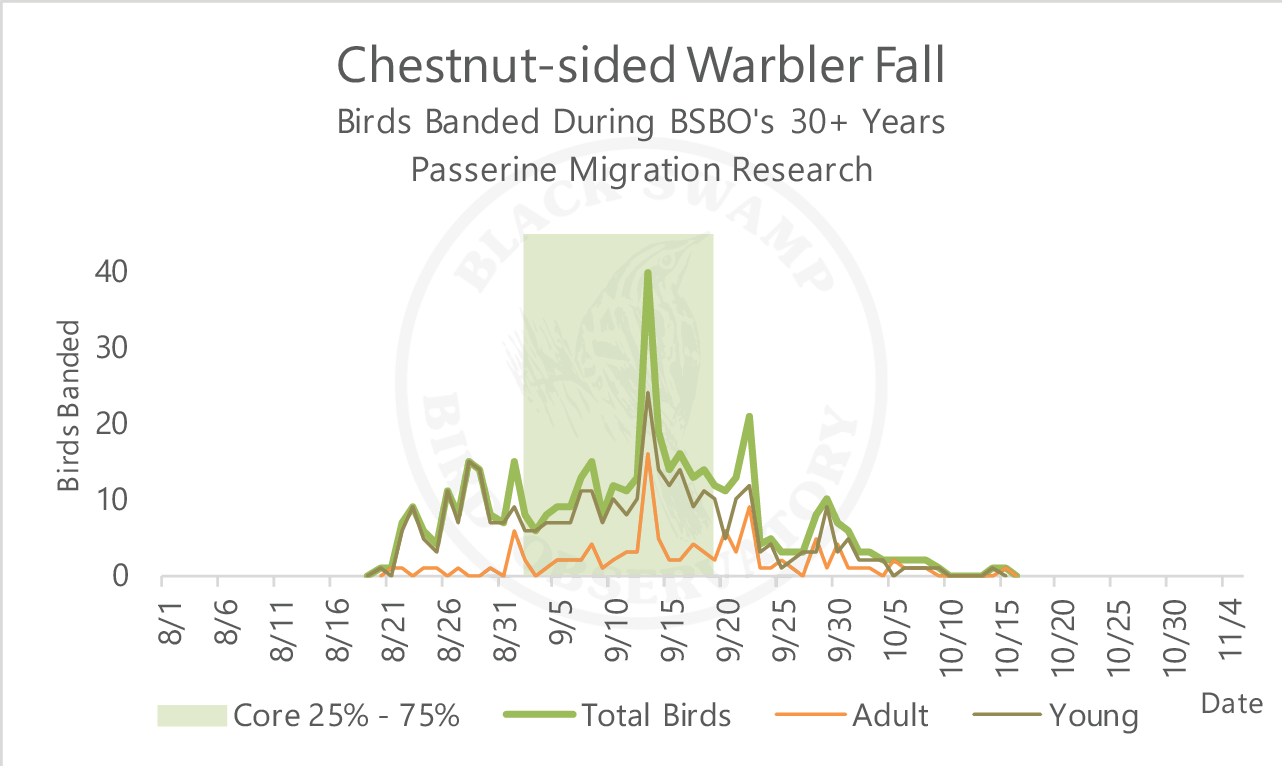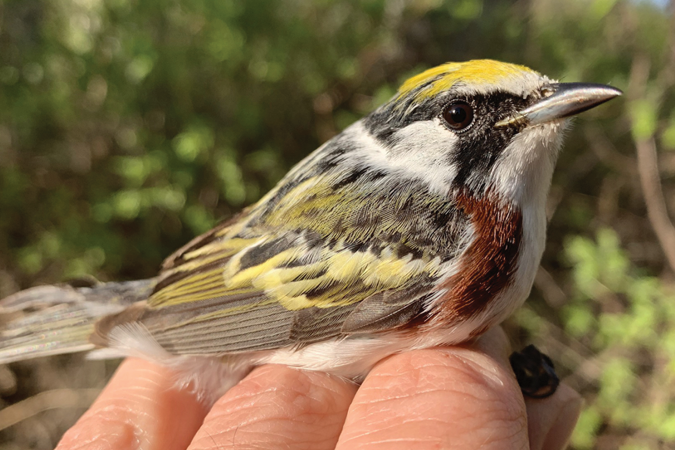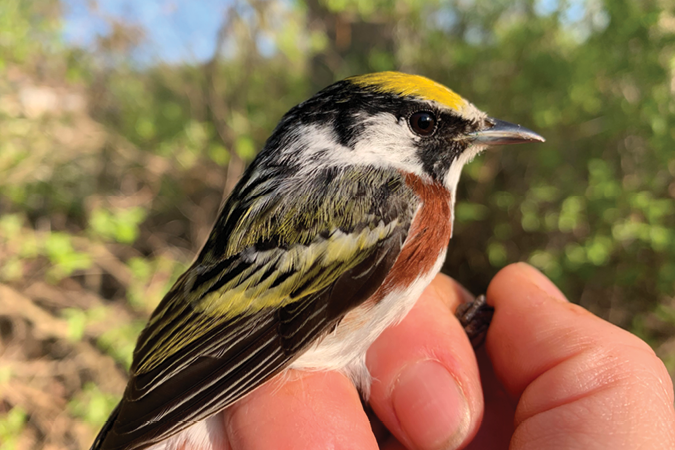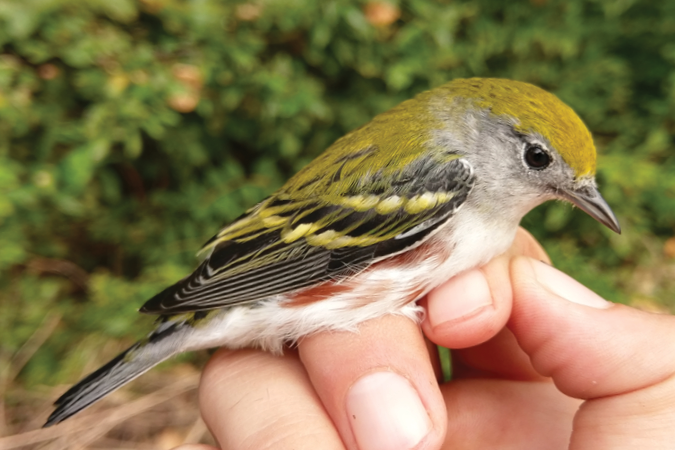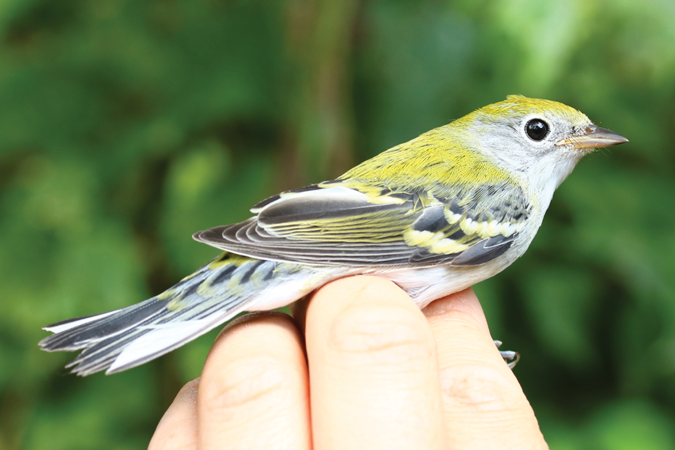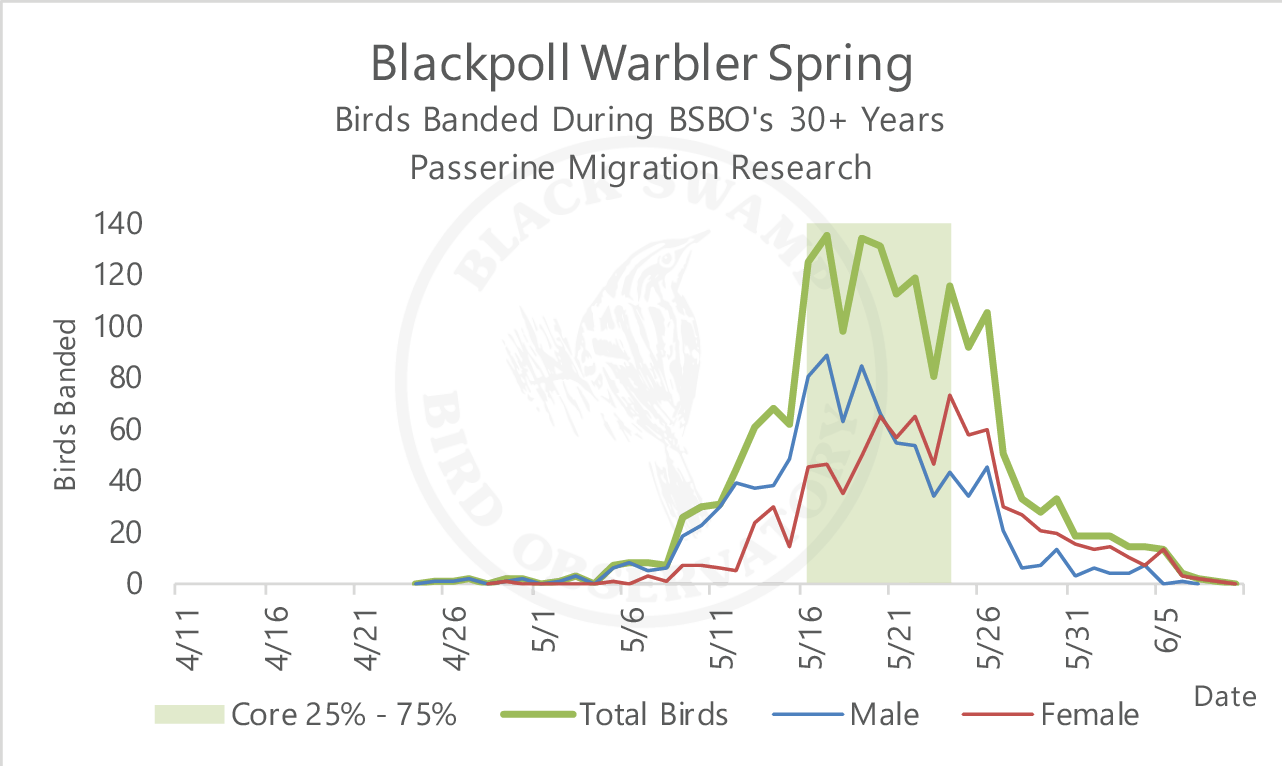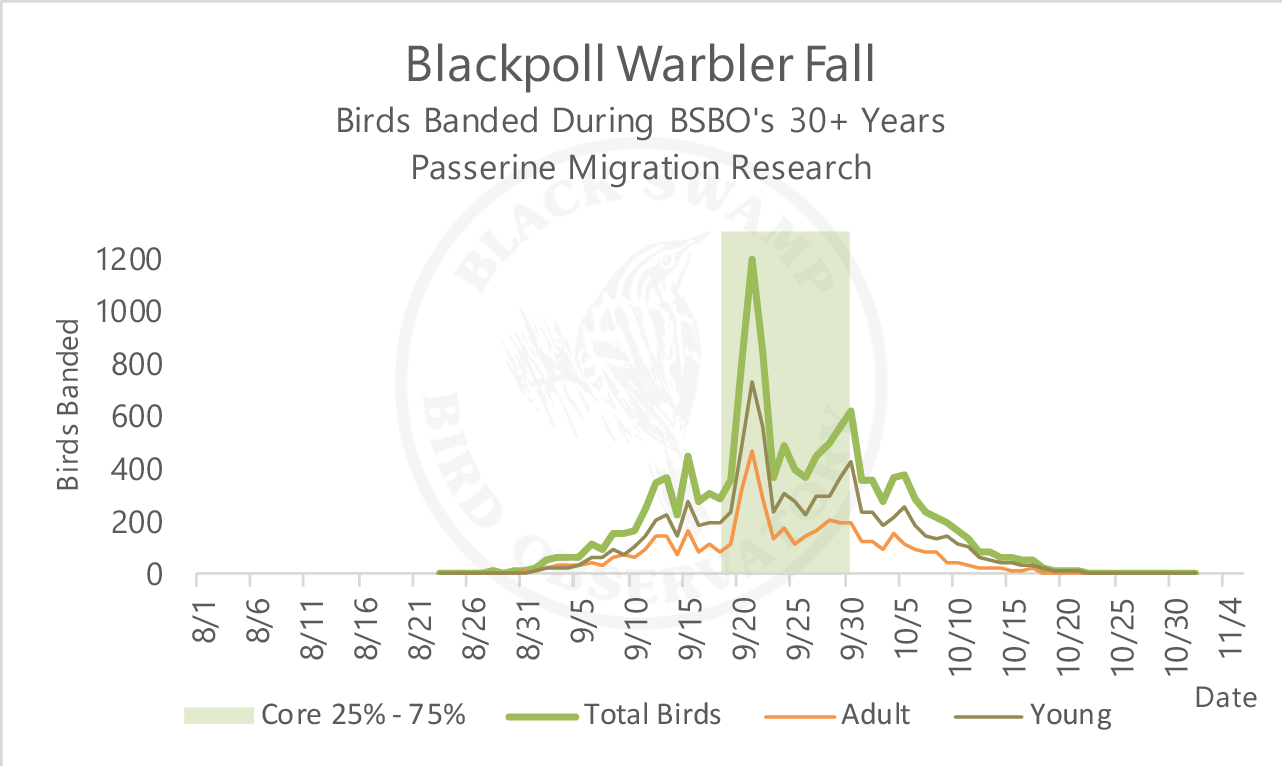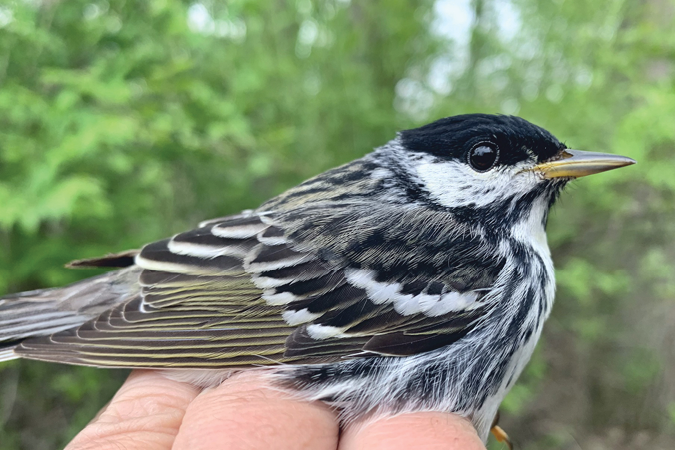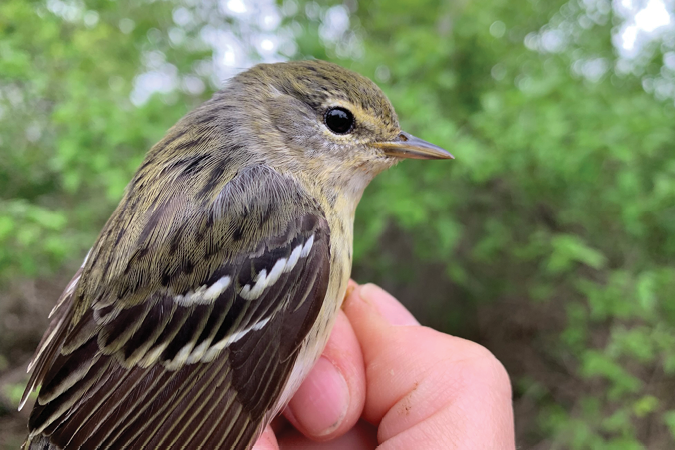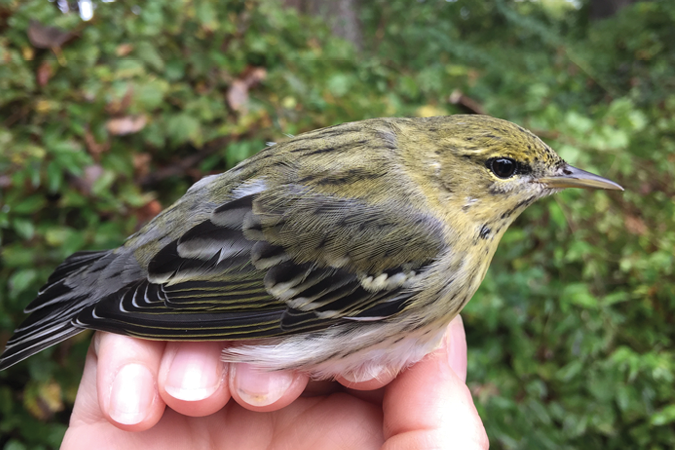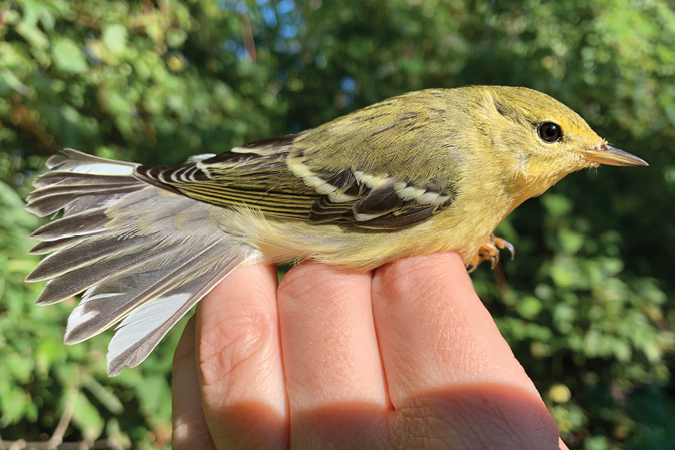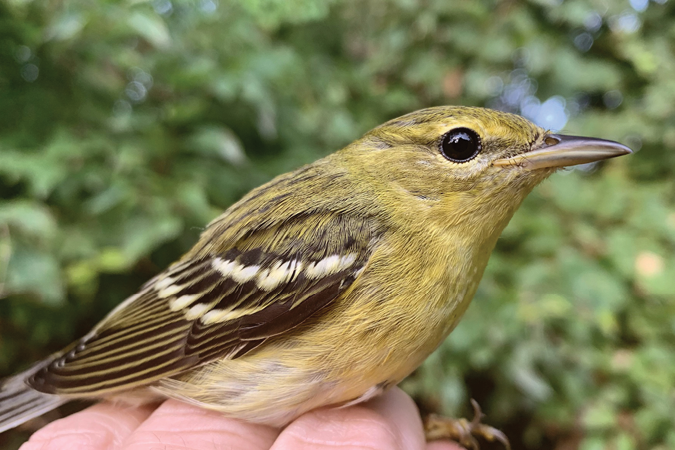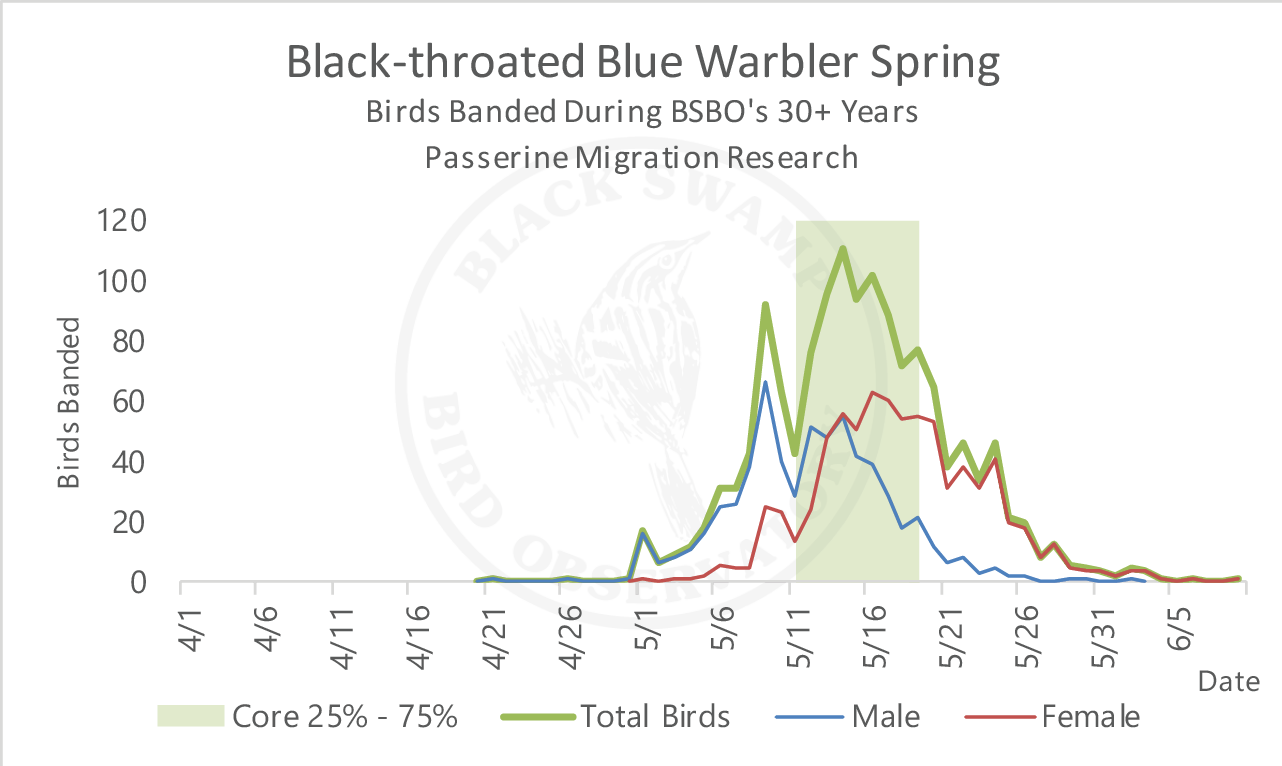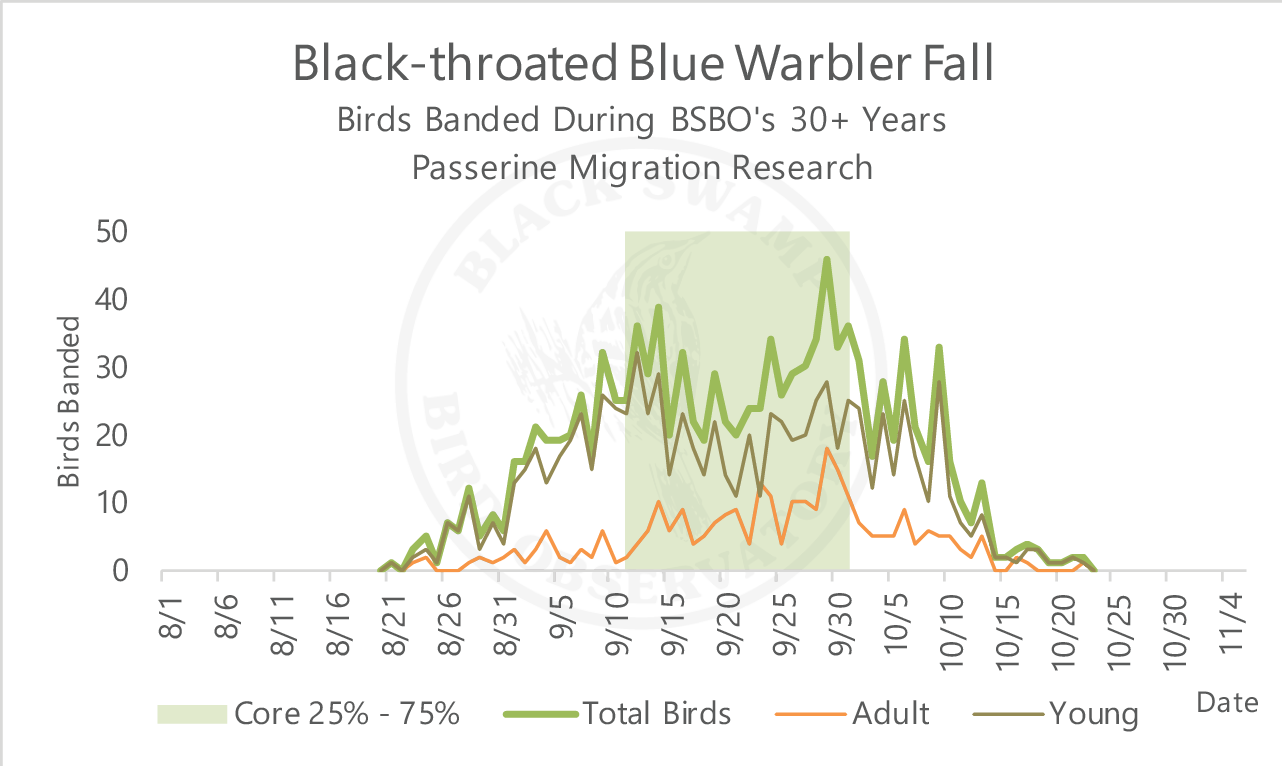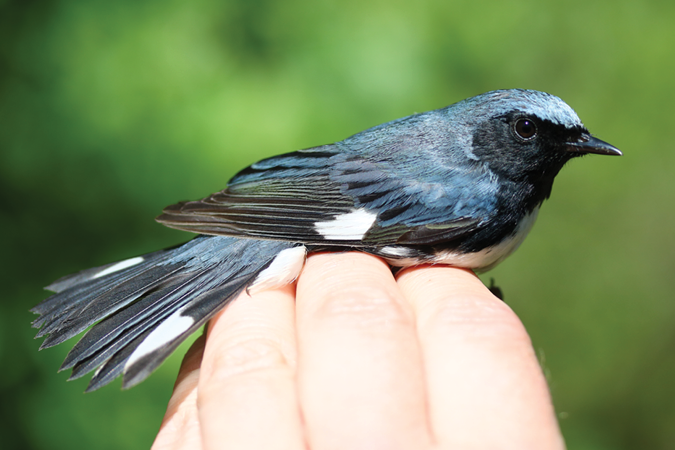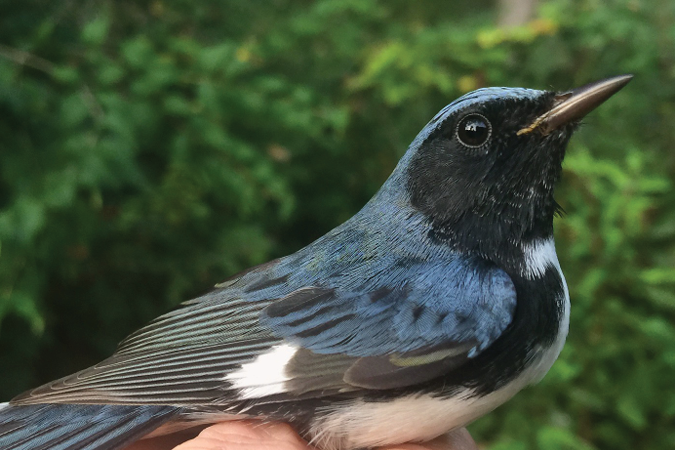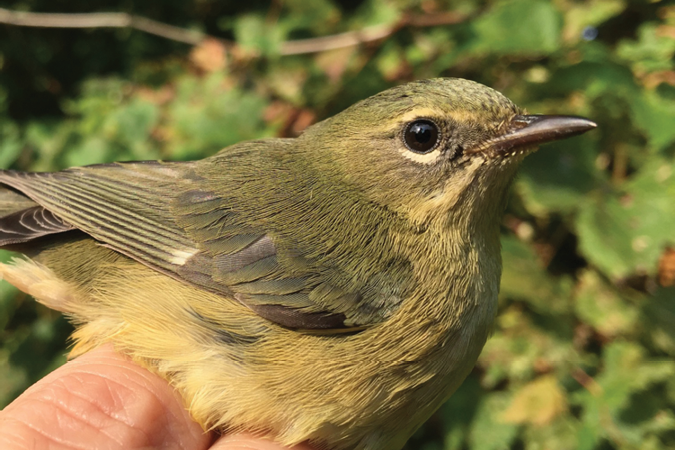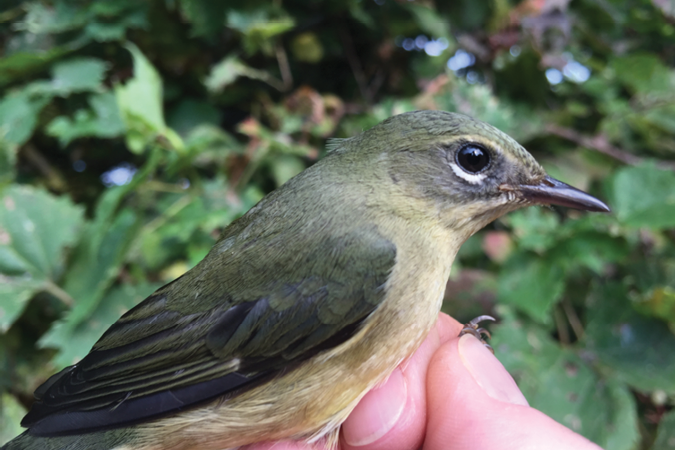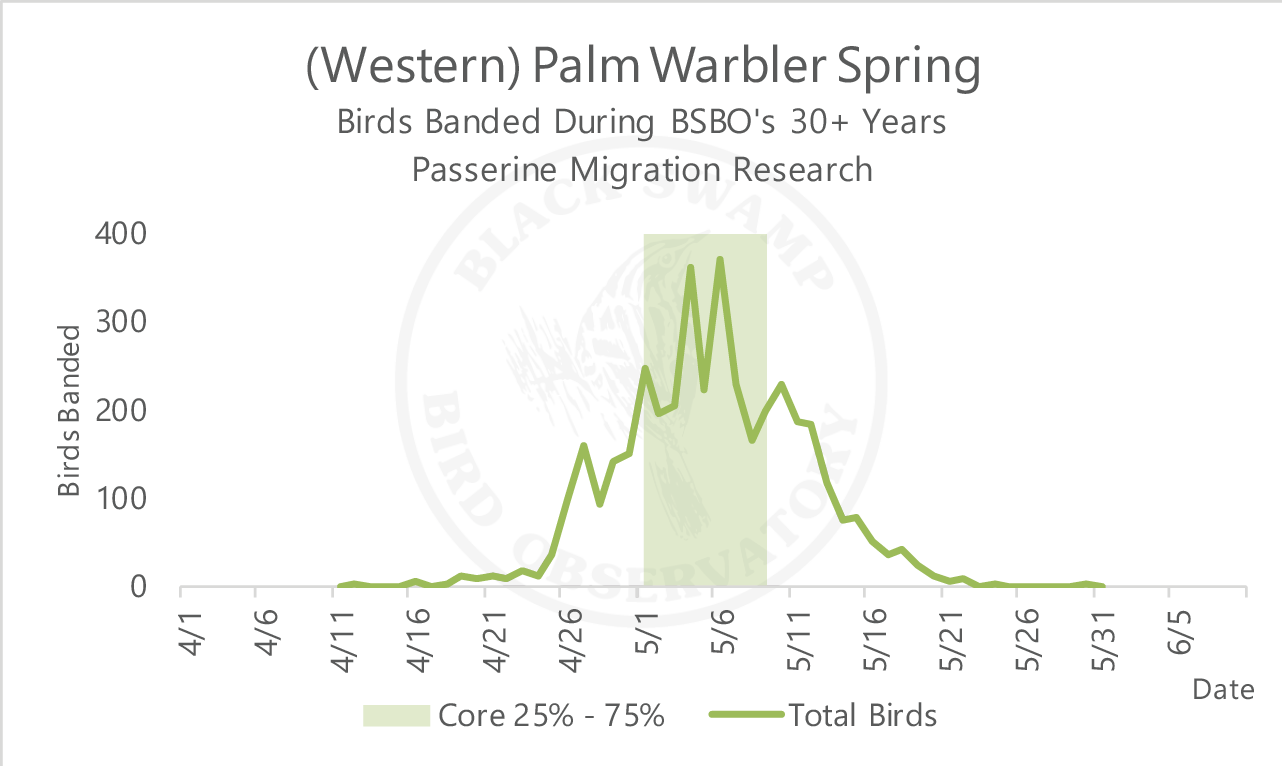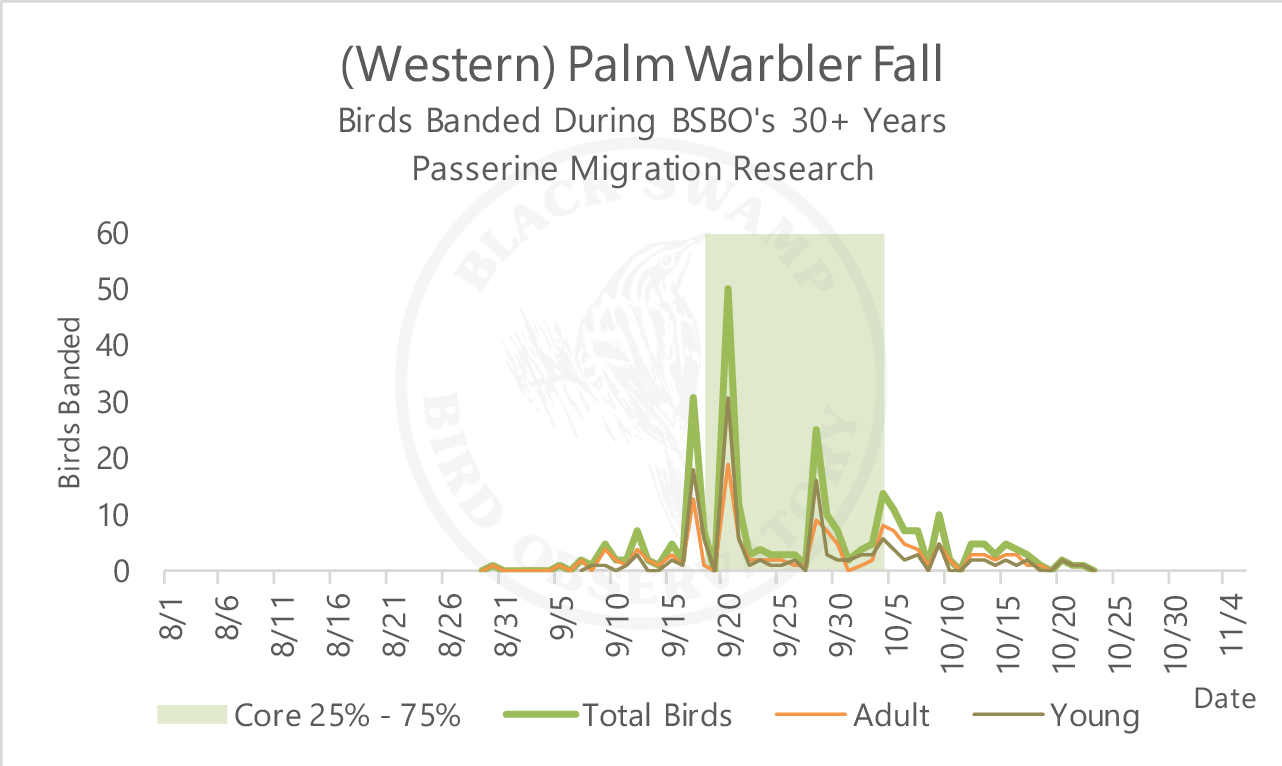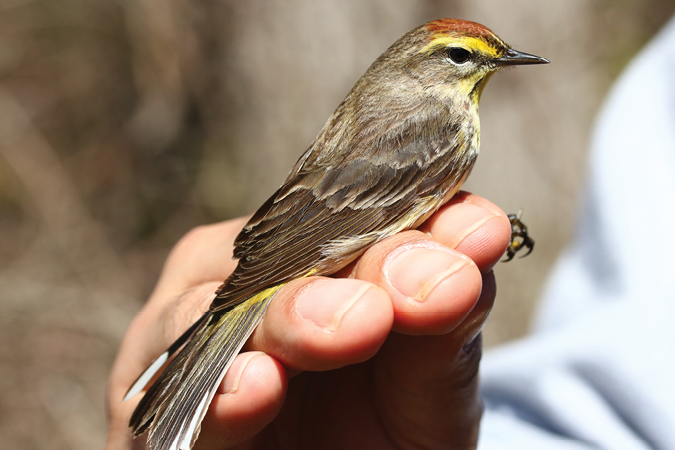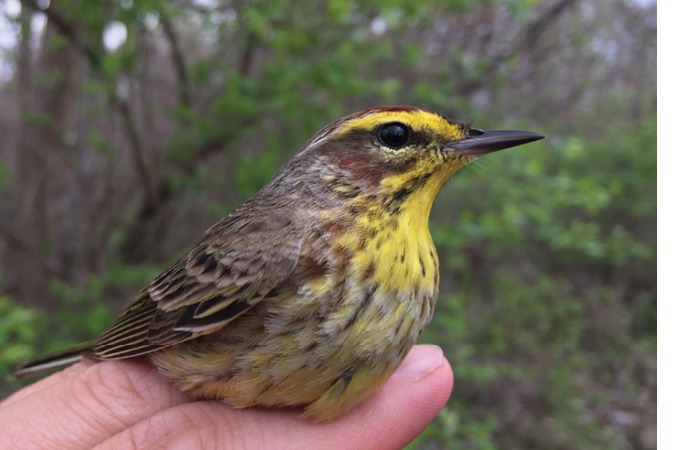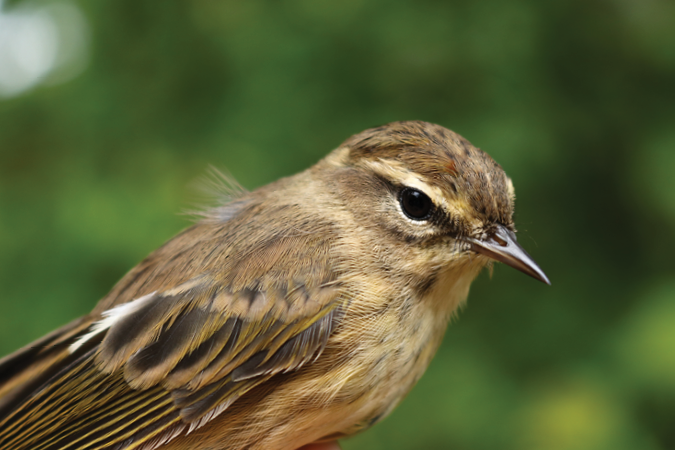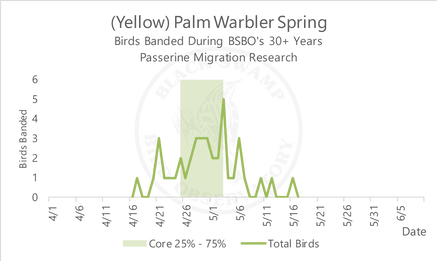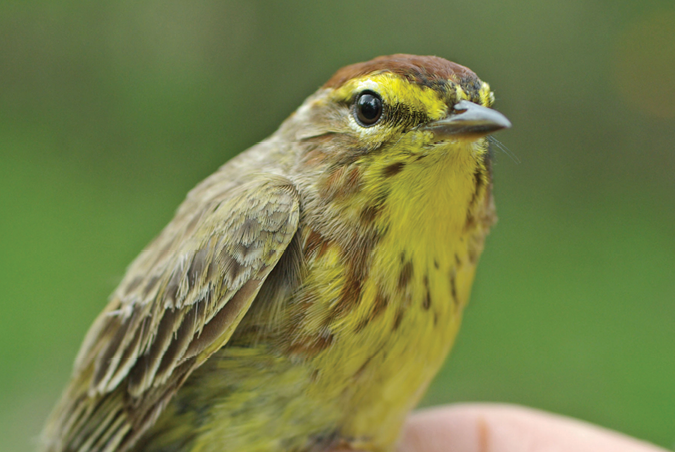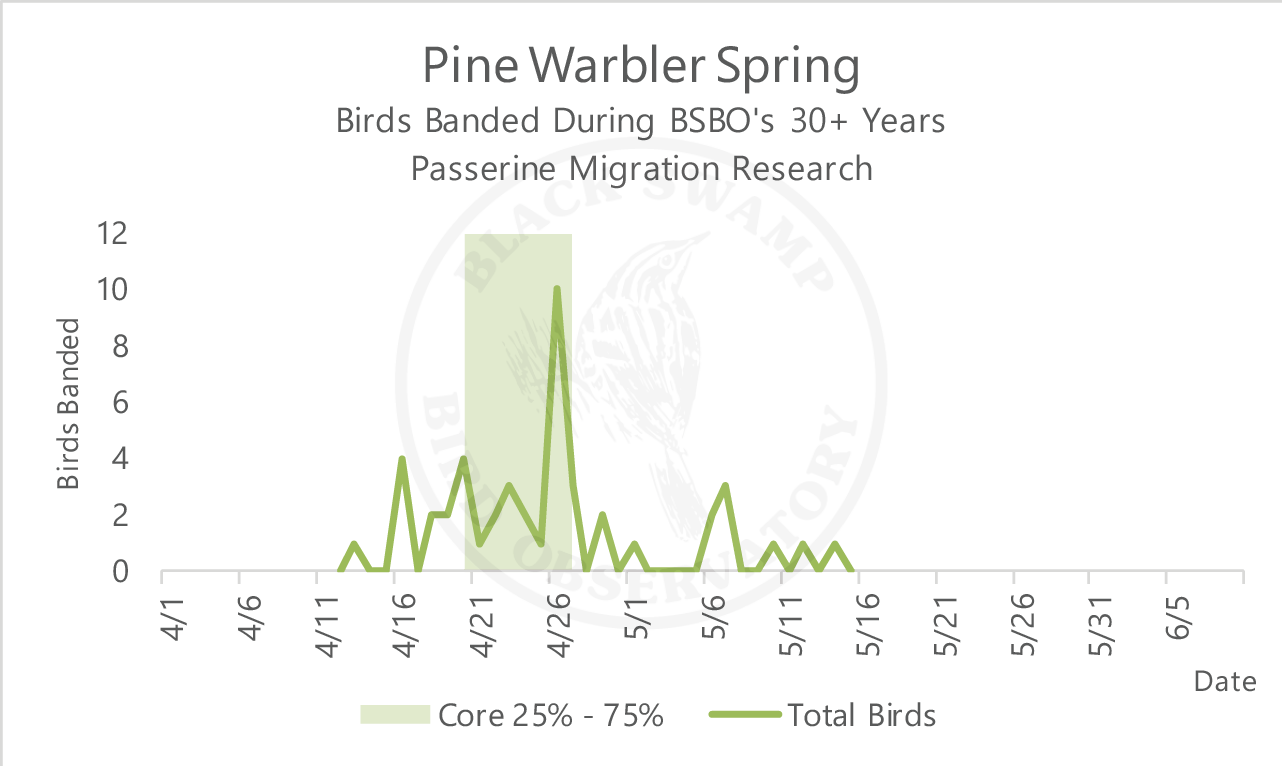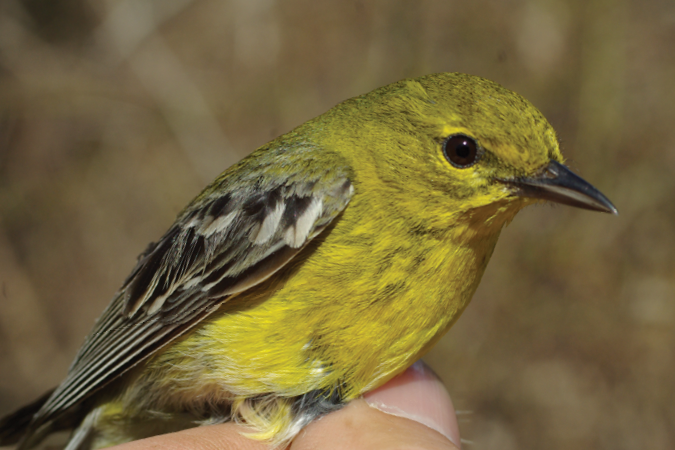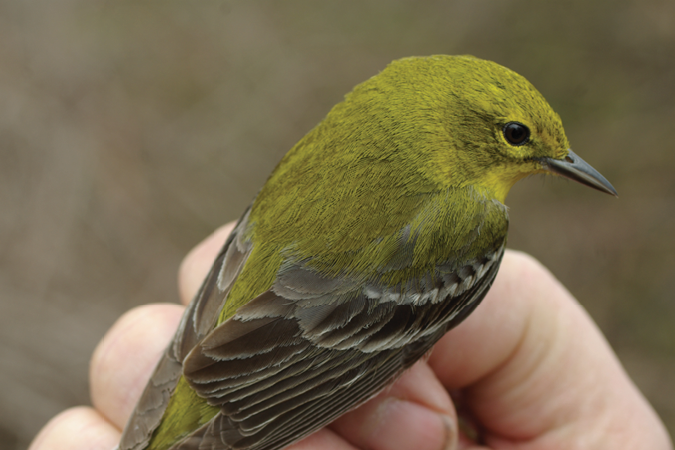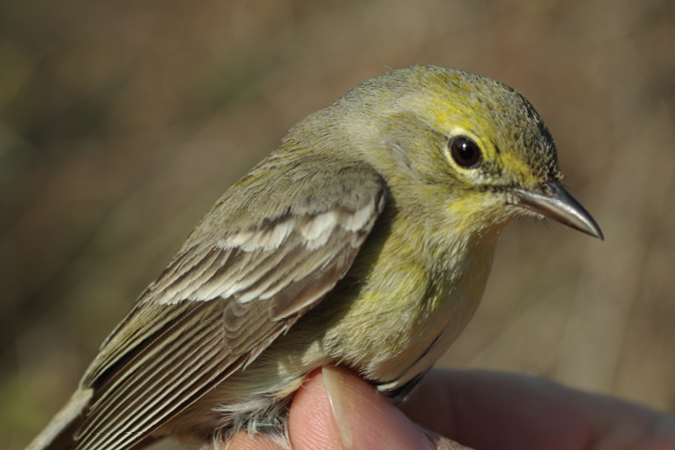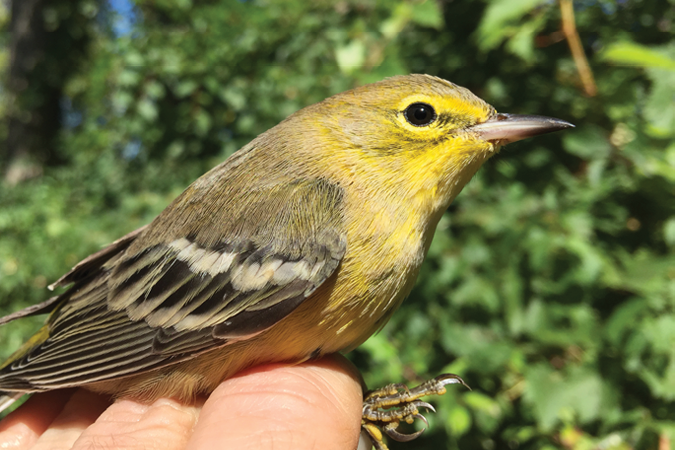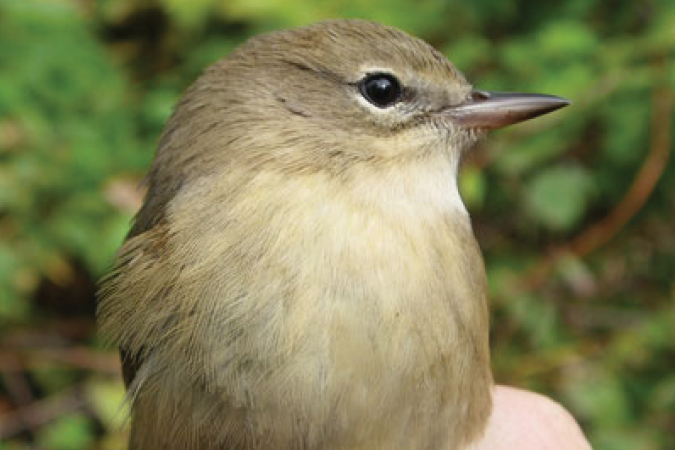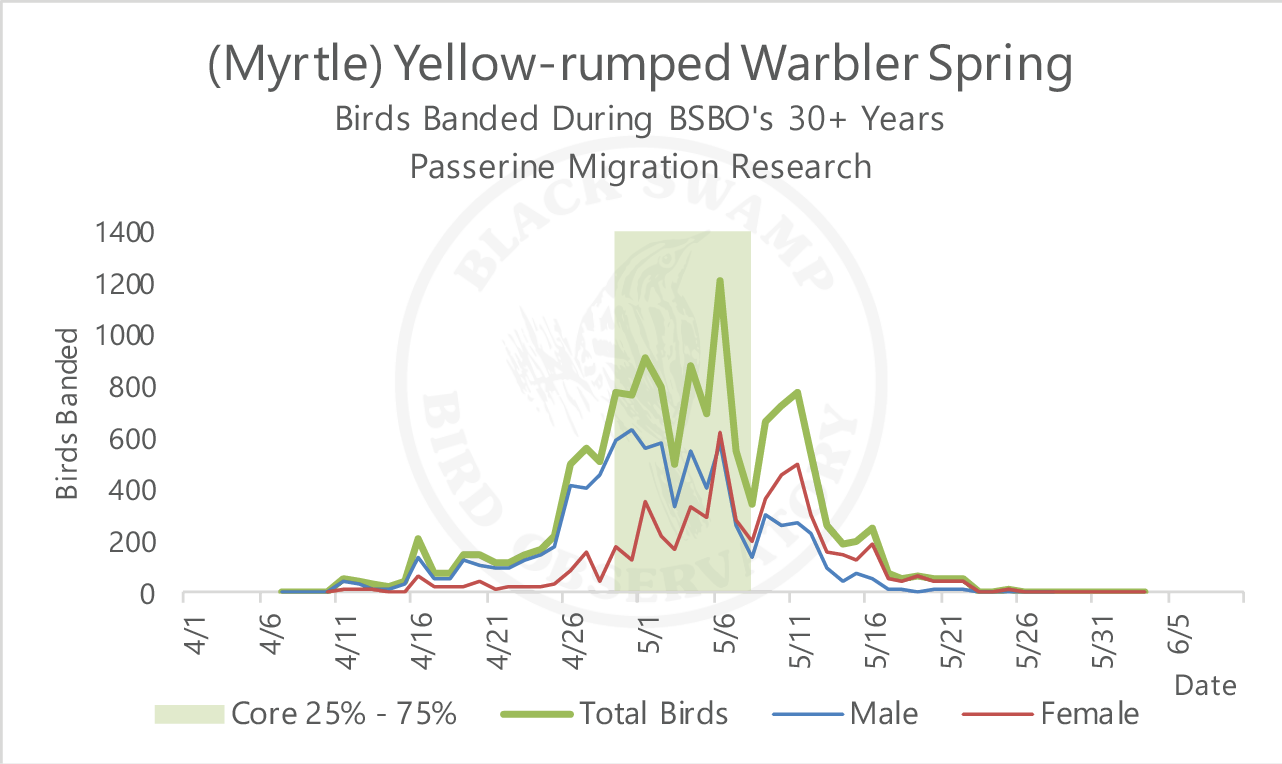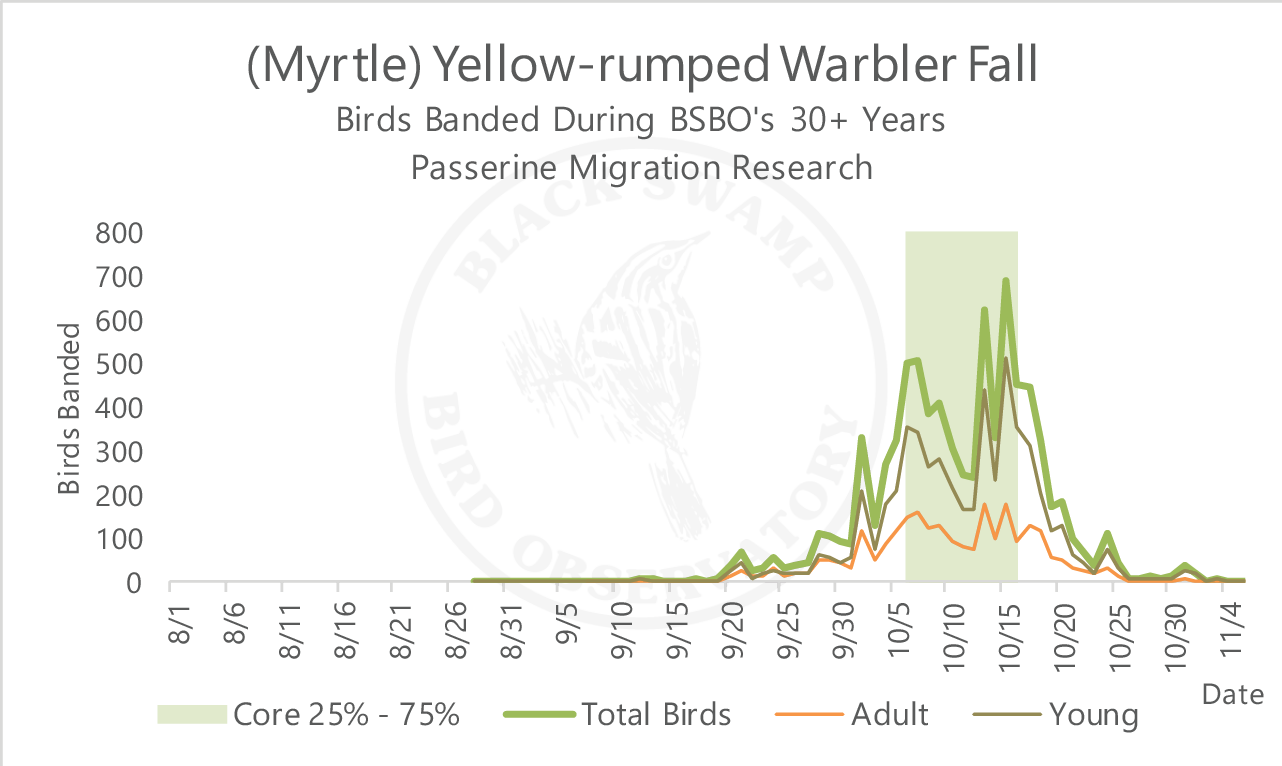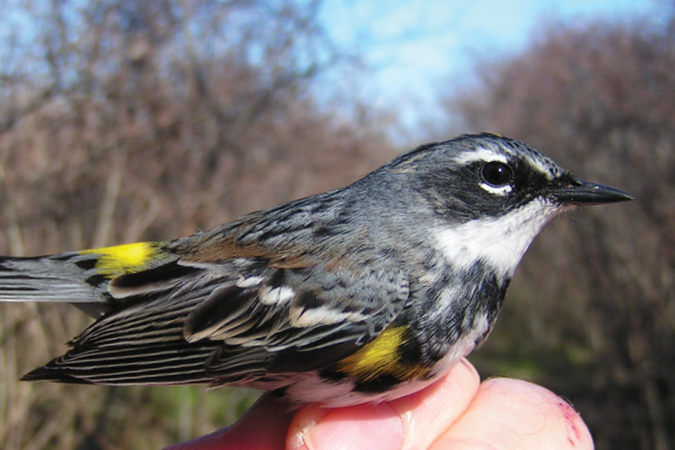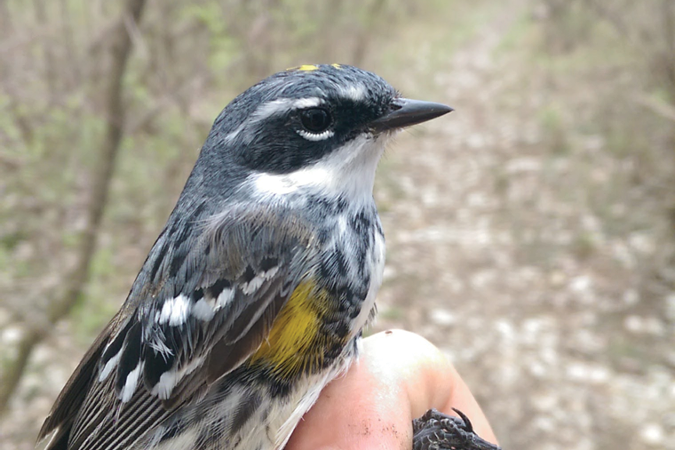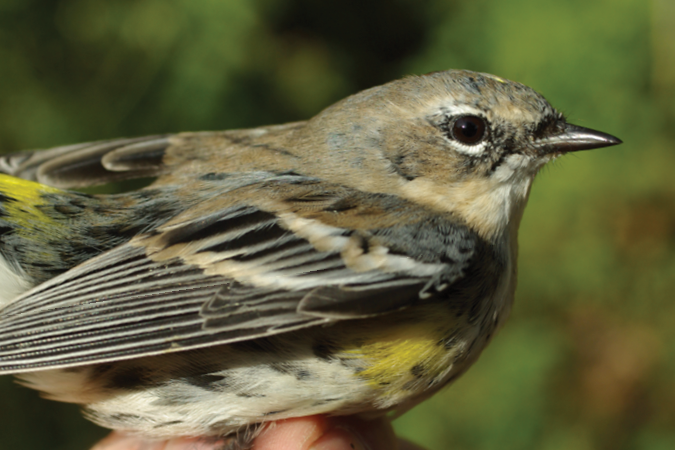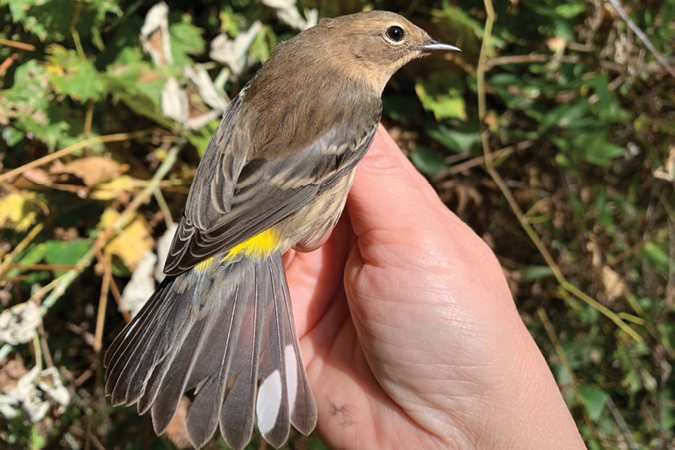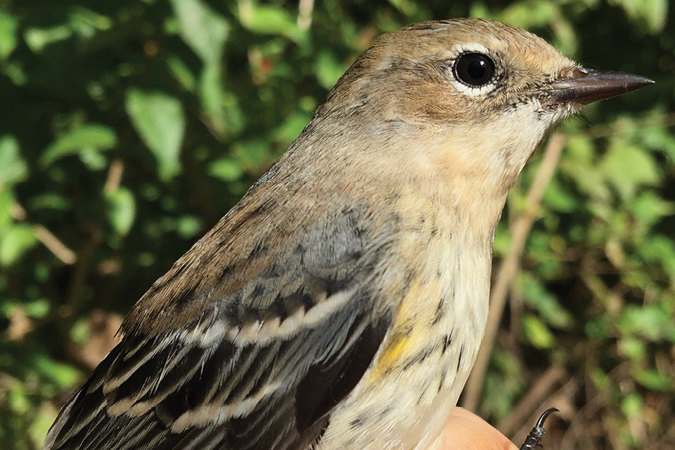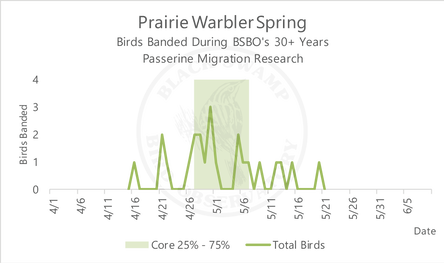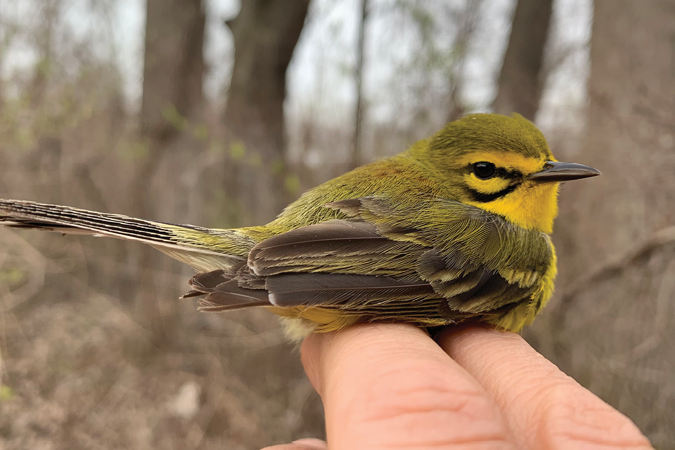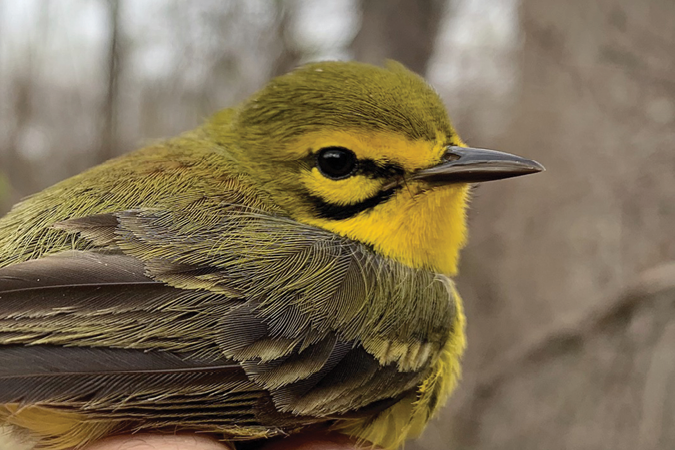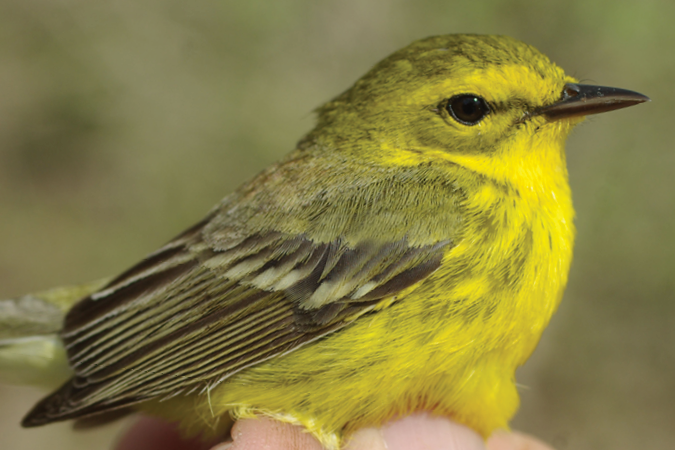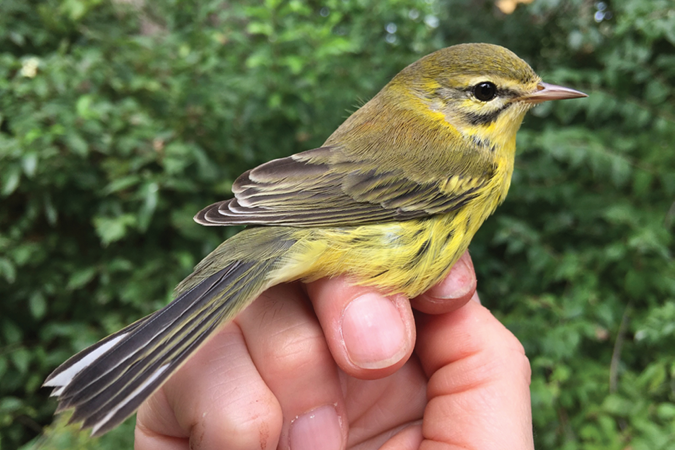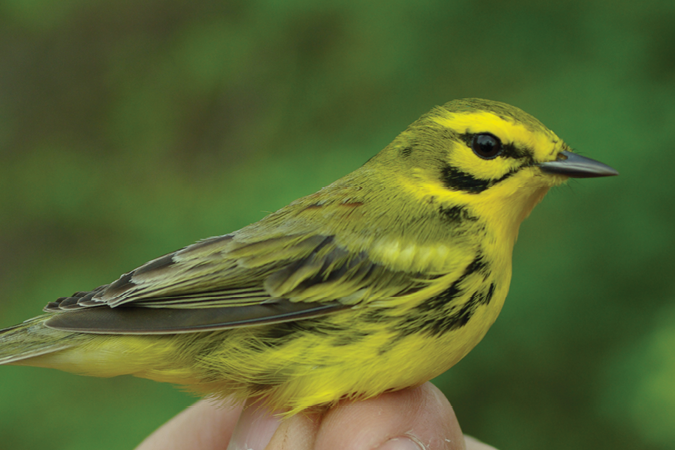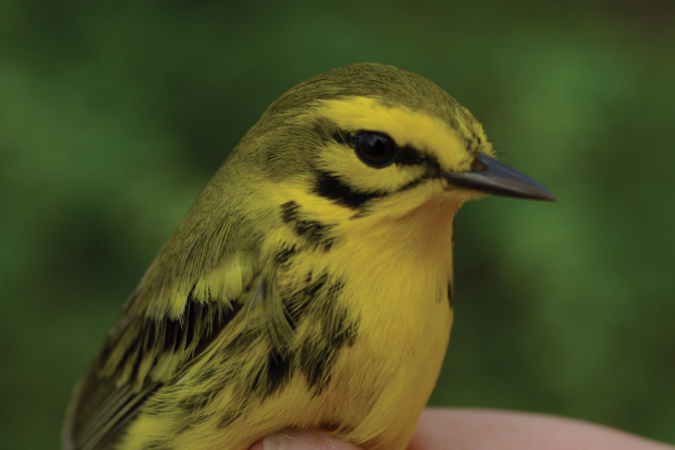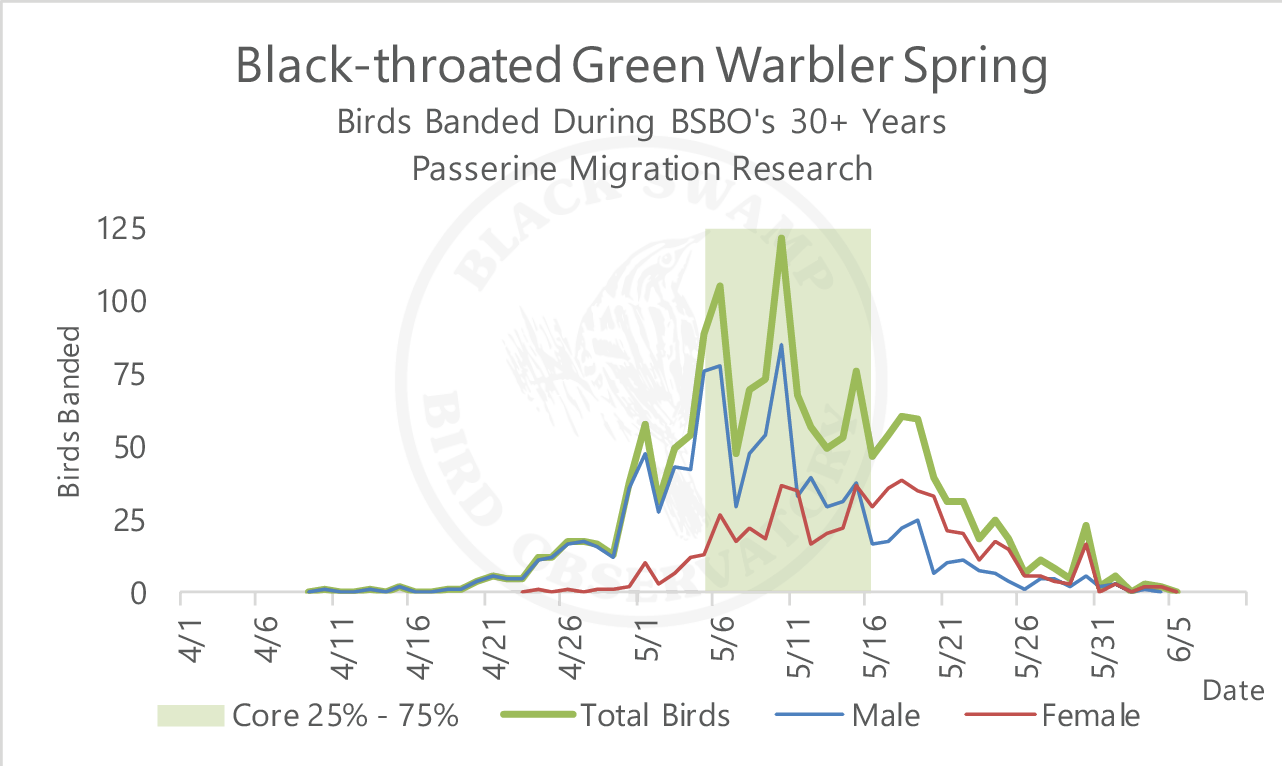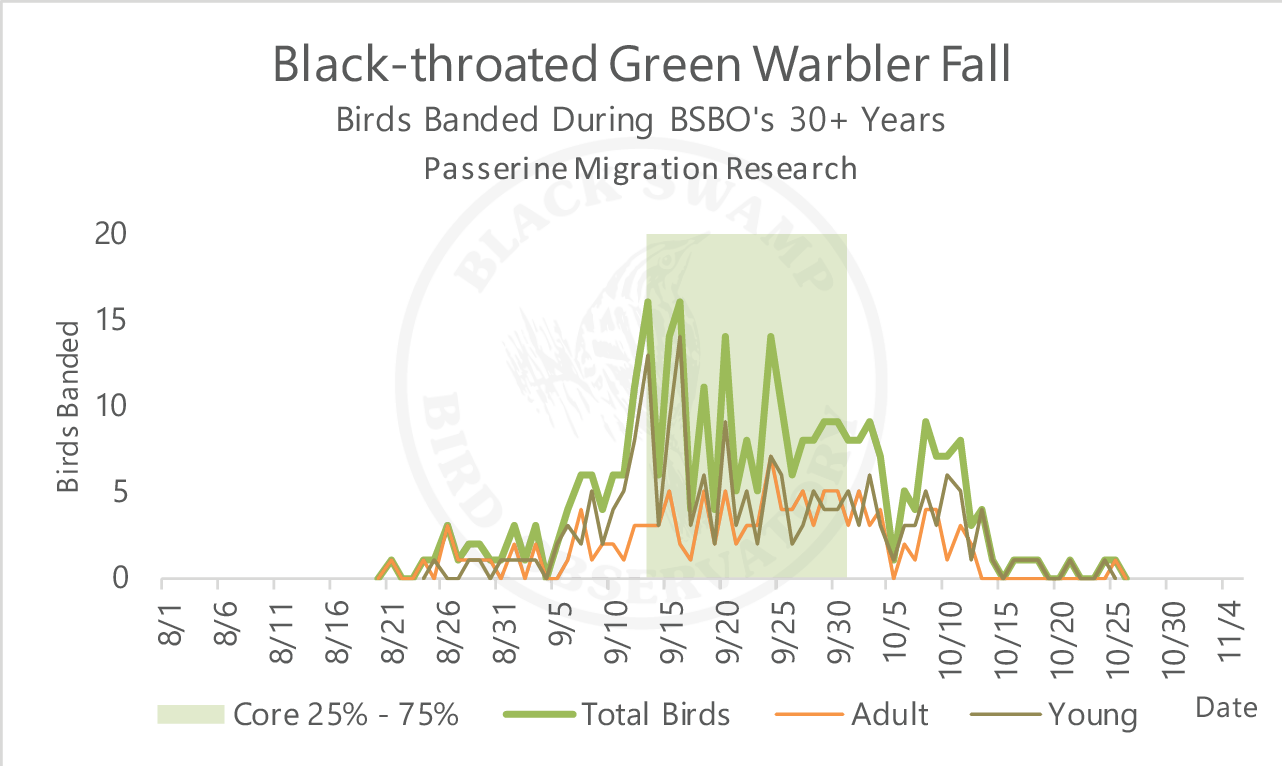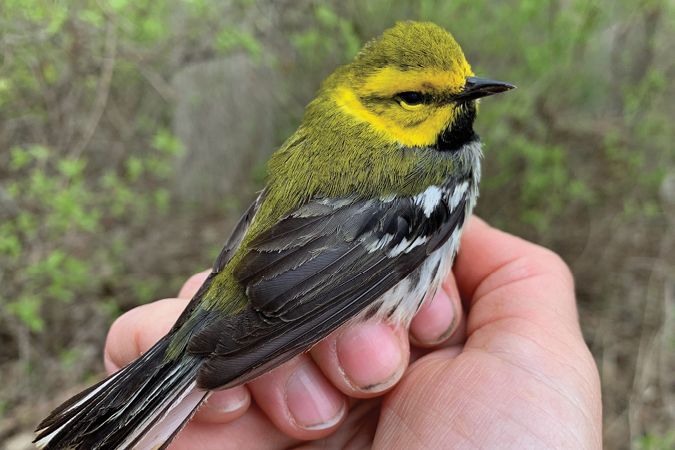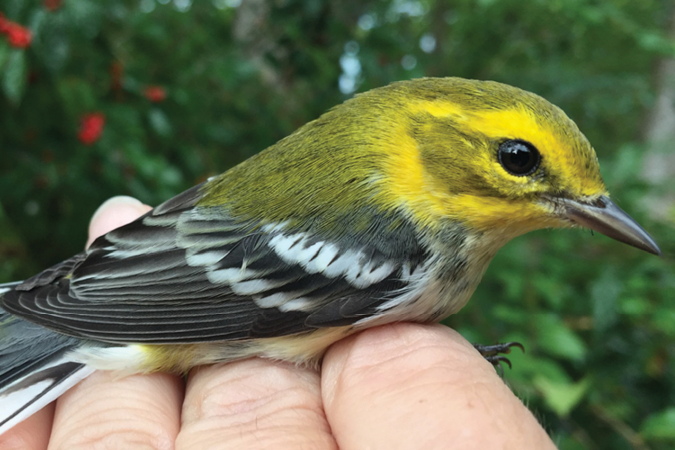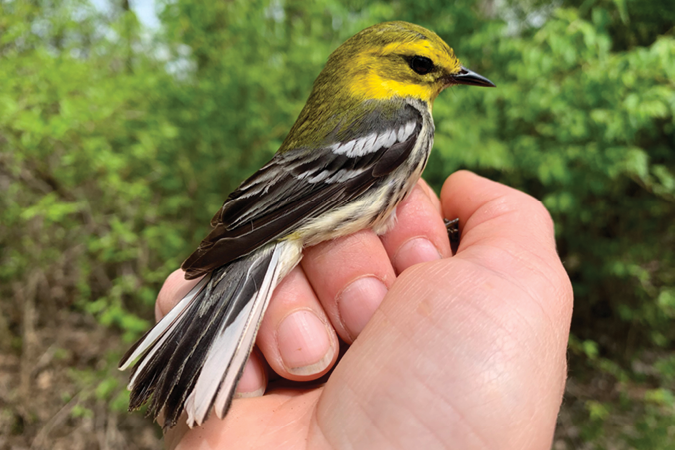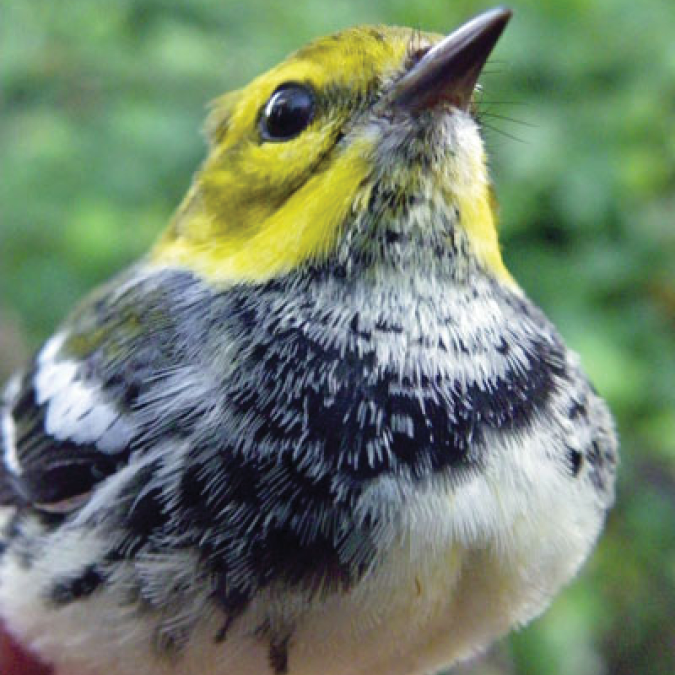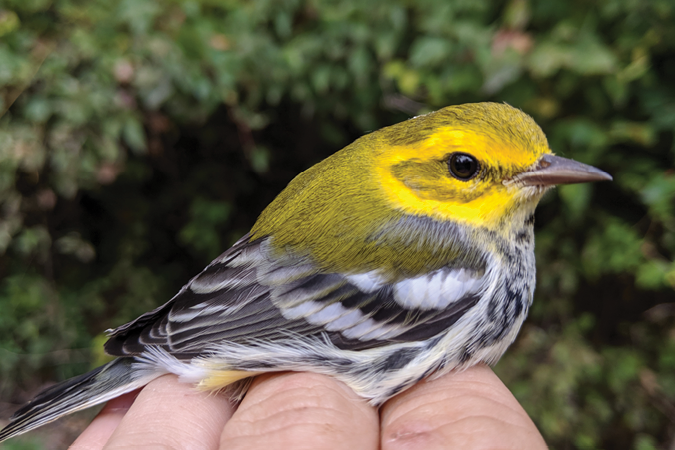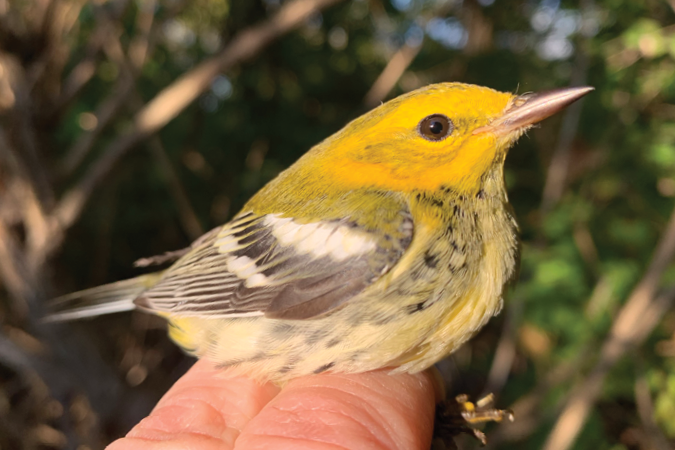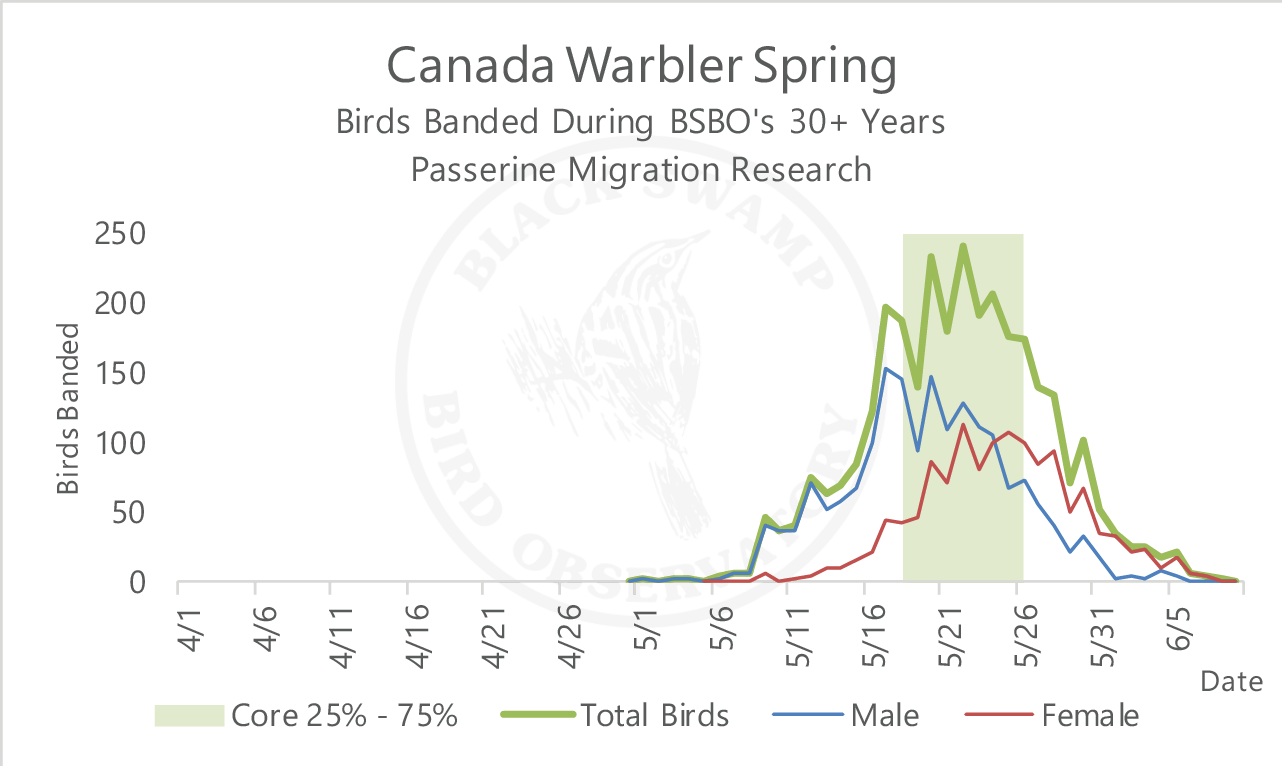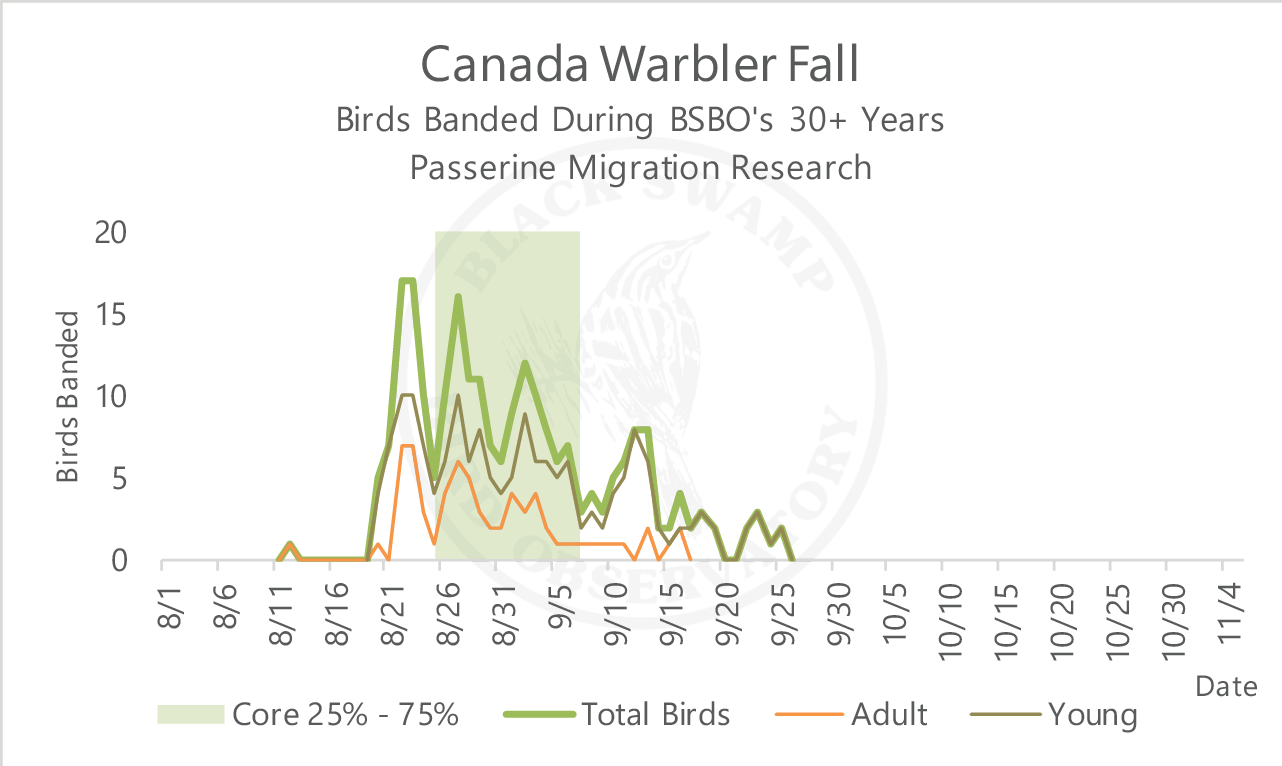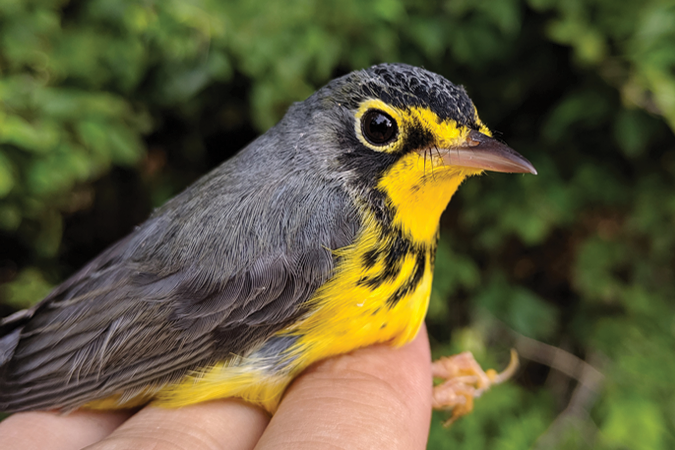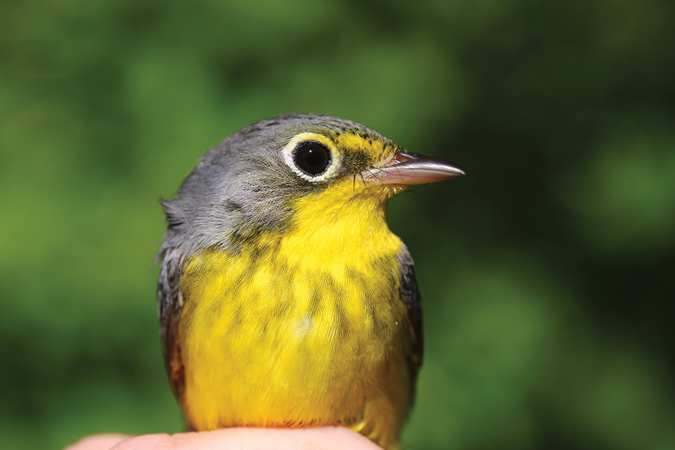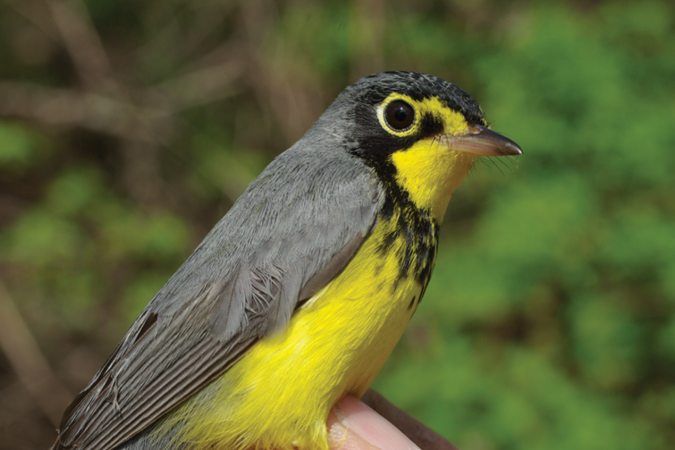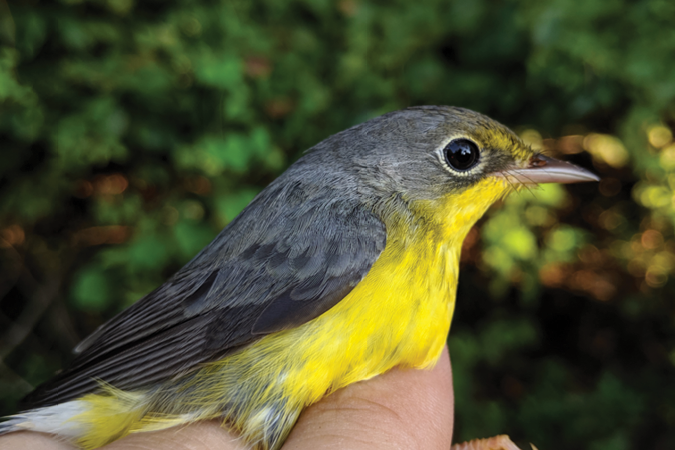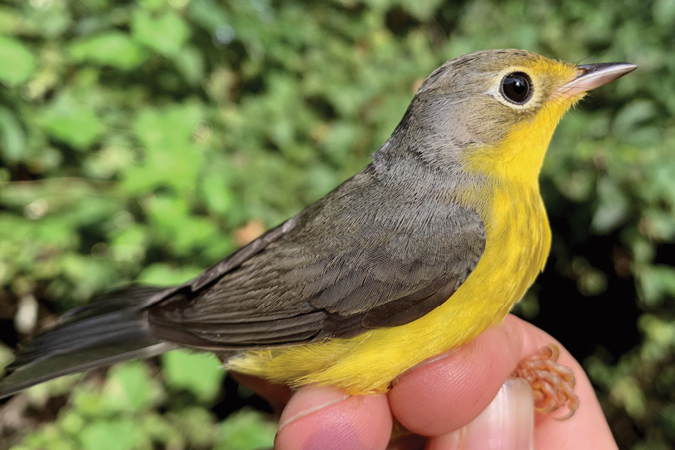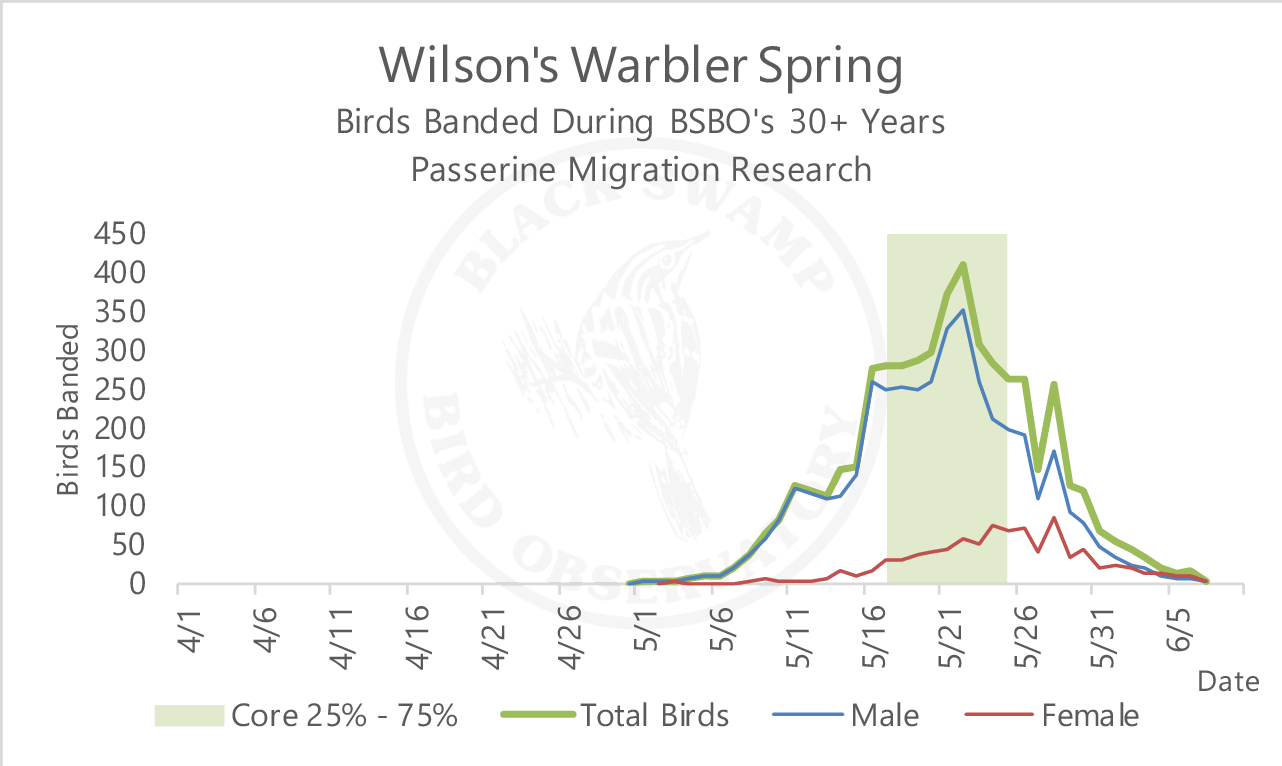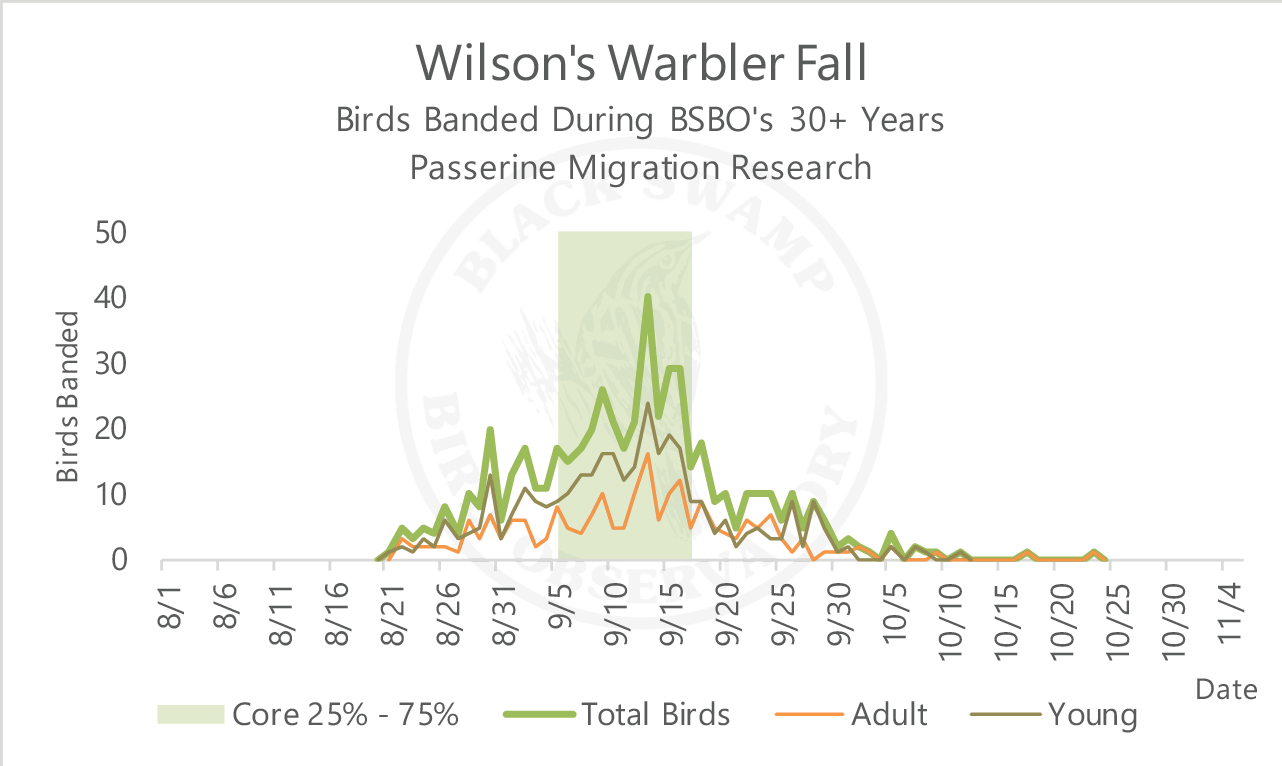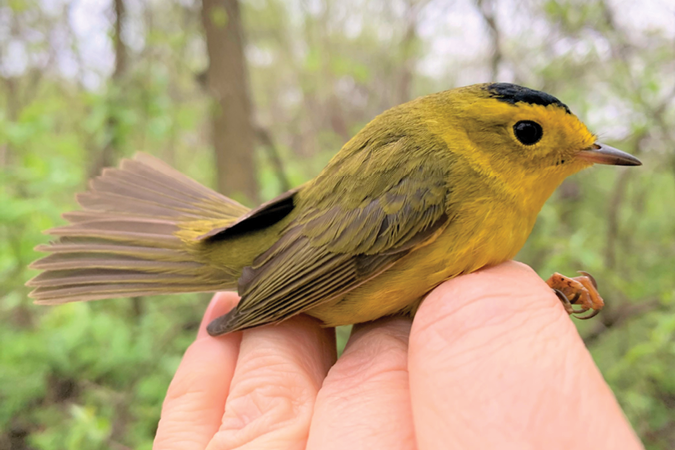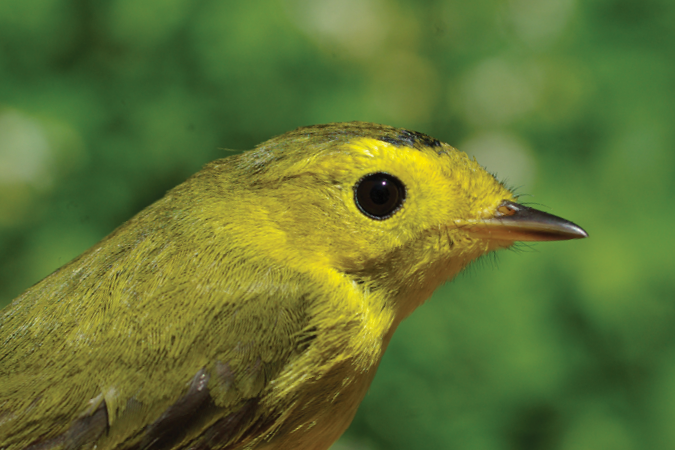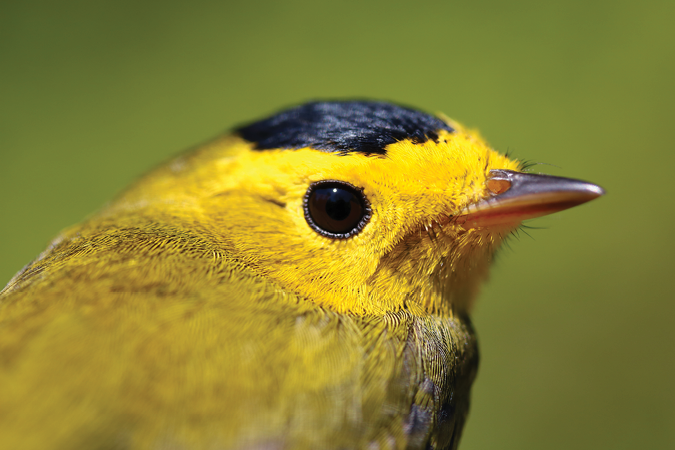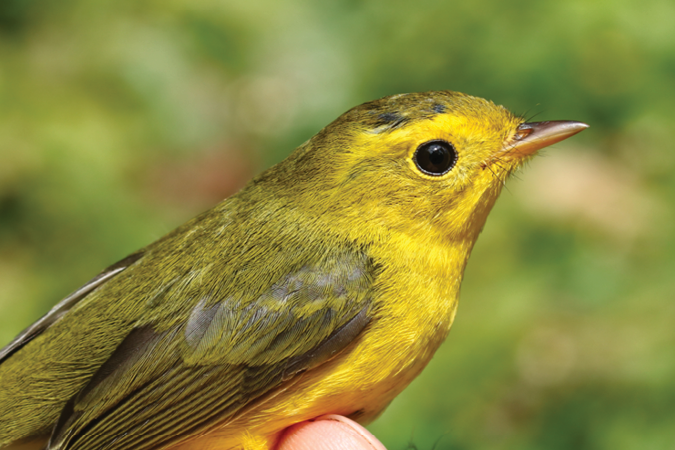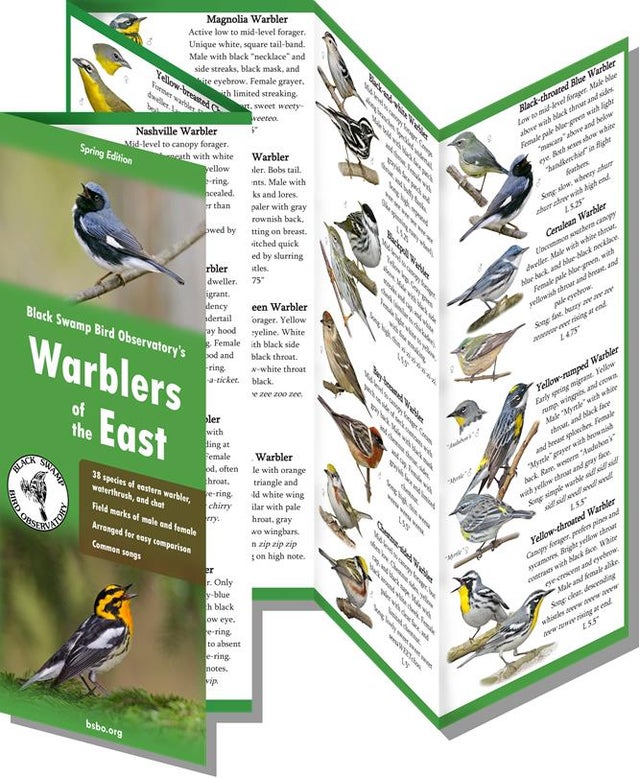Warblers Parulidae
about warblers in nw ohio
The New World Warblers or Wood-Warblers are renowned for their bright tropical colors, intricate songs, and lengthy migration paths. Considered neotropical migrants, "our" warblers breed throughout various habitats in the US and Canada, and winter from the southern US to the tropics of central South America.
The migrational timing of each warbler species is heavily influenced by whether they are making long-distance flights or short-distance ones. Their arrival to the lake shore is predictable within a few day period as day length is their driving factor. However, weather systems do play a role in hastening or delaying their flights. In spring, intense warm fronts early on in songbird migration can also produce “overflight” birds - species that typically nest farther south of Lake Erie or Ohio, but overshoot their intended destinations while caught up on warm southerly winds.
While warblers can be found nearly anywhere during migration, they tend to accumulate near the shores of Lake Erie, and move to lower areas within the vegetation where they are more easily viewable. Due to the number of species and their abundance during migration in Northwest Ohio, warblers comprise the bulk of BSBO’s songbird banding data, resulting in detailed timing of arrival, peak movement, and departure for most species.
The migrational timing of each warbler species is heavily influenced by whether they are making long-distance flights or short-distance ones. Their arrival to the lake shore is predictable within a few day period as day length is their driving factor. However, weather systems do play a role in hastening or delaying their flights. In spring, intense warm fronts early on in songbird migration can also produce “overflight” birds - species that typically nest farther south of Lake Erie or Ohio, but overshoot their intended destinations while caught up on warm southerly winds.
While warblers can be found nearly anywhere during migration, they tend to accumulate near the shores of Lake Erie, and move to lower areas within the vegetation where they are more easily viewable. Due to the number of species and their abundance during migration in Northwest Ohio, warblers comprise the bulk of BSBO’s songbird banding data, resulting in detailed timing of arrival, peak movement, and departure for most species.
Ovenbird Seiurus aurocapilla
|
Alpha Code: OVEN Spanish: Chipe Suelero French: Paruline couronnée Band Size: 1 NW Ohio Status: Migrant, Breeding Total Banded in Spring: 4,035 Average Banded in Spring: 135 Total Banded in Fall: 2,165 Average Banded in Fall: 75 |
Song: emphatic, rising teacher teacher teacher
Description: Tan-olive above with a heavily streaked breast on white underparts. Large and thrush-like with a tendency to walk. Orange crown bordered by black. Will often pop up when alarmed and flare crown. Male and female alike throughout the year. Spring Migration Timing: Second wave, with the majority of birds arriving in early May. Peak movement of total birds occurring May 9-15. |
Fall Migration Timing: Movement beginning at the end of August extending into early October. Peak movement in the middle of September 11-26.
Migration Habitat: Forest ground dweller. Can be found in forests with a variety of undergrowth heights. Notes: Secretive by nature; learning OVEN’s song can be useful for locating birds hidden in undergrowth. |
Worm-eating Warbler Helmitheros vermivorum
|
Alpha Code: WEWA Spanish: Chipe Gusanero French: Paruline vermivore Band Size: 0 ~ 1 NW Ohio Status: Overflight Migrant Total Banded in Spring: 34 Average Banded in Spring: 2 Total Banded in Fall: 1 Average Banded in Fall: <1 |
Song: dry, rattling trill
Description: Olive-tan above with tan-white underparts. Head and throat buff colored, with black stripes and black eyeline. Thicker bill compared to other warblers. Male and female alike throughout the year. Spring Migration Timing: Primarily first wave, with peak overflights occurring within the last week of April and first week of May. |
Fall Migration Timing: Insufficient data to graph.
Migration Habitat: Easily missed low forager of forests, preferring shaded undergrowth while foraging on the ground, or on trunks and limbs. Notes: Due to the accidental nature of its occurrence in NW Ohio, WEWA primarily occur early in spring migration and are extremely rare in fall. |
Louisiana Waterthrush Parkesia motacilla
|
Alpha Code: LOWA Spanish: Chipe Arroyero French: Paruline hochequeue Band Size: 1 NW Ohio Status: Overflight Migrant Total Banded in Spring: 42 Average Banded in Spring: 1 Total Banded in Fall: 0 Average Banded in Fall: - |
Song: 3-4 descending whistles followed by a quick jumble of notes
Description: Brown above with white-cream underparts. Buff tinge to flanks. Streaked breast with plain white throat. White eyebrow maintains thickness past eye. Bobs tail usually slowly, and often side to side. Male and female alike throughout the year. Spring Migration Timing: Primarily first wave, with peak overflights occurring in the latter half of April. |
Fall Migration Timing: Insufficient data to graph.
Migration Habitat: Low, near water. Can occur at any forested water source, but tends to appear near flowing water. Notes: Due to the accidental nature of its occurrence in NW Ohio, LOWA primarily occur early in spring migration and are extremely rare in fall. |
Northern Waterthrush Parkesia noveboracensis
|
Alpha Code: NOWA Spanish: Chipe Charquero French: Paruline des ruisseaux Band Size: 1 ~ 0 NW Ohio Status: Migrant Total Banded in Spring: 2,792 Average Banded in Spring: 93 Total Banded in Fall: 853 Average Banded in Fall: 29 |
Song: begins loud and emphatic, ending in lower rapid notes
Description: Brown above with white underparts tinged yellow. Streaked breast and throat. Yellow-tinged eyebrow tapers past eye. Bobs tail quickly up and down. Male and female alike throughout the year. Spring Migration Timing: Second wave, first appearing in late April but with peak arrival occurring May 5-15. |
Fall Migration Timing: Substantial arrival beginning in the latter half of August. Peak movement occurring September 1-21. Consistent movement throughout the majority of September, tapering off into mid-October.
Migration Habitat: Low, often near slow or stagnant water in or near forests, but can occur in a variety of habitats - usually near water though. |
Golden-winged Warbler Vermivora chrysoptera
|
Alpha Code: GWWA Spanish: Chipe de Ala Dorada French: Paruline à ailes dorées Band Size: 0A ~ 0 NW Ohio Status: Migrant, Breeding-rare Total Banded in Spring: 117 Average Banded in Spring: 4 Total Banded in Fall: 25 Average Banded in Fall: <1 |
Song: soft bee-bz-bz-bzz
Description: Gray above with white underparts. Large yellow wing patch and crown. Male with narrow black mask and throat. Female with gray mask and throat. Spring Migration Timing: Second wave, with males showing the heaviest movement in the first week of May, and the peak of total birds occurring May 5-16. |
Fall Migration Timing: Seldom appears in fall, primarily occurring between mid-August and mid-September, with the majority of birds occurring September 5-20.
Migration Habitat: Low to mid-level forager in open forests, adjacent scrub-shrub clearings, and brushy areas with a mix of vegetation height. Notes: Declining range-wide. Former breeder within NW Ohio’s Oak Openings region, with sparse summer encounters in recent years. |
Blue-winged Warbler Vermivora cyanoptera
|
Alpha Code: BWWA Spanish: Chipe de Ala Azul French: Paruline à ailes bleues Band Size: 0A ~ 0 NW Ohio Status: Migrant, Breeding-local Total Banded in Spring: 507 Average Banded in Spring: 17 Total Banded in Fall: 16 Average Banded in Fall: <1 |
Song: buzzy beee-buzzz
Description: Bright yellow head and underparts. Green back with blue-gray tail and wings, with white wingbars. Sharp black eyeline reaches just past eye. Female slightly paler than male with obscure eyeline. Spring Migration Timing: Males arrive heavily at the end of the first wave in late April and early May, with the majority of birds arriving in the second wave May 2-12. |
Fall Migration Timing: Sporadic as birds filter south, with the bulk of passage occurring in late August into early September.
Migration Habitat: Scrub-shrub dweller, often in thickets and brushy fields adjacent to forests. |
Black-and-white Warbler Mniotilta varia
|
Alpha Code: BAWW Spanish: Chipe Trepador French: Paruline noir et blanc Band Size: 0 ~ 0A NW Ohio Status: Migrant, Breeding-local Total Banded in Spring: 2,869 Average Banded in Spring: 96 Total Banded in Fall: 660 Average Banded in Fall: 23 |
Song: high, repeated wee-see wee-see wee-see (like a spinning rusty wheel)
Spring Description: Black and white. Uniquely speckled undertail. Male distinctly black and white, with black face patch and throat. Female with grayish face patch and throat, blurry side streaks, and often buffy flanks. Spring Migration Timing: Males first arrive at the end of the first wave in late April to early May, with peak total birds occurring in the second wave, May 7-15. |
Fall Description: Black and white. Uniquely speckled undertail. Adult male very similar to spring but with a whiter throat. Adult female and young birds with grayish-white face patch and throat; females with indistinct side streaks; young male with defined side streaks.
Fall Migration Timing: Quite prolonged, extending from late August into early October, peaking in mid-September. Migration Habitat: Mid-level to canopy forager in mature and second-growth forests, creeping along branches and trunks, but may also appear in urban parks and backyards. |
Prothonotary Warbler Protonotaria citrea
|
Alpha Code: PROW Spanish: Chipe Dorado French: Paruline orangée Band Size: 0 NW Ohio Status: Migrant, Breeding Total Banded in Spring: 240 Average Banded in Spring: 8 Total Banded in Fall: 245 Average Banded in Fall: 8 |
Song: loud, clear weat-weat-weat-weat-weat
Spring Description: Male bright yellow with white undertail, and blue-gray wings, tail, and legs. Female slightly paler overall, with dusky blue-gray wings and tail, and blue-gray legs. Black bill. Spring Migration Timing: Second wave, with males showing an initial surge May 7-10, and the peak of total birds occurring May 10-20. |
Fall Description: Adult male similar to spring, with a slightly duskier crown. Adult female and young birds paler overall compared to adult male. Pinkish bill.
Fall Migration Timing: Relatively early, with most birds departing by the first week of September. Peak movement occurring around the third week of August, 16-26. Migration Habitat: Low, swamp and wet forest dweller. Notes: NW Ohio is at the very northern edge of PROW’s breeding range. However, they can be found in migration and breeding in multiple NW Ohio locations, particularly in buttonbush swamps. |
Tennessee Warbler Leiothlypis peregrina
|
Alpha Code: TEWA Spanish: Chipe Peregrino French: Paruline obscure Band Size: 0A ~ 0 NW Ohio Status: Migrant Total Banded in Spring: 3,555 Average Banded in Spring: 119 Total Banded in Fall: 2,164 Average Banded in Fall: 75 |
Song: 2-3 parts, starting slow then rapidly ascending to a trill (like the stuttering of a truck starting)
Spring Description: Green above with whitish underparts. Male with gray-blue head, and whitish eyebrow and throat. Female with dusky eyeline and yellow-green throughout. Sharp bill. Spring Migration Timing: End of second wave extending into third wave, with the peak of birds occurring May 12-22. |
Fall Description: Green above with yellow-white underparts. Adult male with grayish-blue head, dusky eyeline, and mostly white throat and underparts. Adult female and young birds with dusky eyeline and yellow-green throughout. Sharp bill.
Fall Migration Timing: Quite prolonged, extending from mid-August to mid-October. Peak movement occurring primarily September 9-30. Migration Habitat: Predominantly canopy forager of forests. Tends to stay high in canopy during spring, moving lower into forest undergrowth and adjacent scrub-shrub during fall. |
Orange-crowned Warbler Leiothlypis celata
|
Alpha Code: OCWA Spanish: Chipe Oliváceo French: Paruline verdâtre Band Size: 0A ~ 0 NW Ohio Status: Migrant Total Banded in Spring: 326 Average Banded in Spring: 11 Total Banded in Fall: 132 Average Banded in Fall: 5 |
Song: thin trill, trailing at end
Spring Description: Overall plain, gray-yellow. Faint, blurry breast streaks. Faint, pale eyebrow and obscure eyeline. Orange crown often concealed. Spring Migration Timing: Early surge of males in mid-April, with the peak of birds filtering through during the second wave, May 1-12. |
Fall Description: Similar to spring, but with a grayer head and lighter throat.
Fall Migration Timing: Late and condensed, with birds moving in late September into mid-October. Peak movement occurring October 5-15. Migration Habitat: Low forager in brushy forest undergrowth and adjacent scrub-shrub, including parks and backyards. Notes: While OCWA do regularly appear in NW Ohio, they occur in relatively low numbers as they are less common in the eastern US compared to the western US. |
Nashville Warbler Leiothlypis ruficapilla
|
Alpha Code: NAWA Spanish: Chipe de Nashville French: Paruline à joues grises Band Size: 0A ~ 0 NW Ohio Status: Migrant Total Banded in Spring: 6,321 Average Banded in Spring: 211 Total Banded in Fall: 1,107 Average Banded in Fall: 38 |
Song: quick repeated see-weet notes, followed by lower, bubbling trill
Spring Description: Greenish above with yellow underparts and white vent. Rufous cap often concealed; pale to absent in females. Male with gray hood, white eyering, and yellow throat. Female with paler gray hood, underparts, and whitish eyering. Spring Migration Timing: Second wave, with males showing an initial surge May 1-7, and the peak of total birds occurring May 5-13. |
Fall Description: Similar to spring. Adult male only slightly paler. Adult female and young birds much paler than adult male, with tan-gray hood and cream to tan eyering.
Fall Migration Timing: Quite prolonged, with birds first arriving in late August and tapering off by mid-October. Peak movement occurring September 18 through October 7. Migration Habitat: Mid-level to canopy forager. Can be found throughout most forested and adjacent scrub-shrub habitats, including urban parks and backyards. |
Connecticut Warbler Oporornis agilis
|
Alpha Code: CONW Spanish: Chipe de Connecticut French: Paruline à gorge grise Band Size: 1 ~ 0 NW Ohio Status: Migrant Total Banded in Spring: 227 Average Banded in Spring: 8 Total Banded in Fall: 229 Average Banded in Fall: 8 |
Song: loud, ringing chippy-chipper-chippy-chipper-chippy-chipper-chip
Spring Description: Olive above with yellow underparts. Secretive. Bulky with tendency to walk. Long undertail coverts. Male with mostly gray hood and bold white eyering. Female with light tan-gray hood and white to cream eyering. Spring Migration Timing: Third wave, quite condensed in late spring with peak total birds occurring May 20-27. |
Fall Description: Adult male and female same as spring. Young birds similar to adult female, with light tan-gray hood and whitish-cream eyering.
Fall Migration Timing: Sporadic, but mostly occurring in September, with peak movements September 9-23. Migration Habitat: Ground forager. Often in dense forest undergrowth, thickets near drainage ditches and wetland dikes, and dense meadow thickets. Notes: Knowing CONW’s song is extremely useful, as they are often heard before seen. While still difficult to locate, NW Ohio presents one of the best opportunities for spotting this species in migration. |
Mourning Warbler Geothlypis philadelphia
|
Alpha Code: MOWA Spanish: Chipe Llorón French: Paruline triste Band Size: 0 ~ 0A NW Ohio Status: Migrant, Breeding-rare Total Banded in Spring: 3,016 Average Banded in Spring: 101 Total Banded in Fall: 319 Average Banded in Fall: 11 |
Song: load, rolling chirry chirry chirry, chorry chorry
Spring Description: Olive above with yellow underparts. Male with gray-blue hood ending at black breast patch, and dusky lores. Female with light gray hood, light eyering, and often with white to yellowish throat. Spring Migration Timing: Third wave, with first appearances in mid-May and peak total birds occurring May 20-30. |
Fall Description: Adult male similar to spring, with reduced black breast patch. Adult female similar to spring. Young birds with varying tannish-gray hood and gray-yellow throat.
Fall Migration Timing: Fairly early migrant, with movement picking up in mid-August and tapering off through mid-September into early October. Peak movement of total birds occurring August 30 through September 15. Migration Habitat: Low forager in dense thickets and scrub-shrub in open forests or adjacent clearings. Notes: Knowing MOWA’s song can be very useful as birds are elusive and often heard, but difficult to see, from dense undergrowth. |
Kentucky Warbler Geothlypis formosa
|
Alpha Code: KEWA Spanish: Chipe Patilludo French: Paruline du Kentucky Band Size: 0 ~ 1 NW Ohio Status: Overflight Migrant Total Banded in Spring: 53 Average Banded in Spring: 2 Total Banded in Fall: 3 Average Banded in Fall: <1 |
Song: rich churry churry churry (like a galloping horse)
Description: Olive above with yellow underparts. Yellow “spectacles” bordered by black “sideburns” and cap. Female similar to male, but with reduced black. Spring Migration Timing: First and second wave, with peak overflights occurring May 1-11. |
Fall Migration Timing: Insufficient data to graph.
Migration Habitat: Forest ground dweller, preferring shaded undergrowth in forests and near swamp edges. Notes: Due to the accidental nature of its occurrence in NW Ohio, KEWA primarily occur early in spring migration and are extremely rare in fall. |
Common Yellowthroat Geothlypis trichas
|
Alpha Code: COYE Spanish: Mascarita Común French: Paruline masquée Band Size: 0 ~ 0A NW Ohio Status: Migrant, Breeding Total Banded in Spring: 9,388 Average Banded in Spring: 313 Total Banded in Fall: 4,575 Average Banded in Fall: 158 |
Song: typically loud, fast wichety-wichety-wichety-wich
Spring Description: Tan-olive above with tannish underparts. Male with bright yellow throat and black mask edged in white above. Female with tan-gray face and paler, less extensive yellow throat. Spring Migration Timing: Can start appearing quite early in spring, but picking up towards May. Predominantly second wave migrant, with the peak of total birds occurring May 11-23. |
Fall Description: Adult male similar to spring, but with white to yellow flecking in black mask. Adult female and young birds with tan-gray face and paler, lesser extensive yellow throat. Some young males show minimal black flecking on face.
Fall Migration Timing: Quite prolonged, spanning August into October. Peak movement of total birds occurring September 6-24. Migration Habitat: Low skulker, inhabiting dense marsh and other low, wet vegetation in open areas, occasionally using forest undergrowth and dry scrub-shrub. |
Hooded Warbler Setophaga citrina
|
Alpha Code: HOWA Spanish: Chipe Encapuchado French: Paruline à capuchon Band Size: 0 ~ 0A NW Ohio Status: Overflight Migrant, Breeding-local Total Banded in Spring: 238 Average Banded in Spring: 8 Total Banded in Fall: 8 Average Banded in Fall: <1 |
Song: clear, loud tawee-tawee-tawee-TEE-oh
Description: Olive above with yellow underparts. White in outer tail feathers (unique among the “yellow” warblers). Male with distinct black hood and yellow mask. Female ranging from hint of a dusky hood to a nearly full black hood. Spring Migration Timing: First wave into second wave, with peak overflights occurring May 1-19. |
Fall Migration Timing: Insufficient data to graph.
Migration Habitat: Forest ground dweller, preferring shaded forest undergrowth. Notes: While primarily an overflight species, HOWA do breed within NW Ohio’s Oak Openings region, making birds encountered in spring possible breeders still en route. Because of their overflight status and localized breeding, fall encounters are fairly rare. |
American Redstart Setophaga ruticilla
|
Alpha Code: AMRE Spanish: Chipe Flameante French: Paruline flamboyante Band Size: 0A ~ 0 NW Ohio Status: Migrant, Breeding Total Banded in Spring: 8,511 Average Banded in Spring: 284 Total Banded in Fall: 2,202 Average Banded in Fall: 76 |
Song: high, variable weesa weesa weesa ending with an upward or downward inflection
Spring Description: Adult male black above and throughout breast, with orange wingpits, flight feather patch, and tail spots. Female grayish with yellow-orange accents. First-spring male like female, but with varying black splotches on face and breast. Spring Migration Timing: Second into third wave, with peak total birds occurring May 15-25. |
Fall Description: Adult male and female same as spring. Young birds grayish with yellow-orange accents. Some young males may show black flecks on face.
Fall Migration Timing: Fairly extensive; however, shows a distinct peak movement September 9-23. Migration Habitat: Low- to mid-level forager, often flycatching. Prefers young forests and forest edges, but can be found in urban parks and backyards. |
Cape May Warbler Setophaga tigrina
|
Alpha Code: CMWA Spanish: Chipe Atigrado French: Paruline tigrée Band Size: 0A ~ 0 NW Ohio Status: Migrant Total Banded in Spring: 961 Average Banded in Spring: 32 Total Banded in Fall: 2,751 Average Banded in Fall: 95 |
Song: high, thin see see see see
Spring Description: Green-gray above with yellow to white underparts. Male with black breast streaks and eyeline, chestnut face patch, and white wing patch. Female whitish below with hints of yellow, faint streaking, and grayish face. Slim, dark bill. Spring Migration Timing: Second wave, with peak bird movement occurring May 11-18. |
Fall Description: Adult male and female similar to spring. Young birds similar to adult female, with young female even paler, and young male showing slightly more yellow underneath and in throat. Slim, dark bill.
Fall Migration Timing: Quite prolonged (albeit in low numbers), however, a distinct jump occurs in the beginning of September, with peak total birds moving September 15-29. Migration Habitat: Mid-level to canopy forager, using a variety of forest types and occasionally straying into lower thickets, including urban parks and backyards. Notes: While CMWA can be found in various areas throughout fall migration, they tend to concentrate along the beach ridges of Lake Erie. |
Cerulean Warbler Setophaga cerulea
|
Alpha Code: CERW Spanish: Chipe Cerúleo French: Paruline azurée Band Size: 0A ~ 0 NW Ohio Status: Overflight Migrant, Breeding-rare Total Banded in Spring: 49 Average Banded in Spring: 2 Total Banded in Fall: 1 Average Banded in Fall: <1 |
Song: fast, buzzy zee zee zee zezezeze eeet rising at end
Spring Description: Male with white throat and underparts, blue back, and blue-black “necklace.” Female pale blue-green, with yellowish throat and underparts, and pale eyebrow. Spring Migration Timing: First and second wave, with peak overflights occurring May 1-10. |
Fall Description: Adult male and female similar to spring. Young birds like adult female; pale blue-green, with yellowish throat and underparts, and pale eyebrow.
Fall Migration Timing: Insufficient data to graph. Migration Habitat: Canopy dweller of deciduous forests. Will occasionally move lower into forest undergrowth. Notes: Due to the accidental nature of its occurrence in NW Ohio, CERW primarily occur early in spring migration and are extremely rare in fall. |
Northern Parula Setophaga americana
|
Alpha Code: NOPA Spanish: Parula Norteña French: Paruline à collier Band Size: 0A ~ 0 NW Ohio Status: Migrant, Breeding-rare Total Banded in Spring: 469 Average Banded in Spring: 16 Total Banded in Fall: 68 Average Banded in Fall: 2 |
Song: thin, buzzy trill zz-zz-zzz-zzzeee-wup with abrupt end
Spring Description: Blue above with green back patch, yellow throat and breast, and white belly. Male with white wingbars and eye-crescents, and rusty band below throat. Female similar but paler and greener, lacking rust below throat. Spring Migration Timing: Second wave, with peak movement occurring May 9-17. |
Fall Description: Adult male similar to spring, but slightly paler with limited rust. Adult female and young birds paler and greener than adult male, and lacking rust. Young female palest of all.
Fall Migration Timing: Most movement occurs in September and early October, with peak flights occurring September 15 through October 3. Migration Habitat: Canopy forager in a variety of forests including urban parks and backyards. |
Magnolia Warbler Setophaga magnolia
|
Alpha Code: MAWA Spanish: Chipe de Magnolia French: Paruline à tête cendrée Band Size: 0A ~ 0 NW Ohio Status: Migrant Total Banded in Spring: 18,614 Average Banded in Spring: 620 Total Banded in Fall: 4,435 Average Banded in Fall: 153 |
Song: short, sweet weeta-weeta-weeteo
Spring Description: Gray-blue above with yellow underparts. Unique white, square band through middle of tail. Male with black “necklace” and side streaks, black mask, and white eyebrow. Female grayer, with limited streaking. Spring Migration Timing: Male shows initial surge early in second wave May 7-13, with peak total birds occurring May 13-22. |
Fall Description: Yellow below with gray-green upperparts. Unique white, square band through middle of tail. Adult male with limited black streaking below, gray-blue hood, and white eyering. Female and young birds paler and greener overall, with faint to no dark streaking below.
Fall Migration Timing: Quite extensive from mid-August into early October, swelling to a peak movement September 9-25. Migration Habitat: Active low- to mid-level forager. Can be found throughout most forested and adjacent scrub-shrub habitats, urban parks, and backyards. Notes: While MAWA can be found throughout most of NW Ohio during migration, they tend to concentrate along the beach ridges of Lake Erie. |
Bay-breasted Warbler Setophaga castanea
|
Alpha Code: BBWA Spanish: Chipe de Pecho Castaño French: Paruline à poitrine baie Band Size: 0 ~ 0A NW Ohio Status: Migrant Total Banded in Spring: 1,859 Average Banded in Spring: 62 Total Banded in Fall: 952 Average Banded in Fall: 33 |
Song: high, thin teesi-teesi-teesi-teesi
Spring Description: Gray above with cream underparts. Cream patch on side of neck contrasts with gray back. Male with black mask and chestnut throat, sides, and cap. Female with grayish face, cream throat, and limited chestnut. Grayish-blue legs. Spring Migration Timing: Second wave, with peak movement occurring May 13-20. |
Fall Description: Green above with creamy-yellow underparts. Adult male with greenish head, creamy-yellow throat, and limited chestnut sides. Adult female and young birds with greenish-yellow head and creamy-yellow throat. Some adult females and young males with faint chestnut sides. Grayish-blue legs.
Fall Migration Timing: Quite prolonged, extending from mid-August into mid-October, with peak movements occurring September 13-26. Migration Habitat: Sluggish, mid-level to canopy forager of varying forests including urban parks and backyards. |
Blackburnian Warbler Setophaga fusca
|
Alpha Code: BLBW Spanish: Chipe de Garganta Naranja French: Paruline à gorge orangée Band Size: 0A ~ 0 NW Ohio Status: Migrant Total Banded in Spring: 983 Average Banded in Spring: 33 Total Banded in Fall: 143 Average Banded in Fall: 5 |
Song: high, thin zip zip zip titititi tseeee ending on high note
Spring Description: Black-gray above with orange to white underparts. Male with bright orange throat and face, black face triangle and side streaks, and bold white wing patch. Female similar with pale orange-yellow throat, gray markings, and two white wingbars. Spring Migration Timing: Second wave, with males showing a surge arrival May 7-12, and the peak of bird movement occurring May 12-22. |
Fall Description: Adult male similar to spring with paler orange. Adult female similar to spring. Young male mostly yellow throat and face, gray markings, and two white wingbars. Young females pale with yellow tint to throat, dusky cheek, and faint to absent streaking.
Fall Migration Timing: Fairly prolonged from mid-August into early October, with peak movement occurring September 8-24. Migration Habitat: Mid-level to canopy forager of a variety of forests including urban parks and backyards. |
Yellow Warbler Setophaga petechia
|
Alpha Code: YEWA Spanish: Chipe Amarillo French: Paruline jaune Band Size: 0 ~ 0A NW Ohio Status: Migrant, Breeding Total Banded in Spring: 11,681 Average Banded in Spring: 389 Total Banded in Fall: 1,716 Average Banded in Fall: 59 |
Song: fast, bright sweet sweet sweet I’m so sweet
Spring Description: All yellow with noticeable dark eye. Yellow tail spots. Male bright with prominent rusty breast streaks. Female paler, occasionally with hints of rusty streaks. Spring Migration Timing: Second wave, with males first appearing in late April and peak movement of total birds occurring May 7-18. |
Fall Description: Adult male similar to spring but slightly paler. Adult female and young birds pale yellow, sometimes showing hints of rust. Young females palest of all without streaks.
Fall Migration Timing: Very early migrant, with the majority of birds departing by August. Lesser numbers occur through August with very few individuals appearing into September. Migration Habitat: Low- to mid-level forager of scrub-shrub, clearings, and adjacent forest edges. Quite ubiquitous and can be found in open areas of urban parks and backyards. Notes: As an early migrant in fall, with the majority of YEWA departing by September, most birds appearing in September tend to be larger and greener, suggesting Alaska and western Canada subspecies. |
Chestnut-sided Warbler Setophaga pensylvanica
|
Alpha Code: CSWA Spanish: Chipe de Flanco Castaño French: Paruline à flancs marron Band Size: 0A ~ 0 NW Ohio Status: Migrant, Breeding-local Total Banded in Spring: 4,314 Average Banded in Spring: 144 Total Banded in Fall: 520 Average Banded in Fall: 18 |
Song: lively sweet sweet sweet seesa WEETchoo
Spring Description: Gray-olive above with white underparts. Male with black around white cheek, bright yellow cap, and extensive chestnut sides. Female paler with mostly clear face, limited black and chestnut. Spring Migration Timing: Second wave, with males surging May 7-13, and peak movement of birds occurring May 12-20. |
Fall Description: Green above with white-gray underparts. Adult male with bright green head, white eyering, gray face, and limited chestnut sides. Adult female and young birds with greenish head, white eyering, and gray face. Adult female and young male sometimes showing faint chestnut sides.
Fall Migration Timing: Mid-August into early October. Peak movement occurring September 3-20. Migration Habitat: Mid-level to canopy forager, but often low. Quite versatile, but prefers young forest edges and adjacent scrub-shrub, including urban parks and backyards. |
Blackpoll Warbler Setophaga striata
|
Alpha Code: BLPW Spanish: Chipe de Gorra Negra French: Paruline rayée Band Size: 0 ~ 0A NW Ohio Status: Migrant Total Banded in Spring: 2,136 Average Banded in Spring: 71 Total Banded in Fall: 16,181 Average Banded in Fall: 558 |
Song: high, thin zi-zi-zi-zi-zi-zi-zi
Spring Description: Grayish above with white underparts. Male with black side streaks and cap, and white cheek (similar to a chickadee). Female light white to yellow, with fine black side streaks and in cap. Yellow legs. Spring Migration Timing: Second wave, with peak movement occurring May 16-24. |
Fall Description: Olive-gray above with white to yellow underparts. Adult male whitest below with varying black streaks peppered along sides, face, and crown. Adult female and young birds yellowish below with dusky to absent streaking along sides. Brownish legs with yellow feet.
Fall Migration Timing: Many individuals present throughout September into early October. Peak movement of birds occurring September 18-30, with a significant peak September 20-24. Migration Habitat: Mid-level to canopy forager, using a variety of forests and adjacent scrub-shrub including urban parks and backyards. Notes: Due to BLPW’s migration routes, birds are quite sparse in NW Ohio in spring. However, NW Ohio in fall is a hotbed for BLPW as they follow Lake Erie east. |
Black-throated Blue Warbler Setophaga caerulescens
|
Alpha Code: BTBW Spanish: Chipe Azul Negro French: Paruline bleue Band Size: 0A ~ 0 NW Ohio Status: Migrant Total Banded in Spring: 1,569 Average Banded in Spring: 52 Total Banded in Fall: 1,327 Average Banded in Fall: 46 |
Song: slow, wheezy zhurr zhurr zhree with high end
Description: Male blue above with black face, throat, and sides, and white underparts. Female pale blue-green throughout with light “mascara” above and below eye. Both sexes show white “handkerchief” in flight feathers. Spring Migration Timing: Second wave, with males surging around May 9, and the peak of total birds occurring May 12-19. |
Fall Migration Timing: Quite prolonged, extending from mid-August into mid-October. Peak movement of birds occurring September 11 through October 1.
Migration Habitat: Low- to mid-level forager of forest undergrowth and shrubby areas, preferring dense vegetation. |
(Western) Palm Warbler Setophaga palmarum palmarum
|
Alpha Code: WPWA Spanish: Chipe Playero Occidental French: Paruline à couronne rousse de l’ouest Band Size: 0 ~ 0A NW Ohio Status: Migrant Total Banded in Spring: 4,660 Average Banded in Spring: 155 Total Banded in Fall: 287 Average Banded in Fall: 10 |
Song: simple, raspy trill, fading in and out
Spring Description: Brown-gray above with whitish-yellow underparts. Bobs tail. Chestnut cap and breast streaks. Yellow eyebrow. Yellow throat often not extending past breast. Male and female alike. Spring Migration Timing: First into second wave, with birds arriving early in April, and peak movement occurring May 1-10. |
Fall Description: Brown above with tan-white underparts, variably light yellow. Bobs tail. Tan eyebrow and throat. Faint, dusky to absent breast streaks. Male, female, adult, and young alike.
Fall Migration Timing: Late August into mid-October, with peak movement occurring September 19 through October 5. Migration Habitat: Ground to mid-level forager of open scrub-shrub, forest edges, overgrown pastures, and other clearings. Notes: Shows different habitat preferences between seasons. Moving along the Lake Erie shore in spring, but farther inland in fall. |
(Yellow) Palm Warbler Setophaga palmarum hypochrysea
|
Alpha Code: YPWA Spanish: Chipe Playero Amarillo French: Paruline à couronne rousse Band Size: 0 ~ 0A NW Ohio Status: Migrant Total Banded in Spring: 48 Average Banded in Spring: 2 Total Banded in Fall: 6 Average Banded in Fall: <1 |
Song: simple, buzzy trill
Spring Description: Brown-gray above with yellow underparts. Bobs tail. Rich chestnut cap and breast streaks. Yellow eyebrow. Yellow throughout throat to undertail. Male and female alike. Spring Migration Timing: First wave, with peak occurrences April 26 through May 3. |
Fall Description: Brown above with mostly yellow underparts. Bobs tail. Yellowish eyebrow and yellow-white throat. Dusky breast streaks. Male, female, adult, and young alike.
Fall Migration Timing: Insufficient data to graph. Migration Habitat: Ground to mid-level forager of open scrub-shrub, forest edges, overgrown pastures, and other clearings. Notes: Primarily restricted to Atlantic coast. When encountered farther west into continent, predominantly “yellow” Palm Warblers should be carefully considered before deeming them Yellow Palm Warblers. |
Pine Warbler Setophaga pinus
|
Alpha Code: PIWA Spanish: Chipe Pinero French: Paruline des pins Band Size: 0 ~ 0A NW Ohio Status: Migrant, Breeding-local, Winter-rare Total Banded in Spring: 56 Average Banded in Spring: 2 Total Banded in Fall: 17 Average Banded in Fall: <1 |
Song: one-pitch musical trill
Spring Description: Greenish back and gray wings with yellow to white underparts. Robust with stout bill. Male with dusky yellow face and yellow throat and breast, often with dusky streaks. Female similar but paler, with variable light yellow. Spring Migration Timing: First wave, arriving in early April with peak movement occurring April 20-27. |
Fall Description: Brownish-olive back and gray wings with whitish underparts. Male similar to spring, but slightly paler. Adult female and young birds paler with variable hints of light yellow. Young female palest of all, usually with no yellow.
Fall Migration Timing: Fairly late and sporadic, with the core of birds moving September 26 through October 16. Migration Habitat: Sluggish, ground to canopy forager. Prefers pines but can be found in a variety of forests, edges, and scrub-shrub. Notes: As a short-distance migrant, and one of the warblers that travels the shortest distance, PIWA arrive early in the region and depart late, often lingering in fall, with some birds overwintering. |
(Myrtle) Yellow-rumped Warbler Setophaga coronata coronata
|
Alpha Code: MYWA Spanish: Chipe de Mirtillo French: Paruline à croupion jaune Band Size: 0 ~ 0A NW Ohio Status: Migrant, Winter Total Banded in Spring: 16,570 Average Banded in Spring: 552 Total Banded in Fall: 8,735 Average Banded in Fall: 301 |
Song: simple warble sidl sidl sidl sidl sidl seedl seedl seedl
Spring Description: Blue-gray above with white underparts. Yellow rump, wingpits, and crown. Male with white throat, and black face and breast splotches. Female grayer with brownish back. Spring Migration Timing: Male arrives heavily in the first wave, mid- to late April. Peak of bird total birds occurring April 28 to May 8. |
Fall Description: Gray-brown above with white underparts. Yellow rump. Adult male with yellow wingpits and crown, and black mottling in face. Female and young birds browner overall with limited to no yellow wingpits and crown.
Fall Migration Timing: Late migrant, picking up at the end of September, moving through into mid-October. Peak movement of birds occurring October 8-18. Migration Habitat: Low- to mid-level forager. Can be found throughout most forested and adjacent scrub-shrub habitats, urban parks, and backyards in migration. Notes: While MYWA can be found throughout most of NW Ohio during migration, they tend to concentrate somewhat farther inland from Lake Erie. |
Prairie Warbler Setophaga discolor
|
Alpha Code: PRAW Spanish: Chipe de Pradera French: Paruline des prés Band Size: 0A ~ 0 NW Ohio Status: Migrant, Breeding-rare Total Banded in Spring: 27 Average Banded in Spring: <1 Total Banded in Fall: 2 Average Banded in Fall: <1 |
Song: rising series of thin zee zee zee zee zee notes
Spring Description: Greenish above with yellow underparts. Unique chestnut back streaks. Faint yellow wingbars. Male with black side streaks and eyeline, and yellow eye patch bordered by black. Female paler with faint face pattern and streaking. Spring Migration Timing: First and second wave, appearing fairly early in April, with peak overflights occurring April 27 through May 7. |
Fall Description: Adult male similar to spring. Adult female and young birds paler, often with a grayish face, and faint to absent streaking.
Fall Migration Timing: Insufficient data to graph. Migration Habitat: Low to mid-level, preferring open scrub-shrub, brushy clearings, and forest edges. Notes: Due to the accidental nature of its occurrence in NW Ohio, PRAW primarily occur early in spring migration and are extremely rare in fall. |
Black-throated Green Warbler Setophaga virens
|
Alpha Code: BTNW Spanish: Chipe de Dorso Verde French: Paruline à gorge noire Band Size: 0A ~ 0 NW Ohio Status: Migrant, Breeding-rare Total Banded in Spring: 1,909 Average Banded in Spring: 64 Total Banded in Fall: 350 Average Banded in Fall: 12 |
Song: buzzy zee zee zee zoo zee
Spring Description: Green above with gray wings and white underparts, yellow face, and olive eyeline. Male with black throat and side streaks. Female with yellow-white throat edged in black, and dusky side streaks. Spring Migration Timing: First into second wave, with males showing an initial surge in late April, and the peak movement of birds occurring May 5-17. |
Fall Description: Adult male similar to spring, but with yellow flecking in black throat. Adult female and young male with yellowish throat variably edged in dusky black. Young female palest with whitish throat and faint to absent black.
Fall Migration Timing: Quite prolonged, from mid-August to mid-October. Peak movement occurring September 13 through October 1. Migration Habitat: Low to canopy forager of various forests, edges, and adjacent scrub-shrub, including urban parks and backyards. |
Canada Warbler Cardellina canadensis
|
Alpha Code: CAWA Spanish: Chipe de Collar French: Paruline du Canada Band Size: 0 ~ 0A NW Ohio Status: Migrant Total Banded in Spring: 3,658 Average Banded in Spring: 122 Total Banded in Fall: 256 Average Banded in Fall: 9 |
Song: fast jumble of notes, ending in pickety-wip
Spring Description: Yellow below. Only warbler with plain, gray-blue head, back, and wing. Male with black “necklace” and stripe below eye, with yellow to white eyering. Female paler with limited to faint “necklace,” and pale eyering. Spring Migration Timing: Male arrives heavily at the end of second wave, around May 16, with the peak of birds occurring in the third wave, May 18-26. |
Fall Description: Adult male same as spring. Adult female and young birds paler with limited to faint “necklace,” and pale eyering. Young female palest with faint to absent “necklace.”
Fall Migration Timing: Early and somewhat condensed, beginning heavily in mid-August and tapering off into mid-September. Peak movement occurring August 26 through September 7. Migration Habitat: Ground to mid-level forager of forest undergrowth, preferring to move within the shadows. |
Wilson's Warbler Cardellina pusilla
|
Alpha Code: WIWA Spanish: Chipe de Corona Negra French: Paruline à calotte noire Band Size: 0A ~ 0 NW Ohio Status: Migrant Total Banded in Spring: 5,895 Average Banded in Spring: 197 Total Banded in Fall: 590 Average Banded in Fall: 20 |
Song: sweet, rising che-che-che-che-cheh
Spring Description: Olive-yellow above with yellow underparts. Actively flits with tail often raised. Male with extensive, solid black cap. Female with olive cap showing a varying, reduced amount of black. Spring Migration Timing: End of second wave into third wave, with peak of movement occurring May 17-25. |
Fall Description: Adult male and adult female same as spring. Young male with partial black cap. Young female often with dusky olive cap.
Fall Migration Timing: Occurring in low numbers from August through October, with a condensed peak movement September 6-16. Migration Habitat: Low- to mid-level forager of undergrowth in thin forests and adjacent scrub-shrub. |
